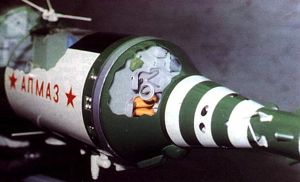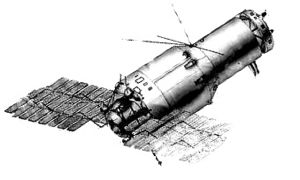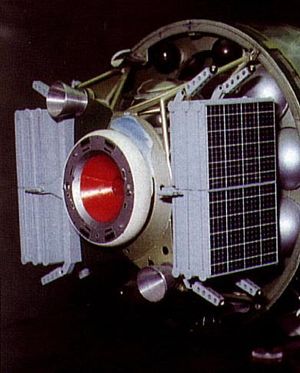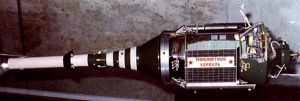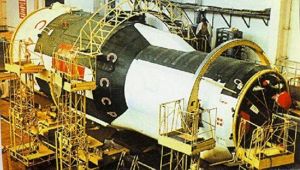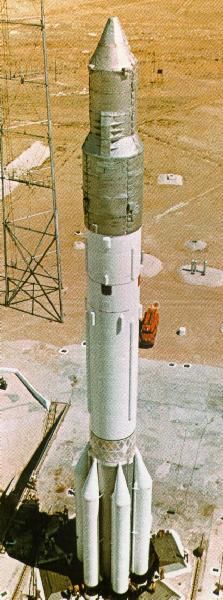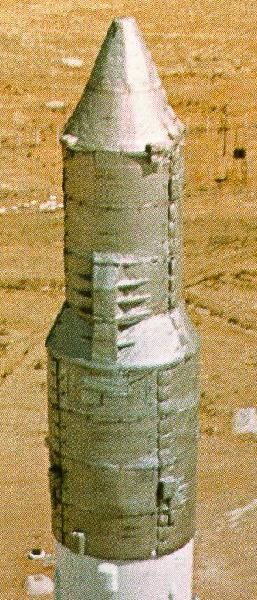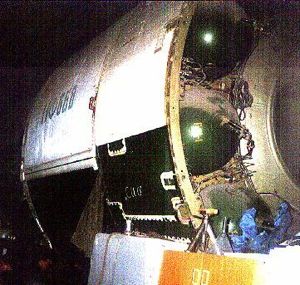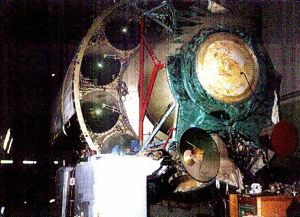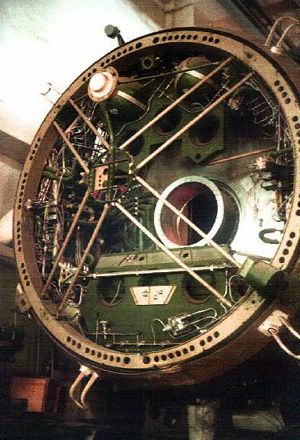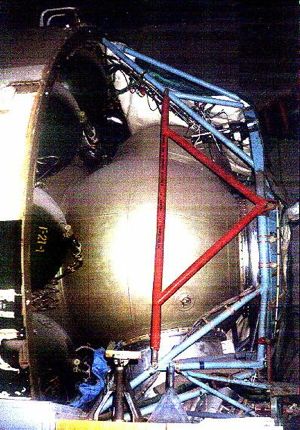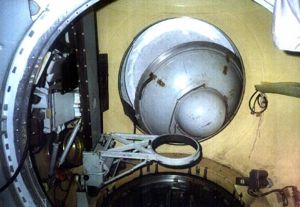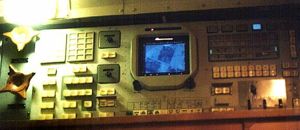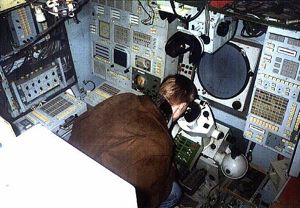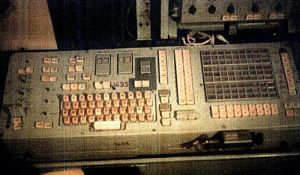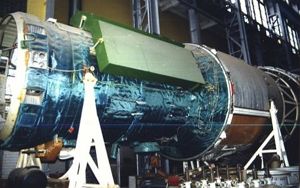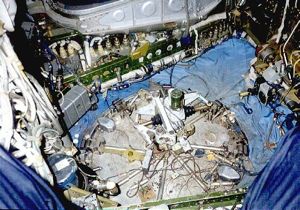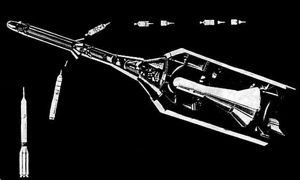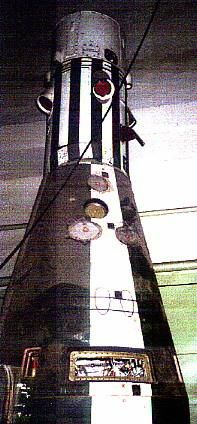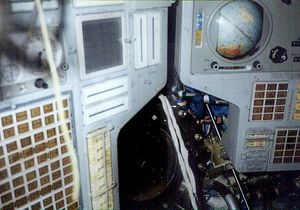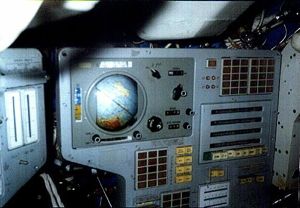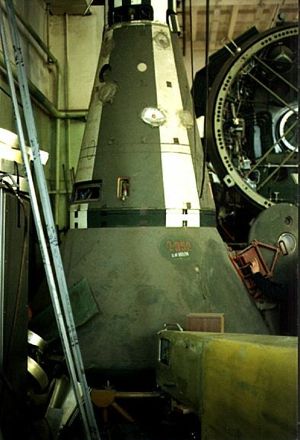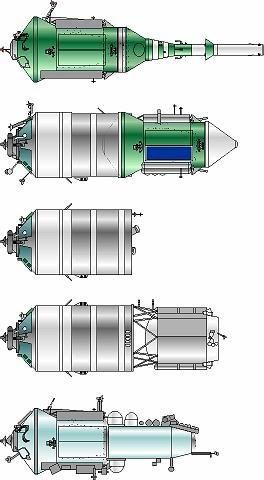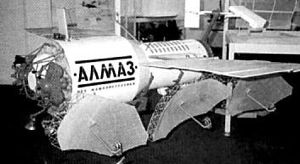
Home - Search - Browse - Alphabetic Index: 0- 1- 2- 3- 4- 5- 6- 7- 8- 9
A- B- C- D- E- F- G- H- I- J- K- L- M- N- O- P- Q- R- S- T- U- V- W- X- Y- Z
Almaz

Almaz History
The changing configurations of the Almaz military space station throughout its long year history. The planned TKS ferry was replaced by the Soyuz from 1966 to 1970. From 1970 on Soyuz would be used for Phase 1 flights while the TKS would be used for Phase 2 flights.
Credit: © Mark Wade
AKA: 11F71;Mech.
The initial Almaz program of 1965 consisted of two phases. In the first phase, 20 tonne Almaz APOS space stations, complete with crew and re-entry capsule, would be put in orbit by a single launch of a Proton rocket. In phase two, sustained operations would be conducted with Almaz OPS stations serviced by 20 tonne TKS manned resupply vehicles.
In 1966 this plan was revised. The first phase would now consist of the Almaz OPS stations, visited by crews launched separately aboard 6.5 tonne Soyuz transport vehicles. In this phase the value of manned space reconnaissance and targeting would be evaluated. In the second phase sustained operations would be conducted with Almaz dual-docking port stations serviced by TKS manned resupply vehicles.
Almaz flights were delayed in 1970 when resources were diverted to a crash program to upstage the American Skylab. Partially completed Almaz stations were outfitted as civilian Salyut space station. Almaz first phase flights finally took place in 1973-1977. Three Soyuz crews successfully visited two Almaz stations. Second phase flights of Almaz-2 stations and TKS were to be flown in 1981-1982. Unmanned flight tests of the TKS, its VA re-entry capsule, and construction of dual-port Almaz stations were completed, but Phase 2 was cancelled in 1979. The three TKS already built were instead flown unmanned to civilian Salyut space stations in 1981-1985.
The nearly-complete second phase Almaz stations were converted into automated man-tended Almaz-T reconnaissance platforms. These were to be launched and visited by Soyuz crews in the first half of the 1980's. The first station was ready in 1980 but launch was held up politically until 1986. By that time the decision was taken to make the Almaz-T fully automated and eliminate the manned flights. Following an initial launch failure two Almaz-T automated stations flew in 1987-1991.
A final automated derivative was to be the Almaz-1V civilian earth resources satellite. This was authorised in 1986 but the Soviet Union collapsed before it was built. Attempts in the 1990's to interest commercial customers in earth-resource derivatives of the Almaz and TKS were unsuccessful. However Almaz and TKS derivatives were used as the Zvezda and Zarya and modules of the International Space Station.
William Thackeray, Barry Lyndon
Competing Concepts
On December 10, 1963, US Secretary of Defence Robert McNamara announced the cancellation of the Dynasoar program, and the beginning of studies for a Manned Orbiting Laboratory (MOL) - a military space station. Within the Soviet Union, two space station projects were in the preliminary design state. At design bureau OKB-1, Chief Designer Sergei Korolev planned a huge 75 tonne OS space station for launch atop his N1 booster. Vladimir Nikolayevich Chelomei headed the competing OKB-52 design bureau and was Korolev’s arch-rival. He had received approval for development of his UR-500 booster with the backing of Nikita Khrushchev. One payload planned for the booster was the 12 tonne TAS Heavy Automated Station. A heavier manned derivative was envisioned for launch by a later upgraded version of the Proton. But these were longer-term projects and MOL represented an immediate challenge.
The initial response was authorisation for Chief Designer Dmitri Ilyich Kozlov at the Samara Filial of Korolev's bureau to begin design of Soyuz-R. The Soyuz-R system consisted of two separately launched spacecraft derived from the Soyuz design, with the docked complex having a total mass of 13 tonnes. The small orbital station 11F71 would be equipped with photo-reconnaissance and ELINT equipment. To dock with the station Samara developed the Soyuz 7K-TK 11F72 transport spacecraft. Soyuz-R was included by the Defence Ministry in the 1964-1969 five-year space reconnaissance plan, issued on 18 June 1964.
On 12 October 1964, only two days before the overthrow of Khrushchev, Chelomei obtained permission to begin development of a larger manned military space station, the Almaz. This 20 tonne station would take three cosmonauts to orbit in a single launch of his uprated UR-500K Proton rocket. Therefore there were now two competing projects for the same mission - Almaz and Soyuz-R.
Almaz - 1965 Concept
On 1 January 1965 the decision was formalised in the decree of the Central Committee of the Communist Party and Council of Soviet Ministers 'On work on space stations at OKB-52'. This defined Almaz as an OOS - Manned Orbital Station - in specific reply to the USAF Manned Orbiting Laboratory programme. Two phases of the project - RKK A (Rocket-spacecraft complex A, the entire system including the Proton UR-500K launch vehicle) and RKK B were planned. The decree authorised Chelomei to proceed immediately with build of the Almaz RKK 'A' version. Flight of the first Almaz RKK-A was set for 1968. The draft project for the RKK-B, with three crew, 1 to 2 year life, was to be completed by 21 June 1967.
The two phases were defined in detail as follows:
- RKK-A / APOS - Autonomous Piloted Orbital Station. The first station was a self-contained concept similar to the MOL, equipped with a VA re-entry capsule and a one to three month active life. The station section was designated OPS - Orbital Piloted Station. The OPS and VA were given the article numbers 11F71 and 11F74 (assigned the same article number, this clearly indicated the OPS was considered a replacement for the Soyuz-R station). Total mass was 15 tonnes for the OPS and 4.9 tonnes for the VA. Access to the station was via an airlock in the heat shield of the VA. No dockings would be required in this phase, which was planned to last for three years. Project-construction work was to be completed by the end of 1969 of a bare-bones station. This first OPS Almaz 0101-1 would have only 70 of the 300 systems planned for the full 'B' complex.
- RKK-B / OPS+TKS, with a one year active life. In this case crews would be rotated by the TKS ferry spacecraft to the OPS. Both the OPS and TKS would be equipped with VA re-entry capsules. Almaz OPS itself was to weigh 17.8 tonnes, with 100 cubic metres of total internal volume, while the TKS ferry came in at 17.5 tonnes and 45 cubic metres. The OPS and TKS were each equipped with a VA re-entry capsule, with a mass of 4.2 tonnes each. The complete complex provided a grand total of 89.4 cubic metres of habitable volume for six crew. The TKS had enough guidance, consumables, and electricity to dock dozens of times with the station. It could also manoeuvre independently. The VA capsules were designed for ten reuses. Almaz was designed to accomplish both scientific and military research.
All together RKK-B Almaz was designated the PRKK (Piloted Rocket Space Complex). It consisted of the OPS (Almaz), the TKS, the VA's, and KSI's (Special Information Capsules - small capsules for returning film and experiment results from orbit). Three to four dockings of the TKS would rotate crews and bring fresh supplies to the station. Phase B was to last 5 to 6 years. Systems planned for the station included the Agat photo-reconnaissance system; the R1-P sextant; the AI-ZR astro-tracker, plus BsVM, STR, SNIR, BIPS, Kashtan and Igla.
OKB-52 began development of the Almaz on a crash basis. 500 people worked on the control system and engines alone, with another 1000 on all other systems.
Changes in Plan - the Soyuz as Ferry to Almaz
Meanwhile the Soyuz-R advanced project was completed by Kozlov, but the Soyuz-derived station had become too heavy for the planned Soyuz launch vehicle. The perceived urgent need for manned test of military technology space led the leadership to authorise Kozlov to develop yet another military Soyuz, the single-launch Soyuz-VI. These directions were embodied in the Central Party resolution of 24 August 1965, which instructed Kozlov’s KB to fly a military research variant of the Soyuz 7K-OK by 1967.
It seems that weight growth during the course of 1965 also made the Chelomei single-launch APOS concept too heavy for launch by the Proton booster. In January 1966 Korolev died unexpectedly. OKB-1 was leaderless for nearly a year until his deputy, Vasiliy Pavlovich Mishin, was selected as his replacement. This was perceived as giving Chelomei an opening to kill Soyuz-R, although the final result was a compromise that pleased no one. On 30 June 1966 Ministry of General Machine Building (MOM) Decree 145ss 'On approval of the 7K-TK as transport for the Almaz station' was issued. It was decided that the 11F71 Soyuz-R space station would be cancelled and the Almaz OPS would be developed in its place. Almaz was assigned the index number previously allocated to the Soyuz-R station, and Kozlov was ordered to hand over to Chelomei all of the work completed in relation to the station. However Kozlov's Soyuz 7K-TK ferry was to continue in development to transport crew to the Almaz OPS, at least in Phase A of the project.
G A Yefremov escorted the Soyuz-R material from Kozlov's Samara plant to Chelomei's TsKBM organisation. The documents showed what a complex development was required to achieve the military's requirements. In Samara, work continued with release of the technical documentation of the 7K-TK. However due to delays in the Almaz all work on further development of the 7K-TK was suspended on 28 December 1966. These schedule changes were embodied in Military-Industrial Commission (VPK) Decree 104 'On changes in the timeline for the Almaz program and suspension of the 7K-TK'. This was supplemented on the same day with the VPK Resolution no. 305 'On approval of work on the 7K-VI Zvezda and course of work on Almaz' . This ordered Kozlov to undertake first flight of the manned military research spacecraft 7K-VI - 11F73 Zvezda by the end of 1967. The revised Almaz Phase A now consisted of launch of three OPS stations without VA re-entry capsules. Three two-month expeditions would be launched to each station aboard 7K-TK transports. Each station of the initial series was to have a life of three to four months.
Two decrees during the course of 1967 reinforced these decisions and set an aggressive schedule: initial flight tests of Almaz-A/Soyuz 7K-TK in 1968 and entry of the system into service in 1969. (these were Ministry of General Machine Building (MOM) Decree 'On approval of work on Almaz' was issued on 9 February 1967 and Central Committee of the Communist Party and Council of Soviet Ministers Decree 'On full approval of the Almaz and 7K-TK programs' on 1 June 1967).
On 21 June 1967 the Military-Industrial Commission (VPK) Decree 'On approval of the Almaz draft project' was issued, followed by Central Committee of the Communist Party and Council of Soviet Ministers Decree 'On schedule of work on the Almaz space station' on 14 August. The revised program seemed on track for an early test flight. Almaz program development was overseen by the State Committee for Flight Technology, P Dementiev, Chairman.
To complicate matters Mishin, the new head of Korolev's design bureau, managed to kill Kozlov's Soyuz-VI project in December 1967. In its place a Soyuz-derived OIS orbital station was proposed, which seemed very similar to the earlier Soyuz-R.
Chelomei's revised Almaz draft project was presented to the Fourth Trials Directorate at Baikonur Cosmodrome in January 1968. First launch did not now seem possible until 1969. Chelomei continued to have difficulty maintaining top-level support for Almaz as the project met delay after delay. While Khrushchev was in power, Chelomei was ascendant - Sergei Nikitovich, the Secretary General's son, worked at his firm. But Chelomei was not seen as an experienced politician and had belittled Council of Ministers Deputy Chairman Dmitri Ustinov. When Brezhnev took power, Ustinov became the Communist Party Central Committee Secretary for Defence. Chelomei's influence waned.
The official schedule for Almaz was held until 1969, when it became apparent that delays in subsystems deliveries would rule out any first flight until 1970. The mock-up of Almaz had been completed at Reutov in 1968 while production of station hulls was proceeding at Fili Factory 22. For Chelomei's ex-Myasischyev engineers, designing and building the structure of the station was trivial. Chertok asserted that Mishin's TsKBM could have done the same. However Almaz had a number of ambitious military and guidance systems that were desperately behind schedule. There was the large Agat camera which could be controlled in real-time by the cosmonauts and was capable of infrared detection. Using 'space binoculars' to determine if a target was clear and of interest, the entire array of sensors could be directed toward the target. Parts of the earth covered by cloud were examined using side-looking radar. All of this required high-precision guidance and orientation of the station. The station had to be pointed precisely for the target run while the panels remained oriented to the sun.
Chelomei developed the necessary complex guidance system within his own collective. His design bureau worked with the VNIIEM research institute on an electromechanical system of orientation using spherical gimbals and flywheels with great kinetic momentum (ancestors of the Mir’s 'gyrodynes'). These electrically-powered system could point the station with great precision without the expenditure of propellant.
Chelomei was also developing the Argon digital computer at the All-Union Institute of Digital Electronic Computer Technology (VNITsEVT). This computer was not in fact launched until 15 years later, for use aboard Mir! All of the technology for the Almaz station was similarly taking much longer than Chelomei expected. Therefore in the course of 1969 station spaceframes were being completed, but systems assembly had not even begun.
The DOS Program Civilian Space Station Threatens the Survival of Almaz
Other threats to the project's survival emerged. On 10 June 1969 President Nixon announced cancellation of the USAF MOL military space station program. The original impetus for development of Almaz was eliminated at a stroke. On 21 June 1969 the draft project for Mishin's OIS 11F730 military space station was issued jointly by TsKBEM and Kozlov's Filial 3. In the course of 1969 complete drawings were released for the OIS project including modules for the ferry spacecraft Soyuz 7K-S, 7K-S-I, and 7K-S-II.
On 3 July 1969 the second Soviet N1 lunar launch vehicle blew up on the pad. 17 days later, Neil Armstrong stepped onto the moon, winning the moon race for the Americans. The whole reason the existence of Mishin's design bureau's simply vanished. A new high-priority project was needed.
In terms of space stations, Mishin was thinking on a much larger scale then Chelomei. Korolev had begun development of a Multi-Module Space Base (MKBS) before 1966. Mishin put Vitali Bezverbom in charge of the project. MKBS would have been a space port, which would be visited by various spacecraft, primarily reconnaissance satellites, where film would be received. The film would be replenished, the spacecraft refuelled and preventive maintenance and repairs conducted. Such work would require well-qualified crews. A number of base stations in low earth orbit would extend the working life of spacecraft, which otherwise would have to be returned to earth or de-orbited into the ocean.
MKBS also accommodated ABM and ASAT weapons, including a neutral particle beam. This was being developed by Gersh Budker at Novosibirsk. He gave a lecture to OKB-1 staff on the subject of a neutral particle beam weapon. Enthusiasm for the concept was such that there was no impediment to the start of research on including the device in the MKBS. It would be housed in a separate module of the station, as would the photographic and radar reconnaissance systems.
However MKBS was to be launched by the N1; as long as this was not available, there would be no MKBS. Almaz on the other hand did not require a new launch vehicle, although the UR-500 was in a period of intense 'baby sickness'. So while TsKBEM was in a period of analysis and instability, Reutov and Fili were building space station for the Ministry of Defence.
On one of these August 1969 days, Raushenbach, Legostayev, and Bashkin came to Mishin's deputy Chertok with a plan to take an Almaz spaceframe, install Soyuz systems, add a new docking tunnel with a hatch to reach the interior, and presto - a space station was finished. It would weigh only 18 tonnes, could be launched by a Proton UR-500K, and could be ready in one year. A new ECS would be required, but Oleg Suguchev and Ilya Lavrov confirmed this would not be a problem - they could develop a new system in one year, using existing pumps and components. Chertok checked with Isayev if the Soyuz engine unit could be adapted to handle a spacecraft of three times the mass and was told this was not a problem. Tentative discussions with potential allies within Chelomei's design bureau found support there as well.
The DOS 'long-duration orbiting station' was the result of this 'conspiracy' - an alliance of engineers at Mishin's TsKBEM Filial 1 and Chelomei's TsKBM (V N Bugayskiy, Khrunichev ZIKh factory director M I Rishiteh). They had got to know each other on the forced collaboration of the two bureaux on the L1 manned circumlunar project. They managed to go around their two chief designers and have the concept presented by D F Ustinov to the Central Committee of the USSR for Military Issues.
Almaz was converted to the DOS configuration by :
- Adding an Exit Section (PKhO) with a passive Soyuz docking system and airlock to the front of the station;
- Adding an Engine Section (AO) adapted from that of Soyuz to the rear of the station;
- Mounting Soyuz solar panels (SB) on the PKhO and AO.
At the end of 1969 Chelomei's Khrunichev factory had built 8 Almaz test stand and two flight articles. A Special Contingent within Chelomei's design bureau was formed at the end of 1968 to conduct crew tests on the ground of the stations in phase one and to make flights to Almaz in the second phase. Three-man crews had already been formed. They would conduct real-time tests on the ground during the flight and advise the flight crew of any problems.
But Mishin was opposed to the concept - he wanted to pursue the MKBS. Afanasyev and his deputy were equally opposed, and Tyulin wouldn't support the idea either. None of them wanted to take the risk. The only chance was to get to Ustinov through Communist party channels. The opportunity came in October 1969 on the flight of engineers and management to Baikonur for the Soyuz 6/7/8 flight. Feoktistov had prepared a briefing which he presented to Ustinov.
In the euphoria after the return of the Soyuz crews, the problem was how to get Ustinov to meet further with the DOS 'conspirators'. Mishin had prohibited any meetings by TsKBEM staff with the Communist Party Secretary unless Mishin was also present. Another obstacle was that Feoktistov was not a party member; how could his presence at a party meeting be explained to Mishin later?
In any event this was simply ignored. Feoktistov was present at a party meeting with Keldysh, Afanasyev, Tyulin, Serbin, and the Ministry of Defence's party cell: Strogonov, Kravtsev, and Popov. Keldysh was mainly worried how the project would affect the N1, but was reassured that the N1 had a dedicated work force, and the L3 lunar lander spacecraft engineers and workers that would work on DOS were currently idle and had no part of that work. It was finally decided to go ahead with the DOS no earlier than January, to allow time for Ministry Decrees, approval of a work plan by the VPK, preparation of a decree for signature by the Central Committee of the Communist Party and the Soviet Ministers. Work began on the project in December 1969 under the initial auspices of the Academy of Sciences.
After the meeting, convinced of Ustinov's support, the 'conspirators' were left with just a year to build the station. Engineers immediately started switch from the dead-end L3 effort to DOS. Bushuev was worried that this only sealed the fate of the N1. It was in any case important that the matter be formalised quickly. Being discovered working on it would be an embarrassment.
The biggest new development required was the docking collar and hatch unit. Semenov (L1 manager, and later head of RKK Energia) was the obvious project leader - the L1 had only two flights to go and he had demonstrated on that project the ability to maintain good communications and relations with OKB-52 and Chelomei. But how did they know whether he would support the DOS concept?
The 'conspiracy' came out in the open on 6 December 1969 Afanasyev met with the Chief Designers - Pilyugin, Ryazanskiy, V Kuznetsov, and Chelomei's Deputy, Eydis. Mishin was 'sick' and Chelomei had sent his deputy, as usual, to avoid having to meet Mishin. Afanasyev started with the demand that an Almaz flight take place within less than two years, before the end of the Eighth Five Year Plan. He asked Eydis to install an Igla passive docking system to permit docking with the station of the existing Soyuz 7K-OK as opposed to the planned 7K-S. If Chelomei's bureau could not meet this requirement, then the 'conspirator's' DOS project could be authorised in its place.
An extensive discussion of the future course of the Soviet manned space program followed. Eydis pleaded that the Almaz program not be infringed upon. If an early station was desired, completion of an Almaz could be started on 1 January. The station would not have any military systems or ECS ready, but could be modified for docking with a 7K-OK. He noted that work on Almaz had been underway since 1965, all based on the requirements of the Ministry of Defence. TsUKOS and the General Staff wanted to conduct research in reconnaissance systems - infrared, wide-spectrum, high resolution, and television transmission. Their objectives went far beyond launch of a simple space station.
Throughout these discussions Afanasyev did not praise or criticise any of the speakers. Obviously he had to formally discuss the matter with Ustinov before any decision could be made. The decisive meeting came on 26 December 1969. Ustinov called the DOS 'conspirators' to Kuibyshev Street. Mishin was sent away to Kslovodsk and Chelomei and Glushko were not invited. No one wanted to listen to any more of Glushko's diatribes about Kuznetsov's engines.
Ustinov supported presentation of the DOS concept to the Central Committee. Chelomei categorically opposed DOS and was trying to kill it through military channels. But the allure of an '18 month' station - one which would not only beat the American Skylab, but be in space in time for the 24th Party Congress - seemed too alluring. Mishin also rejected DOS, but deputies at both design bureaux supported the concept and were eager to proceed.
DOS was therefore created only when the moon project failed. Chelomei was forced to work on DOS, and it severely impacted Almaz schedules. The Salyut name was later applied to both the DOS and Almaz stations, creating the impression in the outside world that they were built by one designer. This deception was a constant weight on the heart of the designers and workers who had to accept the compromise.
The official ministry decrees starting the DOS and reorganising the Almaz projects were issued in February 1970. The co-operative DOS crash program was to build a civilian space station to beat Skylab into orbit. The civilian station (later named Salyut) would use the Almaz spaceframe fitted out with Soyuz functional equipment. Mishin's OIS military station was cancelled and Chelomei's Almaz would continue, but as second priority to the civilian station. The Soyuz 7K-S station ferry, the 7K-ST, would be revised to be a more conservative modification of the Soyuz 7K-OK. The OIS cosmonaut group was to be incorporated into the Almaz group.:
The relevant Ministry of General Machine Building (MOM) Decree 105-41 'On creation of the DOS using Almaz as a basis' was issued on 9 February, followed by Decree 57ss 'On creation of the DOS using Almaz as a basis' on 16 February. The first station was to be completed within a year. On 15 February Ustinov had conferred with the Cabinet. They agreed that work would continue on both the lunar expedition and DOS. A formal declaration from Mishin and Chelomei to work together was required.
Almaz Survives and TKS is Authorised
On 5 May 1970 Smirnov and Afanasyev settled the future course of manned spaceflight at a DOS project review. Almaz and DOS would continue in the short term, but MKBS would follow in earth orbit. Mishin's attempt to replace Almaz with his DOS-A design was defeated.
With this support Chelomei was able to obtain a formal go-ahead for development of the TKS ferry. On 16 June 1970 Decree 437-160 'On creation of the TKS and termination of the 7K-TK' was issued. The decree scheduled the first Almaz Phase 1 flights for 30 June 1972 and 2 October 1972. The crews to these phase 1 stations would be ferried by the Soyuz 7K-TK already in development. However for phase 2 the 11F72 Soyuz 7K-TK would be replaced by Chelomei’s own transport-supply spacecraft 11F72 TKS. This would consist of the 11F74 VA landing capsule (designed for the original one-launch Almaz station design), together with a new 11F77 functional-cargo block (FGB). The TKS would transport three crew and sufficient supplies for 90 days operation of the Almaz. TKS design was to be completed in fourth quarter 1972.
In parallel with DOS work Khrunichev started static, vibration, and thermal tests of the Almaz. In the second half of 1971 the first phase station design was changed from three crew to two crew. This was due to a reduction in crew size of the Soyuz 7K-T ferry crew seize after the death of the Soyuz 11 crew.
Design work began on the TKS had actually begun in 1969. To assure reliability all systems were qualification tested on dynamic, static, heat, and flammability test stands. These included complete ECS, docking, rendezvous, and electrical analogue system tests. At Zagorsk test stands were built for the payloads, engine tests, and vacuum trials. At Chkalovsk ECS and thermo-regulation system trial were conducted. Full scale stand was built for testing of the docking system as well as a full scale VA.
The Almaz DU engine unit was based on Polyot technology by Section 08-08, headed by Sergei Vladimirovich Yefimov. Development was very difficult, and when the time came for the first launch the State Commission wouldn't clear the spacecraft for launch because the engine system had not completed its test series at Zagorsk. Only when Chelomei threatened to take the matter to the Politburo was permission granted. The reliability of the system was ultimately proven on Almaz 305, which completed 760,000 engine firings.
The DU was controlled by 30 pressure data sensors and 60 temperature sensors. Dozens of radio commands were required to monitor, close, and open various elements of the system for each firing. Prior to flight the system was subjected to static, vibration, thermal vacuum, cold-soak, and flammability tests. Vibrations tests were conducted of the whole system fuelled. These took many months.
In assembly at the factory one tube was incorrectly assembled. Afanasyev and Chelomei went to the factory, and instructed that ten duplicate articles be tested in vibration and fire. These conclusively showed the incorrectly assembled element would not affect the system function. These tests included the first test of the DU in a vacuum chamber, where corrosion problems were studied in detail. Reliability, reliability was the constant refrain. Once it appeared that there was fire aboard the station; but it turned out only to be a sensor failure.
Meanwhile work on the DOS station began in February 1970 using Almaz s/n 121 and 122. The first station was shipped in February 1971 to Baikonur, where work continued to complete it day and night without break. The station was launched on 19 April 1971 as Salyut 1. The triumph turned to tragedy when the Soyuz-11 crew died due to de-pressurisation of their re-entry capsule during return to the earth after completion of a 21 day mission aboard the station.
Collaboration of the two chief designers did lead to some agreements, although these were contrary to government decrees. Chelomei was anxious to develop Almaz while Mishin wished to move on with the N1 booster to MKBS and the moon. On 3 February 1972 Mishin and Chelomei sent a joint letter to Afanasyev. They proposed that Almaz would take over the DOS role as a civilian station after the four DOS-1's had been launched. Faced for once with a show of unanimity, Afanasyev rejected the plan. He replied that under no circumstances was Almaz to be used for scientific research. On the other hand, DOS would require substantial rework to be capable of military research. Therefore, the designers were to keep to original plan:
- Complete build of 4 DOS-1 as per Decree of Central Committee and Soviet Ministers #105-41 of 9 February 1970
- Continue scientific research on DOS only
- Almaz to be resupplied by the Soyuz 7K-T developed for DOS, to be followed by the Soyuz 7K-S, developed to the TTZ specification of the Ministry of Defence
- For flight trials of the MKBS, to return from the MOK large station, use the TKS of Almaz, developed according tot he decree 437-160 of 16 June 1970
- Apollo to dock with Soyuz-M 7K-M as per decree of 14 July 1972.
Salyut 2 - Almaz Phase 1 Flight Tests Begin
Meanwhile progress toward completion of the first flight Almaz was accelerating. Initial equipment to be qualified were the STR Thermo-regulation System and SNIP Pressurisation Control System. These had to be tied into the ECS and installed in phase 1 article 4, s/n 64688, as well as the 'docked' 7K-T mock-up. For these trials two cosmonaut crews rotated shifts over a 90 day stand test. This was completed on 21 April 1972.
By June 15, 1972 the first Almaz was reaching a high level of completion and firm flight schedules could be finally be established. These were contained in Ministry of General Machine Building (MOM) Decree 'On schedule of work for the Almaz and TKS programs'. On 29 July a Proton rocket failed to place the second DOS station into orbit. Brezhnev then personally selected Almaz for the next space station launch. There was just enough time to beat the scheduled to beat the American Skylab station, scheduled for launch in April 1973. OPS-1 / Salyut 2 was delivered to Baikonur in January 1973. The first ten day flight trials of the first OPS were planned for March 1973.
Equipment delays continued to plague the project. Chelomei wrote a letter to S A Smirnov on 28 September 1972 noting systems that still needed to be delivered:
- Agat-1 + Film Camera from 16 SPKM - due 29 September 1972
- Star tracker AI-3P and Sextant P-IP by TsKB Geofizika due 15 October 1972
- Slide projector 118K by TsKB Geofizika due 15 October 1972
- VIPS-R, due 15 October 1972
Chelomei wrote to the Central Committee on 16 October 1972 and listed equipment still undelivered:
- From the Electronics Ministry: 11M02 Chemical data distributor, BKIR, BKIR-T power distribution units. 11V030 special logic unit and 11V0929
- From Ministry of Radio Industry: 11R91 Kashtan time synchroniser, 11M66 Argon digital computer
- From from Arsenal KB: 11V027 RI-P sextant and 11V028 AI-3R star tracker
On 21 November 1972 Chelomei was notified that launch would be delayed due to aircraft trials of a revised backup parachute system for the Soyuz 7K-T ferry. It was commonly believed that Mishin was intentionally delaying these tests to make Chelomei miss his schedule. The Soyuz 7K-T 11615A-8 differed in detailed equipment from the Soyuz 7K-T 11615 model used to dock with the civilian DOS stations. This included control panels for operation of Almaz electrical systems by remote control from aboard the Soyuz.
Almaz 0101-1 was delivered to Baikonur on 15 December 1972. The flight trials State Commission was established by the decree 888-303 of 27 December 1972 and was headed by Deputy Commander of the RVSN rocket forces, Col-Gen M A Grigoriev. Trials of the OPS were conducted at Chelomei’s Area 92-2 (laboratory bunker area), with electrical and integration tests at Area 92-1 (Proton MIK), prior to joining the station to the rocket. The station was also moved to Mishin’s MIK KO and MIK at Area 2B and 2 for fitting of the Igla rendezvous equipment, vacuum trials and fit checks with the Soyuz 7K-T. Full-up system tests of Almaz began in January 1973. Fuelling of the station were done back at Chelomei’s Area 91 at the 91-2 and ZNS 11G141 propellant facilities.
Preparation of Almaz for flight met fully all military requirements for radio maskirovka deception operations. The ground-based analogue OPS , 11F71-100, was readied for use by a parallel crew to mime the flight activities of Salyut 2.
Chelomei was so enraged with Mishin's delays in qualifying the Soyuz and its marginal technical characteristics that he sent a letter to the Soviet leadership on 28 February 1973. In this he complained:
- Soyuz 7K-T could not be used with Almaz because Mishin did not act according to the requirements of the decree
- The 7K-T did not have the propulsive capability for multiple docking attempts with Almaz
- The 7K-T did not have the docking equipment and necessary backups systems to guarantee crew safety in all flight modes
- The 7K-T electrical system did not have the capability to provide full function unless recharged by the OPS for 2 to 3 days after docking.
Therefore he recommended that Almaz should be unmanned (!) for Phase I flights until the TKS was available.
Chelomei's recommendations was not taken up, but it appears that Mishin did respond to pressure on the re-qualification of the Soyuz parachute system. Almaz was ready for launch on 1 March 1973 but planned launches on 5 , 15, and 25 March were scrubbed due to Mishin's Soyuz not being ready.
Almaz 0101-1 finally entered orbit under the cover name Salyut 2 on 3 April 1973. The first 12 days of operation were normal. Two orbital corrections were made, and the Agat camera and ASA-34 topographical/star camera were operated successfully. But before a crew could be launched the station was lost. At 12:30 Moscow time on 14 April the station moved out of tracking range. When it returned at 03:16 telemetry showed the station had de-pressurised. On 16 April at 09:12 radio communications with the station ceased.
At first the station loss was attributed to a short in electrical equipment started a fire in pressure vessel, leading to rupture of hull and de-pressurisation. This would be consistent with the fire in Salyut 1. But study of telemetry later showed that the cause was a hole in the nitrogen tank of the engine unit pressurisation system. This prevented operation of the low thrust stabilisation engines and elevated temperatures in the bay, causing loss of proper radio telemetry, de-pressurisation, and then loss of main engines. It was theorised that debris from an explosion of the third stage of the Proton booster may have penetrated the nitrogen tank. Officially it was reported that control was lost on April 25, 1973, and the OPS ceased operations on 29 April.
The same day that communications were lost with Salyut-2 the American Skylab station was rolled out to the pad. It was launched a month later and the Soviet Union lost the chance to conduct the first fully successful space station mission. Salyut 2 decayed from orbit and re-entered on 28 May 1973 in the Pacific Ocean 3000 km east of New Guinea..
Had the station continued in operation, it would have been manned by two crews: Artyukhin and Popovich aboard Soyuz 12 (back-ups Volynov, Zholobov), followed by Demin and Sarafanov (backups Rozhdestvensky and Zudov) aboard Soyuz 13.
DOS Ascendant Again - TKS VA Capsule Development Plans Changed
Following three successful Skylab missions came the shocking news that Mishin had been authorised to build a new-design fifth DOS station using Almaz facilities. Chelomei wrote a bitter letter to Afanasyev on 28 December 1973. He noted that the K-00534 TTT requirements for Almaz of the Ministry of Defence envisioned a two phase program. Instead his Khrunichev ZIKh factory was hijacked for DOS production. Now it had been further assigned to build DOS-5 for Mishin. Therefore, he concluded that the first phase of Almaz could not be completed. He asked Afanasyev how to resolve this situation.
It was clear that the phased development plan for Almaz was wrecked. Therefore a decision had to be made as to how to develop the VA re-entry capsule for Almaz-2 and TKS. V A Ozertskovskiy, head of section test, defined the generic parameters for VA development. Flight trials would be necessary to develop the SAS abort system to pull the VA away from the Proton rocket in case of an emergency situation. Therefore it was suggested that one Proton launch would handle two VA's in the 82LB72 configuration. This plan was approved in 1974. Two VA's were enclosed in a cylindrical housing called the LVI. The external geometry of the 82LB2 was exactly the same as the TKS' FGB+VA. Originally two launches of two pairs of capsules were planned: VA#030 (technology article) with analogue #009 in 1975, to be followed by VA 009A with SAS and 009 analogue inside the shroud in 1976.
Fifty articles of the VA were built for development, including articles for development test stands, hatch tests, static test, and drop test, static and dynamic test, medical article #004, and those for development of the ADU rocket unit of the SAS abort system. From 1974-1977 five launches were undertaken from area 51 at Baikonur of the SAS system (three using VA #005, two using VA #007). These were attached to a complete mock-up of the FGB including the hatch tunnel and connector umbilical. When the 'Abort' command was sent, the 86 tonne thrust motor of the ADU pulled the VA capsule away from the pad. 10 seconds from the abort command the ADU/TUD/NO separated and the landing systems went into operation. The braking parachute deployed for seven seconds, followed by the main chute with 1770 square meters of area. The capsule made a soft landing 2 km away. All five tests went well.
Salyut 3 - Almaz is the First Successful Soviet Manned Space Station
Meanwhile the second Almaz was launched as Salyut 3 on 25 June 1974. Following the successful Soyuz 14 and unsuccessful Soyuz 15 missions, on 23 September 1974 the station ejected a KSI film return capsule, which was recovered damaged but with the film intact. On 25 January 1975 Salyut 3 fired its manoeuvring engines for the last time and braked itself from orbit over the Pacific Ocean.
The station had a planned life of eight months and had the special objective of locating and transmitting to the ground the co-ordinates of mobile objects at sea and in the air. For this purpose 14 type of photo cameras, and various optical sensors (pointing scope, panoramic viewer, periscope) were carried as well as infrared sensors. Semi-active radar (SAR) was not flown but was planned in the future. Salyut 3 was equipped with the Agat-1 camera, which had a 6.375 m focal length using 3 m folding optics, an OD-4 Vzor pointing scope, POU panoramic camera, as well as topographic and star cameras. In addition its Volga infrared apparatus had a 100 m resolution. The Vzor OD-4 could sight an object at sea, then train all of the sensors on that object. Skylab was visually hunted by the station using the Sokol instrument, demonstrating use of the sensor array in space-to-space warfare and reconnaissance.
Of the 17 orbits per day the station would fly, seven did not pass over the USSR and were useless for communication. To fill the gap two tracking ships were used for Salyut 3. The vessel Cosmonaut Yuri Gagarin was stationed off Sable Island in the Atlantic, at 51 deg N, which provided 5 to 6 orbit per day coverage. The ship Cosmonaut Vladimir Komarov was stationed off Cuba, at 21 deg N, and provided coverage on 2 orbits. The result was communications opportunities on every orbit.
On 4 July 1974 Soyuz 14 docked with the Salyut 3 space station after 15 revolutions of the earth and began the first military space station mission. The planned experimental program included manned military reconnaissance of the earth's surface, assessing the fundamental value of such observations, and some supplemental medico-biological research. All objectives were successfully completed and the spacecraft was recovered on July 19, 1974 at 12:21 GMT, landing within 2 km of the aim point 140 km SE Dzhezkazgan. After the crew's return research continued in the development of the on-board systems and the principles of remote control of such a station.
In August 1974 Soyuz 15 was to conduct the second phase of manned operations aboard Salyut 3, but the Igla rendezvous system failed and no docking was made. As Chelomei had complained, Soyuz had no reserves or backup systems for repeated manual docking attempts and had to be recovered after a two-day flight. The state commission found that the Igla docking system of the Soyuz needed serious modification. This could not be completed before Salyut 3 decayed. Therefore the planned Soyuz 16 spacecraft became excess to the program (it was later flown as Soyuz 20 to a civilian Salyut station, even though over its two year rated storage life).
The Salyut 3 KSI film capsule was ejected on 23 September 1974 but suffered damage to the landing sequencer from the hot plasma sheath generated during re-entry. Therefore the heat shield did not separate, nor did the main parachute open. The capsule was deformed by the hard landing but all the film was recoverable.
On 24 January 1975 trials of a special system aboard Salyut-3 were carried out with positive results at ranges from 3000 m to 500 m. These were undoubtedly the reported tests of the on-board 23 mm Nudelmann aircraft cannon (other sources say it was a Nudelmann NR-30 30 mm gun). Cosmonauts have confirmed that a target satellite was destroyed in the test.
The next day the station was commanded to retrofire to a destructive re-entry over the Pacific Ocean. Although only one of three planned crews managed to board the station, that crew did complete the first completely successful Soviet space station flight.
Almaz Phase 2 Development
Meanwhile Phase 2 of the Almaz project continued, with the Central Committee of the Communist Party and Council of Soviet Ministers Decree 476-13 'On course of work on Almaz and the TKS' being issued on 19 January 1976. Six full-up TKS flight spacecraft were originally planned, together with nine separate unpiloted launches of the VA capsule. Two unmanned TKS flights would be followed by four manned missions (later changed to five manned flights). The decree set forth the following program for completion of Almaz Phase 1 and Phase 2:
- First quarter 1976 - Unmanned flight tests of VA capsule
- Second quarter 1976 - Completion of draft project of OPS with two docking ports for service by rotating crews
- End 1976 - Unmanned flight tests of TKS
- End 1977 - End of Phase 1 with flight of OPS-3
- End 1977 - First flight test of OPS-4 with two docking ports with return capsule on front port
- End 1978 - Manned TKS flights
- End 1980 - Acceptance into service of OPS/TKS/VA systems
However soon after this decree was issued Marshal Grechko suffered a heart attack. With this Chelomei lost his most active patron and was unable to withstand the slow strangulation of his projects by Ustinov and Glushko.
VA capsules would be tested two at a time in the special 82LB72 Proton booster configuration. The original two-launch program had been expanded to five launches of two capsules in the LVI housing. The last two launches in 1978 were to be manned. The plan was:
| Planned Date | Planned VA numbers/Mission | Actual Result |
| Nov 1976 | 009A and 009 | Cosmos 881 / 882 |
| 2nd Qtr 1977 | 009 and 009A | LV exploded |
| 4th Qtr 1977 | 102A and 102 | Cosmos 997 / 998 |
| 1978 | 008A manned / 103 | LV shutdown; LES fired. Unmanned |
| 1978 | 103A manned and dummy mass | Cosmos 1100/1001 unmanned |
The VA capsule had a hypersonic lift to drag ratio of 0.25, allowing it to generate lift during re-entry. This allowed the BSU-V manned capsule guidance system to manoeuvre the spacecraft to its landing point using the optimum path for minimal heating and G-forces. The reusable heat shield material developed for the VA was far superior to that used on the Soyuz capsule and was used as well on Chelomei’s K-1 and LKS manned spacecraft designs. The SAS system abort system for the VA separated the capsule with 15 G's of acceleration from the booster in case of a malfunction and soft landed the capsule 1.0-1.5 km from the launch pad. In the lab the 92-2 LVI mock-up was used to test automatic systems, conduct trials tests, use of the TDU engine at the centre of mass, hermetic sealing of the LVI section, and separation of the DU.
Salyut 5 - Completion of Almaz Phase 1
The second successful Almaz phase 1 flight, Salyut 5, was launched on 22 June 1976. It had taken only 60 days and 1450 man-hours to prepare Almaz 0101-2 for flight, using the services of 368 officers and 337 non-commissioned officers. The station operated for 409 days, during which the crews of Soyuz 22 and 24 visited the station. The tracking ships Academician Sergei Korolev and Cosmonaut Yuri Gagarin were stationed in the Atlantic and Caribbean to provide communications when out of tracking range of the USSR.
Soyuz 23 was to have docked but its long-distance rendezvous system failed. Soyuz 25 was planned, but the mission would have been incomplete due to low orientation fuel on Salyut 5, so it was cancelled. The film capsule was recovered 22 February 1977 (and sold at Sotheby's, New York, on December 11, 1993!). The station was deorbited on 8 August 1977.
Soyuz 21 with Volynov and Zholobov aboard hard-docked with the station on 6 July 1976 after failure of the Igla system at the last stage of rendezvous. Towards end of the two month mission an early return to earth was requested due to the poor condition of flight engineer Zholobov (who was suffering from space sickness and psychological problems). The crew landed in very bad physical and mental condition 200 km SW of Kokchetav on August 25, 1976 at 18:33 GMT. It was determined that they had become emotional, not followed their physical training, and developed an unreasonable desire to return to earth. The possibility also existed that there were toxic gases in the station.
The hard-luck flights continued with Soyuz 23 on 14 October 1976. The ferry spacecraft, with Rozhdestvensky and Zudov aboard, suffered a docking system failure. Sensors indicated an incorrect lateral velocity, causing unnecessary firing of the thrusters during rendezvous. The automatic system was turned off, but no fuel remained for a manual docking by the crew of . The capsule landed in Lake Tengiz in -20 deg C conditions in a snowstorm. The wet parachute filled and dragged the capsule below the surface, cooling the capsule. Heating systems had to be turned in the capsule to conserve battery power. Amphibious vehicles attempted to recover the spacecraft but could not reach it. Finally swimmers managed to attach a cable to a helicopter. The capsule was dragged for kilometres across the icy sea. Only in the morning was the crew able to emerge from the capsule. The recovery crews were surprised they were still alive.
Soyuz 24 brought repair equipment and equipment for a change of cabin atmosphere. This special apparatus was designed to allow the entire station to be vented through the EVA airlock. Because of this the planned EVA was cancelled. However analysis after arrival showed no toxins in the air. The crew changed the cabin air anyway, then returned to earth. The mission, although a short 18 days, was characterised as busy and successful mission, accomplishing nearly as much as the earlier Soyuz 21's 50 day mission. The Soyuz was recovered February 25, 1977 9:38 GMT 37 km NE Arkalyk. The KSI film return capsule followed them a day later and was recovered successfully. It was sold at Sotheby's in 1993 and is now in the US National Air and Space Museum.
As on Salyut 3, during the flight of Salyut 5 a 'parallel crew' was aboard a duplicate station on the ground. They conducted the same operations in support of over 300 astrophysical, geophysical, technological, and medical/biological experiments. Astrophysics studies included an infrared telescope-spectrometer in the 2-15 micrometer range which also obtained solar spectra. Earth resources studies were conducted as well as Kristall, Potok, Diffuziya, Sfera, and Reatsiya technology experiments. Presumably Salyut 5 was equipped with a SAR side-looking radar for reconnaissance of land and sea targets even through cloud cover.
A third crew was to be launched to the station aboard Soyuz 25 but the flight was cancelled. It seemed that propellant reserves aboard the station had dipped too low to support another mission; in the opinion of Glushko (Mishin's successor). He therefore refused to ready another Soyuz for the mission. The spacecraft allocated for Soyuz-25 flew as Soyuz 30 to a civilian Salyut station.
This marked the end of Almaz Phase 1 and a state commission reviewed the results. The P-100 antenna demonstrated radio communications and photo television transmission of information to within 4 deg of the horizon (7 deg specification) at ranges of up to 1500 km . Photographic resolution was 15 to 20 lines/mm. The Pechora-1 television imagery transmission system worked well. All communications demonstrated, including: relay of data via Molniya-1 satellite when the station was out of sight of the USSR; automated processing of telemetry; and clear television downlink to the TsUP ground control centre and Ostankino tracking centre. Stage 1 trials were therefore declared to be successfully completed and decrees 46-13 of 19 January 1976 and 534-165 of 27 July 1996 allowed long-term use of station to proceed. Articles 104 and 105 released for use as production Almaz-2 stations.
However the overall results of the Salyut 3 and 5 flights were said to have demonstrated to the Soviet military that manned reconnaissance was not worth the expense. There was minimal time to operate the equipment after the crew took the necessary time for maintenance of station housekeeping and environmental control systems. The experiments themselves showed good results and especially the value of reconnaissance of the same location in many different spectral bands and parts of the electromagnetic spectrum. However this technology could best be exploited on unmanned satellites.
Almaz Phase 2 Tests Begin
10 December 1976 the first Proton 82LB72 VA test vehicle was placed on the pad. The VA capsules included the Probki radioactive sensor system within the Kaktus gamma ray altimeter, which set off the DU braking unit for a soft landing of the capsule. In place of space suits telemetry equipment was installed.
Launch of mission LVI-1 came at 04:00 on 15 December. At 176 seconds the ADU escape tower separated from the LVI. Once the final stage had shut down in orbit, by command from the launch vehicle sequencer, the VA 009A (also given as 009P) and its TDU separated from the LVI. Two seconds later VA 009 (or 009L) was ejected. Fifteen minutes after launch all systems of the both VA capsules were in operation. The guidance system detected the direction of flight and oriented each spacecraft for retro-fire, and the pair began the return to earth after less than one revolution. At an external atmospheric pressure of 165 mm (10 km altitude) the NO section jettisoned, the three-cupola drogue parachute ejected, and the antennae and altimeter were deployed. The Komara landing radio beacon (installed on the landing section of the parachute) was activated when the spacecraft was 1.0 to 1.5 m above the ground - which occurred at the same moment on both 009 and 009A. The Kaktus special system tripped the soft landing PRSP (parachute landing propulsion system). The soft landing was accomplished with higher accuracy than Soyuz, both capsules being recovered at 44 deg N, 73 deg E, on December 15, 1976 3:00 GMT. The flights were officially given the designations Cosmos 881 (VA 009A) and Cosmos 882 (VA 009). US intelligence believed them to be tests of recoverable manned spaceplane prototypes.
While the tests of the VA were behind schedule, the first complete TKS was delivered to Baikonur at the beginning of 1977 and launched on 17 July 1977 as Cosmos 929. The TKS manoeuvred extensively, making orbital altitude changes equivalent to a total of nearly 300 m/s of delta V. The VA capsule (serial number given as 009) returned to earth August 16, 1977. The FGB of the TKS remained in controlled flight until it was deorbited on February 2, 1978 after 201 days aloft.
The next LVI-2 VA test came a month later, on 2 August. A repeat test of the VA capsules from LVI-1 were atop the Proton (VA's 009P and 009L). However the booster failed at 49 seconds after launch. The SAS launch escape system pulled the top capsule (009P) away from the exploding Proton rocket and it was successfully recovered. The lower capsule was lost with the booster.:
Given the circumstances the plans to crew the upper VA in the next test was abandoned. LVI-3 (VA's 102P and 102L / Cosmos 997 and Cosmos 998) was launched unmanned four months behind the original schedule on 30 March 1978. Both capsules were recovered after one orbit. One source indicates that one of the capsules was 009P, on its third launch and second flight to orbit. This was said to have demonstrated the multiple re-entry capability of the heat shield and the first planned reuse of a spacecraft (Gemini 2 was refurbished and reflown as MOL-1 in the 1960's, but was not designed for that purpose).
On 15 August 1978 a VA integrity test was conducted at the large vacuum chamber at Monino with cosmonaut Sergei Vladimirovich Chelomei (son of the chief designer) suited in the capsule. At the beginning of the test a valve opened in his helmet. His suit protracted him from a deep vacuum as designed by pumping oxygen at a high rate to match the loss through the helmet. Although the chamber was repressurised barely in time, Chelomei survived the incident.
On 20 April 1979 LVI-4 VA (VA s/n 103 and s/n 008) was awaiting launch. The booster ignited, but then shut down on the pad. This triggered the launch escape system, which pulled the top capsule away from the booster. The parachute system failed and the capsule crashed to the ground. The lower capsule remained in the rocket. The top capsule was to have been manned, but the inability to demonstrate two consecutive failure-free launches of the Proton/TKS-VA combination made that (luckily) impossible.:
The launch vehicle was undamaged, and just a month later, with a switch of payload, LVI-4 was orbited as Cosmos 1100 and 1101 on 23 May 1979. The pair launched were the 102P/102L twins from LVI-3. One capsule failed when the automatic system suffered an electrical distribution failure and it did not land correctly, spending two orbits in space, while the other landed as planned after one orbit. The launch again successfully demonstrated the reusability of the VA capsule.
Almaz Phase 2 Cancelled
Chelomei felt that development of the TKS was given second priority to construction of additional DOS civilian stations by V Bugaiskiy (chief designer of NPO Mashinostroyeniya's Branch Number 1 in Fili, responsible for the FGB module). The Fili branch had developed close ties with NPO Energia and as a result of their collaboration on the DOS programme. It was only after Bugaiskiy's replacement by D Polukhin that the TKS programme was accelerated. But the damage had been done - by the time Almaz 104 would be ready for launch the TKS would still not be man-rated.
Almaz OPS-4 was originally to be built with a single docking port for the TKS. The first TKS launched to the station would also have carried life support systems that were deleted from the station, allowing the Almaz to be fitted with its own VA return capsule. The lack of a guaranteed man-rated TKS to support the planned OPS-4 flight date resulted in a last-minute revision to the station. The station would have to be capable of being supported initially by crews transported in the existing Soyuz spacecraft. Therefore the VA return capsule was deleted from OPS-4 and in its place a Soyuz docking port was built. OPS 104 would be launched with a Soyuz docking port forward and a TKS docking port aft.
But at the beginning of 1978 project funding was cut back and the first launch further delayed, meaning a crewed TKS could make the first flight after all. In December 1978 four TsKBM cosmonaut engineers were selected and began training for missions to Almaz OPS-4.
The final revised flight plan for Almaz OPS-4 was as follows:
- December 1980: Launch of Almaz-2 OPS-4
- January 1981: TKS-1: Planned first manned flight of the TKS. Crew Berezovoi, Glazkov, Makrushin. Would have docked with the Almaz OPS-4 military space station, three month duration.
- April 1981: TKS-2: Second manned TKS flight to OPS-4, four month duration. Crew Kozelsky, Artyukhin, Romanov.
- August 1981: TKS-3: Third TKS flight to OPS-4 military space station, crew Sarafanov, Preobrazhensky, Yuyukov.
- April 1982: Soyuz Almaz 4: Soyuz flight to dock with the Almaz OPS 4 space station, crew Malyshev, Laveykin.
This was the last iteration of the full-time manned Almaz program. At the end of 1978 it was decided to consolidate the Almaz and DOS projects into a single Mir space station. The existing partially-completed Almaz-2 spaceframes would be converted into man-tended automatic radar reconnaissance satellites. OPS-4 11F71 s/n 106 at that point was already in electrical tests preparatory to shipment to Baikonur. Instead it remained on the ground.
OPS-4 systems would have been similar to those of Salyut 3 and 5 (see Almaz OPS for full technical description), with the major addition of side-looking radar antennae for all weather observation of the earth’s surface and the major deletion of the Agat-1 reconnaissance camera. A range of military anti-satellite and anti-ballistic missile sensors, later flown aboard the TKS Cosmos 1686 to Salyut 7, were originally to have been ferried by TKS spacecraft to Almaz. These included an infrared telescope and the Ozon spectrometer. The TKS was also capable of refuelling the station, which required some changes to the Almaz engine system compared to the first generation models.
OPS-4 was to be equipped with the Mech-A side-looking radar. The large folded antenna array for this system was mounted on the forward cylinder of the station. The vast amounts of digital data generated by the radar would be transmitted to the ground directly or via relay satellites using the Biryuza data transmission system with the Aist antenna. The large Agat-1 optical reconnaissance system was deleted and OPS-2 was equipped only with the ASA-34 topographic camera to provide optical correlation of the ground areas imaged by the radar system. For self-defence against the American space shuttle OPS-4 was equipped with the Nudelman Shchit-2 space-to-space gun, an improved version of the weapon carried on the Almaz OPS-1 stations.
At the time of cancellation, design work had begun on OPS-5 (designated "Zvezda"), which would be equipped with docking ports for TKS vehicles at both ends of the station.
TKS Design Lives On - Almaz-T
An official resolution in February 1979 cancelled Almaz and the planned military experiments into the Mir project. Mir’s docking ports were to be reinforced to accommodate 20 tonne space station modules based on Chelomei's TKS manned ferry spacecraft in place of the lighter modules planned by Glushko. NPO Energia was made responsible for the overall space station, but subcontracted the work to Chelomei’s KB Salyut due to the press of in-house work. The subcontractor began work in the summer of 1979.
However Almaz was not completely dead. Work on an unmanned version of Almaz had already begun in 1976. The military research institute 50-TsNII-KS GUKOS conducted studies in 1976-1980 on the third generation of satellite systems., on a 10 to 15 year development cycle. Operations analysis had indicated that two automatic Almaz-T would be a necessary adjunct to Yantar and Tselina satellites. The final results of the studies were summarised in the reports 'Basic Direction of Military Space Unit Development to 1995' and 'Program for Military Space Units, 1981-1990'. Approval of these plans by the Central Committee and Soviet Ministers was issued on 2 June 1980. This covered the period through 1990 and included the Almaz-T multimode reconnaissance system. In 1981 Almaz-T was ready for flight trials, but Ustinov mothballed it. The Mech-K requirement included control of the station to within 1.5 minutes of azimuth, stabilisation of sensor to within 3 minutes of arc using gyrodynes, 10-15 g/rev, 500 kWt power.
Three automated Almaz-T were to be built from existing Almaz spaceframes (11F71-B, s/n 104 to 106; falsely designated Almaz-K or 11F667). These were given the Mech-K (Sword) code name.
Meanwhile it was still planned that two of the TKS would be flown manned to Salyut stations. In September/October 1979 three crews were formed for flights TKS-2 and TKS-3:
- TKS-2: Glazkov/Makrushin/Stepanov
- TKS-3: Sarafanov/Romanov/Preobrazhensky
- Backups: Artyukhin/Yuyukov/Berezovoi
On 20-28 November 1979 GKNII conduced state ground trials test of TKS using two crews. Many problems were uncovered requiring rework.
On April 25, 1981 TKS-1 was launched unmanned as Cosmos 1267. The VA capsule was recovered on 24 May 1981. The FGB docked with Salyut 6 on June 19 at 10:52 AM MT after 57 days of autonomous flight. It remained attached to Salyut 6 until they were both deorbited and destroyed on Salyut July 29, 1982.
Despite the success of Cosmos 1267, Ustinov was not finished with Chelomei. He cancelled the entire remaining Almaz program. A decree of 19 December 1981 halted further work on manned flights of the TKS and reoriented the flights as tests of modules for the Mir station. The TKS training group was dissolved. Work on Almaz-T was halted. Ustinov officially wanted Chelomei’s TsKBM to concentrate on ICBM development. Chelomei hid the three Almaz-T and OPS-4 space stations in a corner of his complex, labelling them as 'radioactive material'.
On 2 March 1983 TKS-2 was launched unmanned as Cosmos 1443. Aboard were 2700 kg of payload and 4000 kg of propellant. This time the VA remained attached and the TKS docked with just two days after launch. TKS-2 separated from Salyut 7 on 14 August. The VA re-entry capsule separated and the space station deorbited itself on September 19, 1983. The VA capsule continued in space for four more days, demonstrating autonomous flight, before successfully re-entering on 23 August 1983. It landed 100 km south-east of Arkalsk and returned 350 kg of material from the station.
Ustinov was old and losing his grip. Manned ‘flights’ of TKS were not completely dead. In 1982 a cosmonaut training group was formed again to fly the TKS and also to operate the military experiments aboard TKS-3 after it had docked with Salyut 7. These crews were:
- First Crew: Vasyutin, Savinykh, Volkov
- Second Crew: Aleksandrov, Saley, Viktorenko
- Backups: Solovyov, Serebrov, Moskalaneko.
Very quietly the Almaz-T project was resumed as well. It was planned that the man-tended spacecraft would be periodically visited for refuelling and repair by TKS or Soyuz and Progress spacecraft. Chelomei was finally forced to retire in October 1983. The bizarre deaths of Chelomei and Ustinov within days of each other in December 1984 opened the way for the program to be publicly resumed. A small group of cosmonauts was put into training for Soyuz flights to the man-tended Almaz-T.
Salyut 7 problems resulted in a complete breakdown of the TKS-3 plans. The first crew was bumped and instead a repair crew of Dzhanibekov and Savinykh was launched aboard Soyuz T-13 on 6 June 1985. The first ‘TKS’ crew was only completed with the launch to Salyut of Soyuz T-14 with Grechko, Vasyutin, and Volkov aboard on 17 September 1985. Grechko returned with Dzhanibekov aboard Soyuz T-13 on 26 September, clearing the aft port of Salyut for the TKS.
TKS-3 was launched unmanned as Cosmos 1686 on 27 September 1985. All VA landing systems, the ECS, seats, and manned controls had been removed and replaced with high-resolution photo apparatus and optical sensor experiments (infrared telescope and Ozon spectrometer) of the Ministry of Defence. The TKS successfully docked with Salyut 7 and remained with it for the rest of its life. For almost two months the crew of Vasyutin, Savinykh, and Volkov conducted military experiments. However Vasyutin became sick and the crew returned prematurely on 21 November 1985, leaving the station unmanned. Salyut 7 was moved to a higher orbit to await the second ‘TKS’ crew, but then control of the station was lost. There were plans to return it aboard Buran for inspection, but first flight of the spaceplane was delayed. Salyut 7 and Cosmos 1686 burned up in the atmosphere together in a fiery show over Argentina on February 7, 1991.
Almaz-T and Almaz-1V - the Last Gasp
Although Ustinov was dead, the Soviet military showed no interest in use of the Almaz-T. The Ministry of Defence was satisfied with the performance of its new electro-optical satellites. Finally the Academy of Sciences agreed to take the project over and use the first spacecraft on a science mission. A VPK decree of 12 April 1986 required Almaz 1V to be developed for international earth resources missions, including a 3 band sounder with 5 to 7 m resolution and a high-resolution scanning infrared system. The existing military Almaz-T’s would be flown as prototypes of this design.
In the second half of 1986 the first Almaz-T s/n 303 was readied for launch. General V V Favorskiy ordered it to be completed and launched with a full-up lab module in place of trials equipment. Unfortunately the Proton second stage exploded on the way to orbit on 29 November 1986.
At the beginning of 1987 it was decided not to man the Almaz-T, instead operate it in a fully automatic mode. Thus was the final Almaz cosmonaut training group disbanded.
Almaz 304 was finally launched on 25 July 1987 as Cosmos 1187. Its side-looking radar had a 20-25 m ground resolution and functioned throughout its two year service life.
Almaz 305 flew as Almaz 1 on March 31, 1991. This was the first launch of the station in post-Soviet times and the first time under its real name. :The station returned images of 10 to 15 meter resolution through 17 October 1992. The spacecraft surveyed the territory of the Soviet Union and of other countries for purposes of geology, cartography, oceanography, ecology and agriculture, and study of the ice situation at high latitudes. Almaz-1 had a 10-15 m radar ground resolution, a 10 to 30 km radiometer resolution over a 600 km swath, and an 18 month service life. Its engines completed 760,000 engine firings during that time.
With the collapse of the Soviet Union, funding for the full-up Almaz-1V commercial version dried up. Attempts to interest foreign investors in the planned second generation of Almaz-1V were unsuccessful.
Thus, with a whimper, ended a 25 year program.
Almaz-1 Technical Description
The Almaz station consisted of (from fore to aft): a 2.9 m diameter smaller diameter pressurised cylindrical section (2.9 m diameter x 3.8 m long), a conical 1.2 m long transition section, a large 4.15 m diameter x 4.1 m long cylindrical section, and a globular airlock section, with a total pressurised volume of 92.4 cu. m. The compartments of the station were, from fore to aft:
- In some variants that never flew, the VA re-entry capsule, with couches for a crew of three, and a hatch in the heat shield through which the station could be accessed
- In the variants without the VA, a short cylindrical unpressurised transition section (1.0 m long x 2.9 m diameter). Some orientation rocket engines were arranged around the periphery of this transition section. Deployable structures form extending from the top of the section formed a plume shield around each engine cluster.
- A 2.9 m diameter x 3.8 m long pressurised cylindrical section. Mounted on the outside of this section was the NR-23 self-defence gun. The interior housed:
- Work compartment, with a volume of 6.77 cu. m., housed station control equipment
- Living area, with a volume of 8.4 cu m
- Conical 1.2 m long transition section, housing the main station control console, including the station’s manual controls, the large POU-11 panoramic view screen for selecting targets for the other station sensors, the keyboard and printer of the BIPS encrypted teletype system, and the eyepiece of the ODU-5 sighting scope.
- The 4.15 m diameter x 4.1 m long large cylinder with the main reconnaissance apparatus had a total volume of 65.23 cu m. Most of the space was taken up by the large Agat-1 reconnaissance telescope and the Rakkord film developing system.
- The egg-shaped transit section air lock had a net volume of 7.8 cu m. The transit section had an EVA hatch on the ‘ceiling’, opposite the KSI airlock (see below). The aft hatch was equipped with a drogue apparatus of the TKS docking system. When not in use as an airlock the transit section served as the sanitation and hygiene area of the station. Around the transit section were arranged the engines of orientation and stabilisation, armatures of the thermo-regulation system, the EPU experimental pneumatic unit, and reserve air tanks for stabilisation and change of atmosphere in the station.
- The cylindrical airlock for loading and jettisoning KSI film return capsules protruded into the ‘floor’ of the section and had a total volume of 4.2 cu m. A small manipulator outside of the airlock was used to move KSI capsules from externally mounted positions on the Almaz or TKS to the airlock for film loading.
- DU engine unit. The unpressurised DU was arranged around the transit section and included two primary (3900 N thrust RD-0225) and two backup main motors for correction of orbit and manoeuvres, together with orientation engines, propellant tanks, nitrogen pressurisation tanks, and other engine system equipment. An external scientific equipment section was mounted on the outside of the DU, as were the distance measuring antennae of the Igla docking system, the Grafit command-signal antenna, and two large steer able solar panels. Within the DU were two systems umbilicals, one for use when the station was still attached to the last stage of the launch vehicle, the other for use after separation.
Weapons
- Nudelmann NR-23 23 mm (or NR-30 30 mm) cannon. This was a self-defence weapon used for defending the station against interception by American spacecraft. It was an adaptation of a standard Soviet single-barrel aircraft cannon that had been deployed since 1949. Range was from 500 to 3000 m against co-orbital targets. The NR-23 had a total mass of 39 kg. It fired a 23 mm, 200 g projectile at a muzzle velocity of 690 m/s and a rate of 950 rounds per minute. When being fired, this would have produced a recoil equivalent to 2185 N of thrust. The station was easily stabilised during firing by the two main engines of 3900 N each and the attitude control engines of 390 N each.
- Gun sight Sokol-1 (see below). The sight was used in fixed mode for gunfire operations. The entire station was moved by manual or remote control in order to track the target. Firing of the gun was controlled by the PKA Programming-Control Apparatus, which computed the lead required to destroy the target despite the 1 to 5 second transit time of the projectiles from the gun to the target.
- The Agat-1 photo apparatus by 16 SPKM was the highest-resolution device aboard. Its Kameta-11A long-focus mirror lens-objective had a 6.375 m focal length using 3 m folding optics. A multi-channel split image prism allowed the image to be fed to cameras equipped with large-format film of various types (black and white, spectrozonal, etc. ) and was also linked to Pechora television system. Detailed images would be taken after aligning the station using the OD-5 or POU-11 sighting systems.
- The OD-5 Telescope Optical System was used for wide-angle shifting magnification and was equipped with a scanning head mirror. Two magnification settings were available, one providing 2.5x – 8x magnification, the other 25x-80x. Field of view was from 32 deg to 9.5 deg (for 2.5x-8x magnification); and 3 deg to 1 deg (for 25x to 80x magnification). The camera could be pointed (in relation to the station’s long axis): +30 deg left or right; +50 deg forward to 15 deg aft. Official purposes of the camera were given as: detailed reconnaissance of areas of earth’s surface in interest of national economy and science; meteorological observations; observation of breeding grounds, forest, and steppe conditions; determination of the extent of change due to disaster (hurricane, earthquakes, man-made disaster); observation of the surface of earth.
- The POU-11 Panoramic Survey Unit allowed the sensor suite operator to observe a large area of the earth’s surface via a 340 mm diameter viewing screen. Targets of interest for the detailed sensors could be designated on the screen. The POU-11 had a magnification of 1:1 and a field of view of 60 deg.
- The Sokol-1 PKO Circular Observing Periscope. This panoramic periscope was used for observation of space and earth and for tracking space and surface targets. Magnification was from 1.5x to 6.0x with corresponding fields of view from 40 deg to 10 deg. Observation angles: horizontal to +210 deg; vertical –10 deg below to 90 deg (zenith).
- The Volga System allowed observation of the earth’s surface in the infrared range. This was the first USSR space-based infrared apparatus, with a spectral range from 3.2 to 5.2 mkm. Field of vision was 8.5 deg with a surface resolution of 100 to 120 m; Thermal resolution was 2.5 out of 20 units. Official purposes included observations in support of the national economy, hydrology, farming, forestry, and ecological monitoring.
- The Yantar-II infrared apparatus was designed for detection of explosions and other high temperature events (e.g. missile launches) in the infrared range. Two overlapping spectral ranges were available: 1.7 to 3.2 mkm and 2.5 to 3.2 mkm. Field of view was 10 deg left or right of the station, and 78 deg in azimuth.
- The ASA-34R: photographic apparatus was used for high precision topographic photography. It included the SA-34R topographic camera and the SA-33R star camera for geodesic determination of position. The camera had a 65 deg field of view and a 4 mkm positional accuracy using a 180 x 180 mm film frame format. The SA-33R cartographic apparatus was equipped with a 2:30 objective and would photograph fixed stars down to Magnitude 6.0 at the same moment the SA-34R took its image of the earth’s surface. Precision was 4 mkm using 75 x 120 mm film frame. The camera was used to map the earth and earth resources.
- The AFA-M315 / KFK-100 photo apparatus had a an objective focal length of 31/100 mm. Field of view of the imager was 100/55 deg. Resolution (lines/mm) 40/20, 50/30. Film formats 70 x 80 mm, 70 x 80 mm.
- The AI-3R 11V028 star tracker and R-1R 11V027 sextant by Arsenal KB and TsKB Geofizika were used to orient the station for photography or combat operations. They operated in 10 deg to 30 deg angles from zenith; had a magnification of 2x to 10x; could accommodate a range of angle motion of 60 grads/deg with a maximum error of 10-15 grad/sec.
- The DSI sensor of velocity of observation determined the slewing angle for use with the Agat-1 and other cameras in order to compensate image blurring.
- The Rakkord film developing system developed film from the camera systems and allowed the cosmonauts to make both contact sheets and full-size prints. The system was hermetically sealed to prevent fumes from entering the cabin atmosphere.
- The SPMK K-3 motion picture film camera was used for on-board and exterior hand-held photography
- The Zenit-YeM still camera was used for on-board and exterior hand-held photography
- The KSI capsules were used for return of developed film from the station to the earth. The capsules were placed in a cylindrical airlock with a total volume of 4.2 cu m. A small manipulator outside of the airlock was used to move additional KSI capsules from externally mounted positions on the Almaz or TKS to the airlock for film loading. The capsule was 1.35 m long and 0.85 m in diameter and came in two parts: a re-entry heat shield, and an internal payload container. Payloads of 90 cc volume and 120 kg could be accommodated. At capsule ejection the Almaz station was oriented with its nose in the direction of motion pitched down 30 deg from horizontal. As a result the capsule was pneumatically ejected at a 60 deg angle towards the earth and against the direction of motion of the station. A timer spun the capsule up, fired a solid rocket to brake the capsule for return to the earth, and then spun the capsule down. The 0.51 m long retrorocket assembly was jettisoned and the capsule entered the earth’s atmosphere. Following re-entry, it deployed a small drogue chute was deployed, and the re-entry shell separated from the payload container. The main chute followed, bringing the film to the earth. A radio beacon announced the location of the container to recovery forces
- The Pechora-1 television system was used to transmit images from the camera systems, especially the Agat-1, to the ground
- Side-looking radar was planned for Almaz phase 1 but evidently was not carried. Some white fairings in a photo of Salyut 3 in the assembly shop have been identified by some as SLAR installations, but it seems that the system was not actually available until the cancelled Almaz phase 2 missions.
- The PKA Programming-Control Apparatus was used to orient the station for special operations (e.g. gun firing), collection of photo-intelligence, orbital correction, docking with the 7K-T ferry, ejection of KSI film return canisters, support of science and earth resources experiments, and stabilisation of the station in the most economic mode during all flight phases
- The Argon 11M66 digital computer was supposed to make Almaz the first digitally-controlled Soviet spacecraft. Incredibly this item did not complete development for 15 years and was first installed in the Mir station after it was launched in 1988. The analogue PKA and BVK systems were used in its place during the phase 1 Almaz flights.
- IKV 76K6, solar sensors 190K and 191K were the primary sensors that fed the control system of station. They allowed determination of the local vertical and the orientation of the station in space. This supported normal automatic station orientation.
- The RUSBA Autonomous System of Manual Control was the backup orientation system. It was the classic Vostok ‘Vzor’ system consisting of the OSK-2R or OSK-3R optical orientation periscope. Sighting through screen, the cosmonaut could orient station manually for manoeuvres. Two channels were visible in the periscope: a central image of the sunlit earth’s surface, for orienting the station along the direction of motion by observing the flow of the landscape below; and a peripheral channel, used to orient the station to the local horizontal
- The EMSS 11M019 Electromechanical Stabilisation System was built by VNIIEM (Chief Designer Iosifiyan). EMSS, could move the station within +4 deg angles (vs. +15 deg required in the TTZ specification document), with an angular error of +0.003 to –0.005 seconds (vs. +0,015 sec required by the TTZ).
- The SUD was the Guidance System for the 2 x 400 kgf RD-0225 Orbital Correction Engines
- The SS ZhRD was the chemical rocket stabilisation system. ZhRD was used to manoeuvre the spacecraft to within +12 deg angles. It consisted of a number of 40 kgf RDMT-400 and 1.2 kgf RDMT-12 engines arranged in the DU engine section and the forward cylinder of the station.
- The Aurora radio system provided UHF and HF voice communications
- The Grafit radio command link provided timing for station systems and measured orbital parameters
- The Kashtan 11R91 provided the time synchronisation signal for station systems
- The BIPS On-board Information Distribution System was an encrypted teletype terminal that provided cosmonauts with updates and on-board instructions and for their daily work program.
- The thermo regulation system kept the living area between 17 and 25 deg C, and the equipment bays between 15 and 34 deg C. Humidity was kept between 37 and 60% at 20 deg C.
- The life support system provided a cabin atmosphere of between 778 and 864 mm, with the oxygen partial pressure between 170 and 222 mm, and carbon dioxide between 0 and 8 mm. It was capable of supporting full depressurisation and repressurisation of the entire station, as was demonstrated by Gorbatko and Glazkov.
- The Priboy-101 water regeneration system was built by NIIKhMMASH
- The Automatic Electrical System could be operated by ground control or from the Soyuz 7K-T
- The BVK on-board computer system would receive command sequences from KIK tracking stations, and process these commands into corresponding detailed programs for controlling the station’s equipment. It was used for special operations (unmanned test of the gun system) and return of television imagery to earth.
- The Albatros system provided television monitoring of interior and exterior of station
- The Igla-PR automated docking system was a modification of that developed for the Soyuz.
- The BR-9A on-board telemetry system encoded information from sensors on the ship’s systems for transmission to earth.
- The TSK was a system of 15 small portholes to allow the cosmonauts to inspect external and hermetically sealed areas of the station.
Bibliography:
Many thanks to the kind assistance of Olaf Przybilski, Dietrich Haeseler, and Dmitry Pieson in the preparation of this article.
Principle sources:
- Przybilski, Olaf, Almaz-Proton: Das supergeheime Aufklaerungssystem der UdSSR, Schriftenreihe der Deutschen Raumfahrtausstellung eV, TU Dresden, 2. Auflage, 1999.
- Yeteyev, Ivan, Operezhaya vremya, Ocherki, Moscow, 1999.
Additional Sources:
- Afanasyev, I B, Neizvestnie korabli, Kosmonavtika, Astronomiya, Znanie, 12-91.
- Chugunova, Nina, Ogonyok, "Kosmonavti Chelomeya", January 1993, No. 4-5, page 24.
- Haeseler, Dietrich, Spaceflight, "Original Almaz Space Station", 1994, Volume 35, page 342.
- Kidger, Neville, Spaceflight, "Almaz - A Diamond Out of Darkness", 1994, Volume 36, page 86.
- Melnik, T G, Voenno-Kosmicheskiy Siliy, Nauka, Moscow, 1997.
- Pauw, H, Spaceflight, "New Facts About Soviet Space Stations", 1994, Volume 36, page 89.
| Almaz APOS Russian manned space station. Cancelled 1966. The initial Almaz phase 1 configuration as conceived in 1965 included a single-launch station with its own VA crew return re-entry module. |
| Lunar Orbit OPS Russian manned lunar orbiter. In Chelomei's 1968 draft project for the UR-700, he proposed that versions of the Almaz OPS be placed in lunar orbit to conduct detailed reconnaissance of the surface using manned assistance. |
| Soyuz VI Flight 1 The planned first flight of the Soyuz VI combat spacecraft was planned for early 1969, beating America's equivalent Manned Orbiting Lab. The project was cancelled in 1968 in favor of Mishin's OIS (in turn cancelled in 1970) and Chelomei's Almaz stations. |
| Salyut 1 Russian manned space station. Salyut 1 was the first DOS long duration orbital station, an Almaz spaceframe modified with Soyuz systems by a joint Korolev-Chelomei team. Launched 1971. |
| Almaz OPS-2 Russian manned space station. Configuration with two docking ports, one at each end of the station. Cancelled 1979. The initial Almaz military space station program planned in 1965 consisted of two phases. In the second phase sustained operations would be conducted with Almaz dual-docking port stations serviced by TKS manned resupply vehicles. |
| Soyuz (Almaz) 12 Planned first crew to the first Almaz space station. Cancelled after the loss of control of Almaz OPS 1 (Salyut 2) in orbit. |
| Soyuz (Almaz) 13 Planned second crew to the first Almaz space station. Cancelled after the loss of control of Almaz OPS 1 (Salyut 2) in orbit. |
| Almaz OPS Russian manned space station. Vladimir Chelomei's Almaz OPS was the only manned military space station ever actually flown. |
| Salyut 2, 3, 5 / OPS 1, 2, 3 Null |
| Salyut 4 Russian manned space station. Four of the initial DOS-1 versions of a civilian Soviet space station were built using converted Almaz military stations. Launched 1973. |
| Soyuz 14 First military space station mission. Manned military reconnaissance of the earth's surface, assessing the fundamental value of such observations, and some supplemental medico-biological research. |
| Soyuz 15 Second phase of manned operations aboard the Salyut 3 military space station, aborted when the Igla rendezvous system electronics failed and no docking was made. |
| Soyuz 16A Planned but cancelled third mission to the Salyut 3 space station. |
| Soyuz 21 Military space station mission. Hand-docked with the Salyut 5 station after failure of automated Igla system. Crew member became psychotic and mission was returned to earth from space station early. Toxic gases in station were suspected. |
| Soyuz 23 Docking with Salyut 5 military station aborted due to electronics failure. Crew nearly froze to death after an emergency landing in a lake in a blizzard at -20 deg C. It took hours before the capsule could be dragged to shore. |
| OPS + TKS Russian manned space station. Cancelled 1976. Designation give to combined TKS+OPS Almaz station. |
| Soyuz 24 The mission, although a short 18 days, was characterized as a busy and successful mission, accomplishing nearly as much as the earlier Soyuz 21's 50 day mission. First complete change of cabin atmosphere for a space station. |
| Soyuz 25A Mission to the Salyut 5 space station, cancelled when fuel reserves aboard the station were 70 kg below those required for the planned 14 day mission. |
| Salyut 6 Russian manned space station, launched 1977-09-29. The Salyut 6 space station was the most successful of the DOS series prior to Mir. It was aloft for four years and ten months, completing 27,785 orbits of the earth. |
| Cosmos 997 Planned manned single-orbit flight aboard the TKS space capsule during a series of two-TKS-launched-by-one-Proton flight tests. Flown unmanned due to inability to demonstrate two consecutive failure-free launches. |
| TKS VA s/n 008 Planned manned single-orbit flight aboard the TKS space capsule during a series of two-TKS-launched-by-one-Proton flight tests. Flown unmanned due to inability to demonstrate two consecutive failure-free launches. |
| Cosmos 1100 Planned manned single-orbit flight aboard the TKS space capsule during a series of two-TKS-launched-by-one-Proton flight tests. Flown unmanned due to inability to demonstrate two consecutive failure-free launches. |
| TKS-1 Planned first test manned flight of the TKS large ferry craft. Would have docked with the Almaz OPS 4 military space station. Flight cancelled with the rest of the Almaz program in 1981. Flown later unmanned to Salyut 6 as Cosmos 1267. |
| TKS-2 Second TKS flight that would have docked with the cancelled Almaz OPS 4 military space station. The spacecraft was instead flown unmanned to Salyut 7 as Cosmos 1443. |
| TKS-3 Third TKS flight that would have docked with the cancelled Almaz OPS 4 military space station. The spacecraft was instead flown unmanned to Salyut 7 as Cosmos 1686. |
| Soyuz Almaz 4 Planned Soyuz flight to dock with the Almaz OPS 4 space station. The mission was cancelled together with the Almaz program in 1981. |
| Salyut 7 Russian manned space station, launched 1982-04-19. Salyut 7 was the back-up article for Salyut 6 and very similar in equipment and capabilities. However the crews were able to conduct significant military experiments due to the greatly increased volume and payload of the TKS modules diverted from the cancelled Almaz program that docked with the station. |
| Almaz-T Russian civilian surveillance radar satellite. The results of the manned Almaz flights showed that manned reconnaissance from space was not worth the expense. Radar satellite (modified manned spacecraft) satellite for NPO Machinostroenye, USSR. Launched 1986-1991. |
| Soyuz-Almaz-T-1 Planned launch to tend Almaz-T-1 station. Cancelled after the station's booster exploded on the way to orbit on 29 November 1986. |
| Almaz-1B Russian civilian surveillance radar satellite. Study 1993. |
| Almaz-2 Russian civilian surveillance radar satellite. Study 1995. Plans for an even more sophisticated and capable civilian Almaz 2 spacecraft were made in the early 1990's. Almaz 2's payload mass of 6. |
| Almaz 1V Radar satellite (modified manned spacecraft) satellite for NPO Machinostroenye, USSR. |
| Salyut 3 Expedition 1 Null |
| Salyut 5 Expedition 1 Null |
| Salyut 5 Expedition 2 Null |
Family: Space station. People: Demin, Artyukhin, Popovich, Gorbatko, Volynov, Lisun, Zholobov, Preobrazhensky, Rozhdestvensky, Glazkov, Sarafanov, Zudov, Kozelsky, Berezovoi. Country: Russia. Flights: Soyuz VI Flight 1, Soyuz (Almaz) 12, Soyuz (Almaz) 13, Soyuz 14, Soyuz 15, Soyuz 16A, Soyuz 21, Soyuz 23, Soyuz 24, Soyuz 25A, Cosmos 997, TKS VA s/n 008, Cosmos 1100, TKS-1, TKS-2, TKS-3, Soyuz Almaz 4, Soyuz T-13 EO-4-a, Soyuz T-14 EO-4-c, Soyuz-Almaz-T-1. Launch Vehicles: Soyuz 11A511, Proton-K, Soyuz-U. Launch Sites: Baikonur. Agency: RVSN, MOM, UNKS.
 | Almaz 1 Credit: Manufacturer Image |
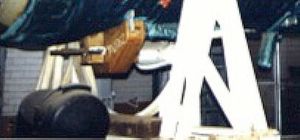 | Almaz Shchit-2 Gun The single-barrel gun fitted ventrally to the Almaz OPS-4 station. Credit: Dave Anderman |
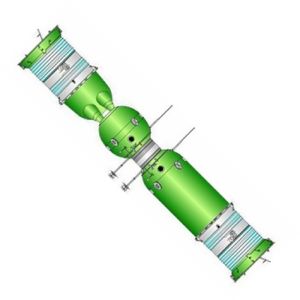 | Soyuz VI / OIS Mishin's version of Soyuz VI with OIS light space station (conceptual drawing based on description). Credit: © Mark Wade |
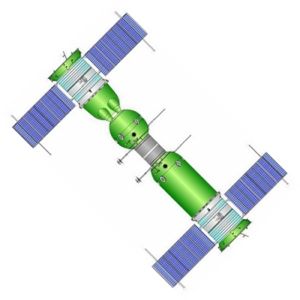 | Soyuz R Soyuz R military research laboratory (conceptual drawing based on description). Credit: © Mark Wade |
 | Soyuz PPK Soyuz PPK antisatellite interceptor (conceptual drawing based on description). Credit: © Mark Wade |
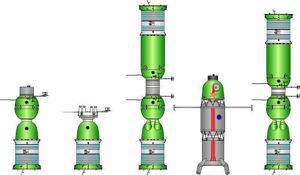 | Military Soyuz Comparison of military variants of Soyuz. From left to right: Soyuz P, Soyuz PPK, Soyuz R, Soyuz VI (Kozlov), Soyuz VI/OIS (Mishin) Credit: © Mark Wade |
 | Soyuz P Soyuz P antisatellite interceptor (conceptual drawing based on description). Credit: © Mark Wade |
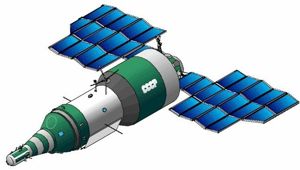 | Almaz Original Almaz - Early configuration with VA return capsule. Credit: © Reginaldo Miranda Jr |
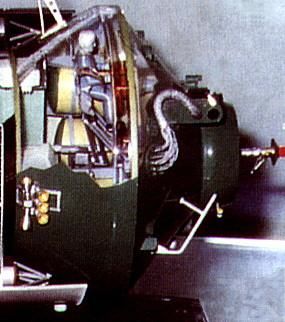 | TKS model TKS model. Close-up of docking system at base. Credit: © Dietrich Haeseler |
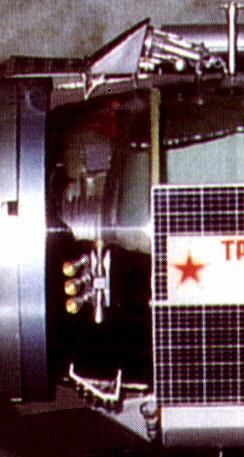 | TKS model TKS model. Close-up of main manoeuvre engines (in triangular housings top and bottom) and reaction control system engine cluster. Credit: © Dietrich Haeseler |
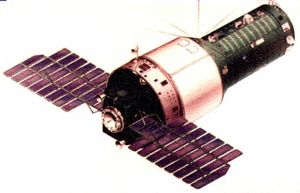 | Almaz-1 The Almaz station as flown during Phase 1 of the programme (Salyut 3 and 5). Credit: Khrunichev |
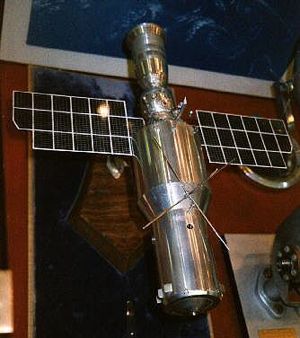 | Almaz model Model of Almaz station as flown in Phase 1 at the Chelomei Bureau. Credit: Andy Salmon |
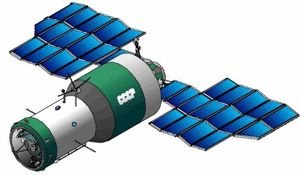 | Almaz Almaz - configuration as flown on Salyut 3 / Salyut 5. Credit: © Reginaldo Miranda Jr |
 | Almaz - Soyuz Almaz - configuration as flown on Salyut 3 / Salyut 5 with Soyuz ferry craft. Credit: © Reginaldo Miranda Jr |
 | Almaz right hatch Almaz forward tunnel. In the original design this led to the hatch in the heat shield of the VA crew return capsule. Credit: © Mark Wade |
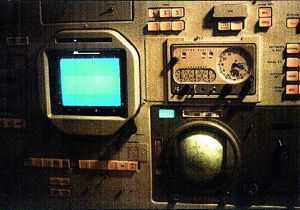 | Almaz main console Close-up of the main console for operating the station, with the familiar Soyuz-type globe, clock, and external television/radar scope instruments. Credit: © Mark Wade |
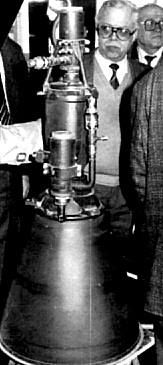 | RD-0225 Almaz engine RD-0225 main propulsion engine for Almaz space station Credit: © Dietrich Haeseler |
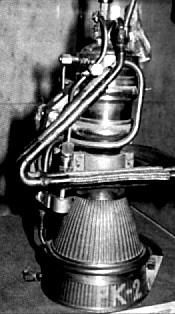 | Almaz station engine Almaz station orientation engine. Credit: © Dietrich Haeseler |
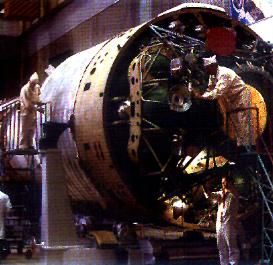 | Almaz An Almaz station being prepared for flight at the Khrunichev Factory in Moscow. Credit: Khrunichev |
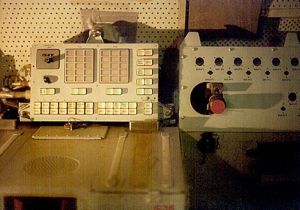 | Almaz forward panel Another Almaz control station, located in the station forward of the camera. Purpose unknown. Credit: © Mark Wade |
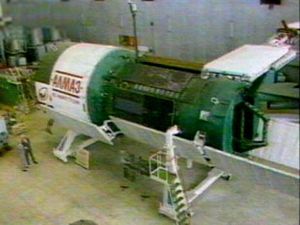 | Almaz-T |
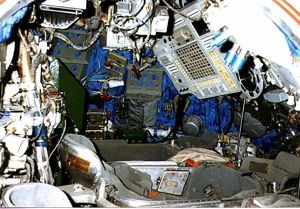 | TKS VA interior TKS VA interior - Chelomei School, Leninsk Credit: © Mark Wade |
 | TKS TKS manned space station ferry. Credit: © Mark Wade |
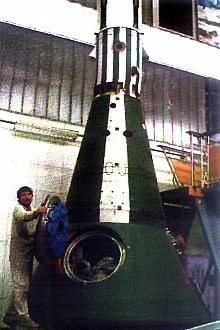 | TKS capsule TKS capsule at Khrunichev factory. Credit: Khrunichev |
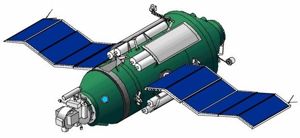 | Cos1663D TKS - Cosmos 1663 Configuration. The recovery systems of the VA capsule were replaced with military space sensors. Credit: © Reginaldo Miranda Jr |
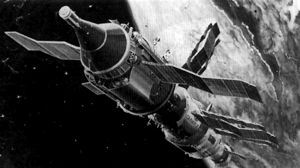 | Kosmos 1267/Salyut 7 Kosmos 1267 / Salyut 7. This detailed painting was the first revelation in the West of the configuration of the TKS spacecraft. |
 | Almaz-1V Almaz-1V unmanned earth resources satellite. Development was authorised in 1986 but the project was abandoned after the collapse of the Soviet Union. Credit: Khrunichev |
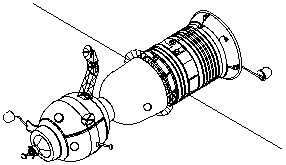 | Soyuz 7K-T Credit: © Mark Wade |
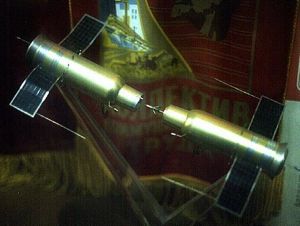 | Kosmos 186/188 Kosmos 186/188 docking. Soyuz-R and OIS would have had a similar appearance. Credit: © Mark Wade |
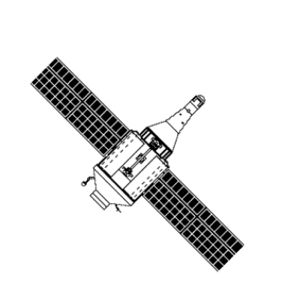 | TKS Obsolete drawing of the TKS space station ferry according to information available ca. 1987. At that time it was known in the west as the 'Heavy Kosmos' spacecraft. Credit: © Mark Wade |
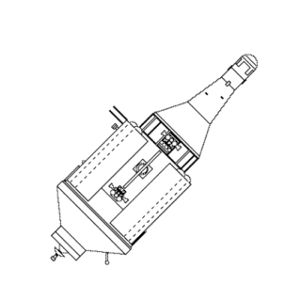 | TKS Large Obsolete drawing of the TKS space station ferry according to information available ca. 1987. At that time it was known in the west as the 'Heavy Kosmos' spacecraft. Credit: © Mark Wade |
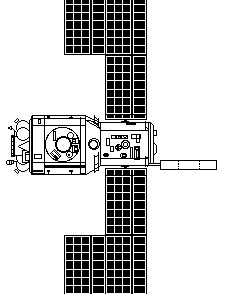 | Almaz Obsolete drawing showing suspected appearance of Almaz space station, ca. 1992. Credit: © Mark Wade |
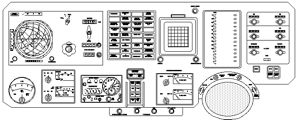 | Panel Soyuz 7K-OK Control panel of the initial earth orbit version of Soyuz. Credit: © Mark Wade |
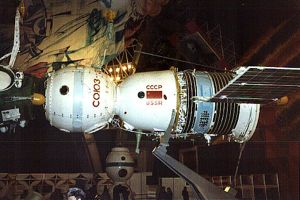 | Soyuz 7K-T Credit: © Mark Wade |
 | Soyuz VI (sketch) Drawing from an article by Samara chief designer Kozlov showing a Soyuz-VI-like spacecraft with two nuclear thermal generators, with the radiation shadow zones indicated. |
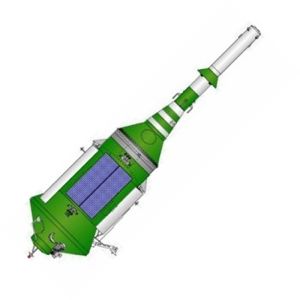 | TKS Manned Ferry TKS manned space station ferry. Credit: © Mark Wade |
1964 Duing the year - . Launch Vehicle: R-7.
- Development of Soyuz-R and Soyuz-P begun. - .
Nation: Russia.
Related Persons: Kozlov.
Program: Almaz.
Class: Manned.
Type: Manned spacecraft. Spacecraft: Soyuz 7K-TK,
Soyuz P,
Soyuz PPK,
Soyuz R.
KB Kozlov began active development of the military applied versions of the Soyuz. A new version of the R-7 launch vehicle, the 11A514, was put into development to support launch of the Soyuz-P, now designated the 7K-PPK (pilotiruemovo korablya-perekhvatchika, manned interceptor spacecraft). The Soyuz-R would include the small orbital station 11F71 with photo-reconnaissance and ELINT equipment. To dock with the 11F71 station Kuibishev developed the transport spacecraft 11F72 7K-TK. This version of the Soyuz was equipped with rendezvous, docking, and transition equipment, including an airlock, that allowed the two cosmonauts to enter the station without using EVA. The launch vehicle for the 7K-TK would be the 11A511, known today as the Soyuz.
1965 January 1 - .
- Almaz space station development authorised. - . Nation: Russia. Spacecraft Bus: Almaz. Spacecraft: Almaz APOS. Central Committee of the Communist Party and Council of Soviet Ministers Decree 'On work on space stations at OKB-52' was issued..
1965 March 1 - .
- Soyuz 7K-PPK cancelled. - . Nation: Russia. Related Persons: Chelomei. Program: Almaz. Class: Manned. Type: Manned spacecraft. Spacecraft Bus: Soyuz. Spacecraft: Soyuz PPK. Based on successful test flights of Chelomei's unmanned interceptor-sputnik prototypes (Polyot 1 and 2), the Soyuz 7K-PPK manned interceptor version is cancelled..
1966 September 2 - .
- Cosmonaut military program training groups - .
Nation: Russia.
Related Persons: Artyukhin,
Belousov,
Belyayev,
Beregovoi,
Demin,
Filipchenko,
Gubarev,
Gulyayev,
Kolesnikov,
Kuklin,
Lazarev,
Matinchenko,
Popovich,
Shatalov,
Shonin,
Titov,
Volynov,
Vorobyov,
Zaikin.
Program: Voskhod,
Almaz.
Flight: Soviet Lunar Landing,
Soyuz 1,
Soyuz 2A,
Soyuz 7K-L1 mission 1,
Soyuz 7K-L1 mission 2,
Soyuz 7K-L1 mission 3,
Soyuz s/n 3/4,
Soyuz s/n 5/6,
Voskhod 3.
Spacecraft: Almaz OPS,
Soyuz VI,
Spiral OS,
Voskhod.
Kamanin organises the cosmonauts into the following training groups:
- Voskhod: Volynov, Shonin, Beregovoi, Shatalov.
- Spiral: Titov, Kuklin, Filipchenko, Beregovoi, Shatalov.
- Soyuz VI: Popovich, Gubarev, Artyukhin, Gulyayev, Belousov, Kolesnikov
- Almaz: Belyayev, Shonin, Matinchenko, Demin, Zaikin, Vorobyev, Lazarev
1966 September 7 - .
- Cosmonaut group leaders - .
Nation: Russia.
Related Persons: Anokhin,
Belyayev,
Gorbatko,
Grechko,
Khrunov,
Kubasov,
Popovich,
Pravetskiy,
Severin,
Volkov,
Yeliseyev.
Program: Soyuz,
Almaz.
Flight: Soyuz 1,
Soyuz 2A.
Spacecraft: Almaz OPS,
Soyuz 7K-L1,
Soyuz VI,
Yastreb.
Volkov, Grechko and Kubasov believe they can complete cosmonaut training in two months. Of course they know space technology, but Kamanin informs them that, with intensive training, they might be ready in one or two years. Popovich is assigned as leader of the Soyuz VI military spacecraft training group, and Belyayev as head of the Almaz military orbital station training group. Kaminin tells Severin to complete spaceuits for Khrunov and Gorbatko, but to ignore Mishin's orders to prepare suits for Anokhin and Yeliseyev. Anokhin has already been rejected due to his age and health, and Yeliseyev is still being tested. Kamanin reviews draft test programs for the UR-500K/L1 and N1-L3. He lines out statements inserted by Pravetskiy on joint training of cosmonauts by the MOM, Ministry of Public Health and VVS.
1966 October 13 - .
- Almaz status review. - .
Nation: Russia.
Related Persons: Chelomei,
Kuznetsov,
Tereshkova.
Program: Almaz.
Spacecraft Bus: Almaz.
Spacecraft: Almaz OPS.
Tereshkova departs for a tour of Belgium. General Kuznetsov accompanies a group of cosmonauts to visit Chelomei's design bureau to review progress on the Almaz military space station. Each station will remain in orbit for two years, with the crews being changed out every two months. Kamanin believes the ability of a crew to operate in zero-G for two months is not proven; he will assume the crew will have to be changed every two weeks. This would mean that per year of operation, 25 crews and 25 boosters for their delivery to the station would be required. If each crew could fly 2-3 times, per year, then even in this worse case scenario, 10 crews would be enough to keep the station manned.
1966 December 28 - .
- Soyuz-VI to fly by end of 1967. - . Nation: Russia. Related Persons: Kozlov. Program: Almaz. Class: Manned. Type: Manned spacecraft. Spacecraft Bus: Soyuz. Spacecraft: Soyuz VI. Resolution 'On approval of work on the 7K-VI Zvezda and course of work on Almaz' no. 305 ordered Kozlov's filial 3 of OKB-1 to undertake first flight of the manned military research spacecraft 7K-VI - 11F73 Zvezda by the end of 1967..
1966 December 28 - . Launch Vehicle: UR-700.
- Almaz and LK-700 development status - .
Nation: Russia.
Related Persons: Chelomei,
Smirnov,
Ustinov.
Program: Almaz,
Lunar L1,
Lunar L3.
Spacecraft: Almaz OPS,
LK-1,
LK-700,
Raketoplan.
Kamanin accompanies 17 generals and other officers of the VVS in a tour of Chelomei's OKB-52. Chelomei spends five hours personally acquainting the visitors with his bureau's space technology capabilities. It was the first in-depth meeting Kamanin and Vershinin have had with Chelomei, despite meeting with him occasionally since 1961. They have mainly interacted with Korolev and now Mishin. Additional Details: here....
1967 January 5 - .
- Cosmonaut training status - .
Nation: Russia.
Related Persons: Brezhnev,
Titov.
Program: Lunar L1,
Soyuz,
Almaz.
Spacecraft: Almaz OPS,
Soyuz 7K-L1,
Soyuz 7K-OK,
Soyuz VI,
Voskhod.
Crews are in training for Voskhod, Soyuz, Lunar L-1, Almaz, and 7K-VI missions. There will be 100 cosmonauts in training by February. Meanwhile the Americans have conducted 10 manned flights since the last Soviet manned flight in March 1965. The cosmonauts want Kamanin to be training 8 crews for L-1 translunar flights, but he only has 4 in training. He doesn't think it is worth to train more, since if one successful L-1 flight is conducted before the 50th Anniversary of the Soviet Union in November 1957, all subsequent flights will be cancelled. Additional Details: here....
1967 February 9 - .
- Almaz space station begun. - . Nation: Russia. Spacecraft Bus: Almaz. Spacecraft: Almaz OPS. Ministry of General Machine Building (MOM) Decree 'On approval of work on Almaz' was issued..
1967 July 31 - .
- Meeting of space programme management in the Crimea. - .
Nation: Russia.
Program: Almaz.
Spacecraft: Almaz OPS,
Soyuz OB-VI.
Two planning documents are discussed. The first deals with the training of civilian cosmonauts. Two phases of training are planned, the first phase at MOM institutes and Minzorar, the second at TsPK and the VVS. In addition 50 new air force pilots will be identified for space duty in three groups in 1968, 1969, and 1970. They will be ready for the planned large number of 7K-VI and Almaz flights beginning in 1972. Brezhnev would like to see more Voskhod flights. Meanwhile Titov has qualified as a test pilot third class, and will qualify as second class by the end of the year. All in all, things are looking good in the years ahead.
1967 August 14 - .
- Almaz space station schedule approved. - . Nation: Russia. Spacecraft Bus: Almaz. Spacecraft: Almaz OPS. Central Committee of the Communist Party and Council of Soviet Ministers Decree 'On schedule of work on the Almaz space station' was issued..
1967 September 11 - .
- Kamanin reviews military space plans for the period 1968-1975. - . Nation: Russia. Program: Almaz. Spacecraft: Almaz OPS, Soyuz 7KT-OK, Soyuz VI, Spiral OS. The first military combat space units are to be formed - for operations with the 7K-VI and Almaz spacecraft, together with subsidiary Soyuz transport and training flights..
1967 September 13 - .
- Kamanin continues work on the 8-year plan for military space. - .
Nation: Russia.
Program: Almaz.
Spacecraft: Almaz OPS,
Soyuz 7KT-OK,
Soyuz VI,
Spiral OS.
The general staff's space plans are impressive - in 1968-1975 they foresee no less than 20 Almaz space stations, 50 military 7K-VI missions, 200 Soyuz training spacecraft flights and 400 Soyuz space transport flights. This is based on the assumption that the crew of the military space stations will have to be rotated every 15 days. That will require 48 transport spacecraft per year, implying not less than 30 ready crews with 3 cosmonauts in each crew (this in turn implies each each cosmonaut will fly a space mission 1.5 times per year). Since supplies will have to be delivered to the stations, that will require another 200 additional transport spacecraft launches. And all of this is aside from civilian Soyuz flights, L1, L3, and various other civilian spacecraft - implying a total of 1000 launches in the period. This will require 800 Soyuz-class launch vehicles, 100 Protons, and 10 to 12 N1 boosters. The inevitable conclusion for Kamanin is that most of the transport launches should be made by a reusable winged spacecraft, air-launched from an An-22 heavy transport. This is the goal of the Spiral project. By 1975 Kamanin sees a requirement for 400 active cosmonauts, organised in two to three aerospace brigades, supported by10 aviation regiments, and including the TsPK training centre -- altogether 20,000 to 25,000 men. 250 million roubles will be needed to build new aerodromes and facilities alone, all chargeable to the VVS. Total cost will run into tens of billions of roubles per year.
1967 November 30 - .
- Almaz program review. - .
Nation: Russia.
Related Persons: Afanasyev, Sergei,
Chelomei,
Gagarin,
Mishin,
Pashkov.
Program: Almaz.
Spacecraft Bus: Almaz.
Spacecraft: Almaz OPS.
Kamanin attends an Almaz program review with Pashkov, Afanasyev, and Chelomei. The resolution of June 1967 required space trials to begin in 1968, and entry of the system into military service in 1969. But this schedule was flawed from the beginning. The project plan required design, qualification, and delivery of completely new complex systems from ten different ministries. The Ministry of Radio Equipment was to deliver 66 items, but the ministry refused, saying they could handle two at most. Similar responses were received from other ministries. The result is that six months into the program, the first flight schedule has already slid 24 months, to 1970. The VVS has been dealing with Chelomei for two years, and find him much better to work with than Mishin. Chelomei's deputies are highly cultured men, pleasant to work with (unlike Mishin and his circle). The VVS is to handle the following on the Almaz program:
- Development of crew safety items, cockpit indicators on the function of the landing system, and controls for manual landing by the astronaut
- Development of the HAZ complex for training of crew members
- Review and approval of station systems for water generation, medical observation of the crew, and atmosphere indicators and controls
- Development of a manned manoeuvring unit to allow the cosmonauts to manoeuvre up to 300 m from the station
1967 December 8 - .
- TsKBEM confirms Mishin's decision to cancel Soyuz VI - .
Nation: Russia.
Related Persons: Bushuyev,
Chelomei,
Feoktistov,
Gaidukov,
Karas,
Kerimov,
Mishin,
Okhapkin,
Shcheulov.
Program: Almaz.
Spacecraft: Almaz OPS,
LK-1,
Soyuz 7K-S,
Soyuz OB-VI,
Soyuz VI.
Mishin is away on 'cure' for his drinking problem. A 'Podlipki Soviet' is held at TsKBEM. The issue is cancellation of Kozlov's 7K-VI military Soyuz. Bushuyev, Chertok, Okhapkin, Feoktistov are in favour of cancelling it. Opposed are Karas, Shcheulov, Kostonin, Gaidukov, and the various military representatives at the meeting. It was now six years since OKB-1 was required to put a military manned spacecraft into space - and, factually speaking, nothing has been done. Military experiments proposed for each manned flight by OKB-1 to date had been rejected on various grounds - no weight, no space aboard the spacecraft. Good progress has been made with Kozlov's VI and Chelomei's Almaz - now they've managed to kill the VI, and Mishin and Kerimov are constantly denigrating Almaz (saying it is too heavy, and unsuited for the purpose). The whole thing is a replay of the LK-1 situation. In 1963, a resolution was issued to send a Soviet man around the moon. Instead, after two years of development, Korolev managed to get Chelomei's LK-1 lunar spacecraft cancelled, and started all over with his own L1. Additional Details: here....
1968 January 27 - .
- Cosmonauts take case against Mishin to VVS high command. - .
Nation: Russia.
Related Persons: Afanasyev, Sergei,
Belyayev,
Chelomei,
Gagarin,
Leonov,
Mishin,
Popovich,
Titov,
Ustinov.
Program: Lunar L1,
Almaz.
Spacecraft: Almaz OPS,
Soyuz VI.
Kamanin, Gagarin, Titov, Popovich, Belyayev, and Leonov meet with Marshal Yakabovskiy. They inform him that Mishin is blocking further development of the 7K-VI military manned spacecraft and also trying to kill Chelomei's Almaz military space station. They get nowhere. The Marshal says that while he doesn't understand much about space himself, Ustinov had assured him that Mishin and Afanasyev were taking all measures necessary to correct the necessary material...
1968 February 8 - .
- VVS officers inspect TsPK. - .
Nation: Russia.
Related Persons: Nikolayev,
Popovich.
Program: Lunar L1,
Lunar L3,
Almaz.
Spacecraft Bus: Almaz.
Spacecraft: Almaz OPS.
It is currently organised in three cosmonaut detachments: Nikolayev commands the first detachment, which is training for L3, L1, and Soyuz fiights. Popovich commands the second, training for Almaz and 7K-VI military space missions. Nikeryasov commands the third, which is the 'observer' detachment.
1968 March 7 - .
- Soyuz parachute recertification holding up all manned programs. - .
Nation: Russia.
Related Persons: Mishin,
Tkachev.
Program: Soyuz,
Lunar L1,
Lunar L3,
Almaz.
Spacecraft: Almaz OPS,
Soyuz 7K-L1,
Soyuz 7K-LOK,
Soyuz 7K-OK.
Mishin certified to MAP on 5 March that the Soyuz parachute system development is complete, but Tkachayev has dissented, saying that the system was unreliable and overweight (this from the same chief designer that certified the previous design as having an 0.999 reliability!). The parachute trials will not be finished until May - meaning there will be no manned Soyuz launch in April. This problem is holding up the L1, L3, and Almaz projects as well.
1968 December 26 - .
- Heated arguments over technical approach of Soviet space systems - .
Nation: Russia.
Related Persons: Beregovoi,
Mishin,
Mnatsakanian,
Severin,
Shatalov.
Program: Lunar L1,
Soyuz,
Almaz.
Flight: Apollo 8.
Spacecraft: Almaz OPS,
Soyuz 7K-L1,
Soyuz 7K-LOK,
Soyuz 7K-OK,
Soyuz 7K-S,
Soyuz OB-VI,
Soyuz VI.
The training for the Soyuz 4 and 5 flights was completed last night. Today the crews undergo medical tests and start preparation of their flight logs/flight plans. On the return flight to Moscow Shatalov, Beregovoi, Severin, Kamanin, and Mnatsakanian get into a heated argument. The cosmonauts attack Mnatsakanian's Igla automated docking system. It limits docking manoeuvres to periods when the spacecraft are flying over the Soviet Union due to the requirement for ground stations to receive live television. The Americans worked only on the Apollo spacecraft for the last two to three years, while the Soviets have divided their efforts on no less than five spacecraft types: the L1, L3, Soyuz, Soyuz VI, and Almaz. This is all Mishin's fault...
1969 Early - .
- Soyuz VI Flight 1 (cancelled) - . Crew: Kolesnikov, Popovich. Backup Crew: Belousov, Gubarev. Nation: Russia. Program: Almaz. Flight: Soyuz VI Flight 1. Spacecraft Bus: Soyuz. Spacecraft: Soyuz VI. The planned first flight of the Soyuz VI combat spacecraft was planned for early 1969, beating America's equivalent Manned Orbiting Lab. The project was cancelled in 1968..
1969 January 10 - . LV Family: N1.
- Mishin meeting with Afanasyev in wake of Apollo 8 triumph - . Related Persons: Mishin, Afanasyev, Sergei. Spacecraft: , MKBS, Almaz. Mishin notes on 13.00 Meeting with SA Afanasyev. (In wake of Apollo 8 triumph). Yu.A.Mozzhorin: N1 is the basis for MKBS. Try "Almaz" on the N1. (Mishin Diaries 2-184).
1969 March 20 - . Launch Vehicle: N1.
- Soviet of military officers meets to review manned space plans. - .
Nation: Russia.
Related Persons: Beregovoi.
Program: Lunar L3,
Lunar L1,
Soyuz,
Almaz.
Spacecraft: Almaz OPS,
LK,
Soyuz 7K-L1,
Soyuz 7K-LOK,
Soyuz 7K-OK,
Soyuz OB-VI,
Spiral OS.
A 50 minute presentation is given on space plans. Russia plans to fly no less than six different types of manned spacecraft in 1969-1970 - the Soyuz, L1, L3, Almaz, Soyuz VI, and Spiral. This will result in a decisive answer to the American Apollo programme within two to three years. No N1 launch with the complete L3 lunar landing spacecraft is planned until 1970. Approval is sought for the VVS to buy 10 Soyuz spacecraft for continued manned military flights in low earth orbit. Otherwise between the second half of 1970 and during all of 1971 there will be no spacecraft available for manned flights Additional Details: here....
1969 May 10 - .
- Military space research plans - .
Nation: Russia.
Related Persons: Kutakhov.
Program: Lunar L3,
Lunar L1,
Soyuz,
Almaz.
Spacecraft: Almaz OPS,
LK,
Soyuz 7K-L1,
Soyuz 7K-LOK,
Soyuz 7K-OK,
Soyuz OB-VI,
Spiral OS.
Kamanin makes a speech to the VVS Soviet, setting forth again plans for military research in space. His presentation shows how far the USSR is behind the Americans, and the need to regain the lead. He again proposes 10 to 12 military Soyuz flights beginning in the first quarter 1970. This will fill the gap until Soyuz VI and Almaz will begin flying in 1972. Kutakhov is categorically against these Soyuz flights but, under pressure from others, still agrees to form a commission to study the matter. Reference is made to a Ministry of Defence decree of 7 January 1969.
1969 June 21 - .
- Design issued for OIS military space station. - . Nation: Russia. Program: Almaz. Class: Manned. Type: Manned spacecraft. Spacecraft: Soyuz 7K-S, Soyuz OB-VI. Draft project OIS 11F730, was issued by TsKBEM and filial 3 jointly. In the course of 1969 complete drawings were released for the OIS project including modules for the spacecraft 7K-S, 7K-S-I, and 7K-S-II..
1969 August 1 - . LV Family: Proton. Launch Vehicle: Proton-K/D.
- The DOS Conspiracy begins - .
Nation: Russia.
Related Persons: Chelomei,
Mishin.
Program: Lunar L3,
Almaz,
Salyut.
Spacecraft: Almaz OPS,
LK,
MKBS,
Soyuz 7K-LOK.
With the collapse of the work on the N1, the whole reason for Mishin's design bureau's existence simply vanished in the air. A new high-priority project was needed. Korolev had begun development of a Multi-Module Space Base (MKBS) before 1966. However MKBS was to be launched by the N1; as long as this was not available, there would be no MKBS. Almaz on the other hand did not require a new launch vehicle, although the UR-500 was in a period of intense 'baby sickness'. So while TsKBEM was in a period of analysis and instability, Chelomei's Reutov and Fili facilities were building space stations for the Ministry of Defence.
On one of these August 1969 days, three of Chelomei's TsKBM engineers came to the office of Mishin's deputy, Chertok, with a plan to get a space station orbited before the American Skylab. They wanted a collaboration between the two competing design bureaux. Their plan was to take an Almaz spaceframe, install Soyuz systems, add a new docking tunnel with a hatch to reach the interior, and presto - a space station was finished. Tentative discussions with potential allies within Chelomei's design bureau found support there as well. The DOS 'long-duration orbiting station' was the result of this 'conspiracy'.
1969 October 5 - .
- DOS Conspiracy briefed to Ustinov - .
Nation: Russia.
Related Persons: Afanasyev, Sergei,
Feoktistov,
Mishin,
Tyulin,
Ustinov.
Program: Lunar L3,
Almaz,
Salyut.
Spacecraft: LK,
Soyuz 7K-LOK.
Mishin was opposed to the DOS space station concept - he wanted to pursue the N1-launched MKBS. Afanasyev and Deputy Minister Tyulin wouldn't support the idea either. None of them wanted to take the risk. The only chance was to get to VPK Chairman Ustinov through Communist party channels. The opportunity came on the flight of engineers and management to Baikonur for the Soyuz 6/7/8 flight. Feoktistov had prepared a briefing on DOS, which he presented to Ustinov.
1969 October 19 - .
- DOS Conspiracy briefed to wide circle of space planners - .
Nation: Russia.
Related Persons: Afanasyev, Sergei,
Bushuyev,
Chelomei,
Feoktistov,
Keldysh,
Mishin,
Semenov,
Serbin,
Tyulin,
Ustinov.
Program: Lunar L3,
Almaz,
Salyut.
Spacecraft: Almaz OPS,
LK,
Salyut 1,
Soyuz 7K-LOK.
In the euphoria after the return of the Soyuz 6/7/8 crews, the problem was how to get Ustinov to meet further with the DOS 'conspirators'. Mishin had prohibited any meetings by TsKBEM staff with the Communist Party Secretary unless Mishin was also present. Another obstacle was that Feoktistov was not a party member; how could his presence at a party meeting be explained to Mishin later?
In any event these consideations were simply ignored. Feoktistov was present at a party meeting with Keldysh, Afanasyev, Tyulin, Serbin, and the Ministry of Defence's party cell: Strogonov, Kravtsev, and Popov. Keldysh was mainly worried how the project would affect the N1, but was reassured that the N1 had a dedicated work force, and the L3 lunar lander spacecraft engineers and workers that would work on DOS were currently idle and had no part of that work. It was finally decided to go ahead with the DOS no earlier than January, to allow time for Ministry Decrees, approval of a work plan by the VPK, preparation of a decree for signature by the Central Committee of the Communist Party and the Soviet Ministers. Work began on the project in December 1969 under the initial auspices of the Academy of Sciences. Additional Details: here....
1969 December 1 - . LV Family: Proton. Launch Vehicle: Proton-K.
- First flight Almaz station close to completion - . Nation: Russia. Program: Almaz. Class: Manned. Type: Manned space station. Spacecraft Bus: Almaz. Spacecraft: Almaz OPS. Ten stations 'in advanced stage of completion' by end of year..
1969 December 6 - .
- The DOS Conspiracy in the open - .
Nation: Russia.
Related Persons: Afanasyev, Sergei,
Chelomei,
Kuznetsov, Viktor,
Mishin,
Pilyugin,
Ryazanskiy,
Ustinov.
Program: Almaz,
Salyut.
Spacecraft: Almaz OPS,
Salyut 1,
Soyuz 7K-S,
Soyuz 7KT-OK.
Afanasyev met with the Chief Designers - Pilyugin, Ryazanskiy, V Kuznetsov, and Chelomei's Deputy, Eydis. Mishin was 'sick' and Chelomei had sent his deputy, as usual, to avoid having to meet Mishin. Afanasyev started with the demand that an Almaz flight take place within less than two years, before the end of the Eighth Five Year Plan. He asked Eydis to install an Igla passive docking system to permit docking with the station of the existing Soyuz 7K-OK as opposed to the planned 7K-S. If Chelomei's bureau could not meet this requirement, then the 'conspirator's' DOS project could be authorised in its place. Additional Details: here....
1969 December 26 - . Launch Vehicle: N1.
- DOS formally authorised - .
Nation: Russia.
Related Persons: Chelomei,
Glushko,
Kuznetsov,
Mishin,
Ustinov.
Program: Lunar L3,
Almaz,
Salyut.
Spacecraft: Almaz OPS,
Salyut 1.
Ustinov called the DOS 'conspirators' to Kuibyshev Street. Mishin was sent away to Kslovodsk and Chelomei and Glushko were not invited. No one wanted to listen to any more of Glushko's diatribes about Kuznetsov's engines.
Ustinov supported presentation of the DOS concept to the Central Committee. Chelomei categorically opposed DOS and was trying to kill it through military channels. But the allure of an '18 month' station - one which would not only beat the American Skylab, but be in space in time for the 24th Party Congress - seemed too alluring. Mishin also rejected DOS, but deputies at both design bureaux supported the concept and were eager to proceed.
DOS was therefore created only when the moon project failed. Chelomei was forced to work on DOS, and it severely impacted Almaz schedules. The Salyut name was later applied to both the DOS and Almaz stations, creating the impression in the outside world that they were built by one designer.
1970 January 19 - .
- Soviet leadership interest in manned spaceflight has collapsed. - .
Nation: Russia.
Related Persons: Belyayev,
Brezhnev,
Bykovsky,
Chelomei,
Mishin,
Popovich.
Program: Salyut,
Almaz,
Skylab.
Spacecraft: Almaz OPS,
Salyut 1,
Soyuz 7K-S.
Kamanin notes that interest of the leadership in manned spaceflight has collapsed with the end of the moon race. Brezhnev has declared that his primary interest is in earth orbital space stations. Both Mishin and Chelomei have stations in development, but the work is progressing slowly. There will be no launch of either of their projects until 1972 - which means the Soviets will be beaten by the US Skylab. Kamanin believes the Americans can never be beaten in space unless all space projects are guided firmly by a single Ministry of Defence and Civilian Space office. Meanwhile the Hong Kong flu epidemic is hitting many at the cosmodrome - Moroz, Popovich, and Bykovsky are all seriously ill.
1970 February 1 - . LV Family: Proton. Launch Vehicle: Proton-K.
- Space station programs rationalised. - .
Nation: Russia.
Related Persons: Chelomei,
Mishin.
Program: Almaz.
Class: Manned.
Type: Manned space station. Spacecraft: Almaz OPS,
Salyut 1,
Soyuz 7K-S,
Soyuz OB-VI.
Brezhnev orders a cooperative crash program to build a civilian space station to beat Skylab into orbit. The civilian station (later named Salyut) will use the Almaz spaceframe fitted out with Soyuz functional equipment. Mishin's OIS military station was cancelled and Chelomei's Almaz would continue, but as second priority to the civilian station. The Soyuz 7K-S station ferry, the 7K-ST, would be revised to be a more conservative modification of the Soyuz 7K-OK. The OIS cosmonaut group was incorporated into the Almaz group.
1970 February 7 - .
- Soyuz 10 and 11 crew selections; Soyuz 9 experiment review - .
Nation: Russia.
Program: Salyut,
Soyuz.
Flight: Soyuz 10,
Soyuz 11,
Soyuz 9.
Spacecraft Bus: Almaz.
Spacecraft: Salyut 1.
Kamanin meets with nine generals involved in supervising aspects of the space programme. Only one is from the VVS aviation, the rest have artillery or rocket backgrounds. Naturally they have no bad words for the RSVN or TsUKOS. At the centre, crew selection for the Soyuz 10 and Soyuz 11 missions to the DOS space station are underway. A review is conducted of the biomedical and zero-G studies planned for Soyuz 9. This is followed by a meeting with General Komarov and the cosmonauts on plans for the new cosmonaut training building and a nine-story apartment building.
1970 February 16 - . LV Family: N1.
- Next five year plan emphasized the use of the N1 - .
Related Persons: Mishin,
Chelomei,
.
Spacecraft: Soyuz,
MKBS,
Almaz,
Salyut,
LK.
The next five year plan emphasized the use of the N1 for MKBS and robot soil return missions to Mars by the mid-1970's. But an N1M and improved lunar spacecraft would be developed for establishment of a moon base late in the decade. This was all laid out in a review of the proposed five-year plan on 16 February 1970 (Mishin Diaries 2-302):
25. Budget Review - 5 Year Plan (presumed in thousands of rubles)
Experimental design work - 8734
R&D - 680
Projected over 5 yrs
Experimental Base - 3314
N1-L3 - 2665 (Capital investments)
DOS - 170
Almaz - 645
Topaz - 750 (unknown code name).
Apparatus for military use - 825 350
National economy. others - 928 150
Launch Vehicles - 255 116
Launch complexes - 476 91
Skh.A. - 830 293
EYaRD - 380
Launch work - 780 760
N1-L3 71 72 73 74 75 +ú
(11A52) 3 4 4 4 2 17
11A52 for Mars-75 - - - - 2 2
Grand total 19
26. On the draft resolution for the MKBS.
1. Use the same cooperation established in the design and manufacture of DOS.
2. Expand the cooperation of developers in various departments (especially on power, life support systems, equipment for national economic and scientific purposes).
2. Create the necessary experimental and industrial base (with the planned cooperation of developers).
3. Select TsKBEM factory for serial instrument production with MOM.
4. Determine the organization within MOM (former Nikitin) for the development of simulators and control panels.
5. Organize mass production 7K-S at the plant in Omsk (or in the factory "Progress").
6. Hydrogen blocks Sr and S - TSKBEM factory and plant "Progress".
7. Instruct Affiliate TsKBM (T. Bugajski) development of MKA (shuttle) according to TsKBEM's requirements (an interesting allusion to development of the LKS space shuttle by Chelomei's organization).
8. Determine the parent organization for the production of "Almaz" - organization of Chelomei (Reutov).
9. Immediately begin design work on the technical positions for MKBS ... see paragraph 21 (to establish a single NTS Scientific and Technical Council)
1970 February 18 - .
- Kamanin opposes DOS - .
Nation: Russia.
Related Persons: Belyayev,
Kozlov,
Mishin,
Smirnov,
Ustinov.
Program: Soyuz,
Salyut,
Almaz.
Flight: Soyuz 10,
Soyuz 11.
Spacecraft: Almaz OPS,
Salyut 1,
Soyuz 7KT-OK,
Soyuz OB-VI,
Soyuz VI.
Kamanin recommends the death benefit to be awarded to Belyayev's family. There is to be a one-time payment of 2,000 roubles to his wife; 1,100 roubles to his daughter; 180 roubles/month pension to the wife; 75 roubles/month to the daughter; access to cosmonaut centre sanatoriums; and a seven-room apartment in Moscow.
Kamanin also reviews the government decree on the DOS-7K space station program. The Ministry of Defence is against it - they want to continue with the Almaz and Soyuz VI projects already underway. DOS will bring both of these to a halt. This is a repeat of the situation in 1967. Kozlov was making good progress on the original Soyuz VI, when it was killed by Mishin. Now three years later Mishin's Soyuz VI is put on the back burner. The Soyuz 7K-OK is still the only manned program brought to completion. Kamanin blames all this on Ustinov and Smirnov's stupid political manoeuvring. The DOS decree has not one word on the training of cosmonauts for these space station missions...
1970 February 26 - .
- Kamanin views DOS, continuation of N1-L3 with dismay - .
Nation: Russia.
Related Persons: Mishin.
Program: Soyuz,
Salyut,
Lunar L3,
Almaz.
Flight: Soyuz 10,
Soyuz 11.
Spacecraft: Almaz OPS,
LK,
Salyut 1,
Soyuz 7K-LOK,
Soyuz OB-VI,
Soyuz VI.
The Ministry of Defence and VVS approve the draft DOS resolution. Kamanin has fought against it. He would prefer to develop a single reliable Soyuz spacecraft model by building and flying ten more (there are only four left of the original production lot in assembly). Instead the space leadership keep dreaming up new projects. In Kamanin's view, the DOS and its new Soyuz ferry design join Almaz, Soyuz VI, and the L3 as 'paper spacecraft'. Mishin still thinks he will 'teach the N1 to fly' and complete the L3, but Kamanin thinks the chances of this are nil. There is no coherent plan for Soviet spaceflight.
1970 February 27 - .
- DOS schedules, Soyuz Kontakt flights still in play - .
Nation: Russia.
Related Persons: Bogomolov,
Mishin.
Program: Soyuz,
Salyut,
Lunar L3,
Almaz.
Flight: Soyuz 10,
Soyuz 11,
Soyuz n 17,
Soyuz n 18,
Soyuz n 19,
Soyuz n 20.
Spacecraft: Almaz OPS,
Soyuz Kontakt,
Soyuz OB-VI,
Soyuz VI.
A meeting is held on the DOS project. The Central Committee and Soviet Ministers have directed that two DOS space stations be completed by the end of 1970. TsNIIMASH thinks this is impossible - the task can be accomplished in no less than 18 to 24 months. Mishin insists it can be done in ten months, as directed. Kamanin believes he won't even have it ready by the second half of 1971. It took five to seven years to just bring the Almaz, Soyuz VI, and L1 to flight status. This DOS will stop work on all other projects. Mishin still wants to fly two Soyuz spacecraft to test Bogomolov's Kontakt docking system for the L3.
1970 February 28 - .
- Failure to achieve space objectives in Five-Year Plan - .
Nation: Russia.
Program: Soyuz,
Lunar L1,
Lunar L3,
Almaz.
Spacecraft: Almaz OPS,
Soyuz OB-VI,
Soyuz VI.
Kamanin is asked to assist in preparation of the next five-year plan for spaceflight (1971-1975). He muses that nothing that was to be accomplished in the last five-year plan was achieved, so what is he supposed to put in the new one? 1966-1971 was supposed to have seen Soviet manned flybys and landings on the moon; a cosmonaut contingent increased to 140 and cadres in training for military missions on the Soyuz VI and Almaz. None of this was achieved, and the cosmonaut corps actually only numbers 97.
1970 June 11 - .
- Soyuz 9 Day 11 - .
Nation: Russia.
Related Persons: Bykovsky,
Gorbatko,
Nikolayev,
Sevastyanov,
Shatalov,
Yeliseyev.
Program: Soyuz,
Salyut.
Flight: Soyuz 9.
Spacecraft Bus: Almaz.
Spacecraft: Salyut 1.
Things are proceeding normally aboard Soyuz 9. Shatalov and Yeliseyev prepare to depart for the Crimea to train for use of the big solar and stellar telescopes planned for the DOS station. The 15-20 day course will be attended by all 12 DOS cosmonauts. The training plan for DOS is discussed, with a May 1971 flight date as the objective. Kamanin discusses smoking with Bykovsky and Gorbatko - they have to stop.
1970 August 7 - .
- Almaz program review. - .
Nation: Russia.
Spacecraft Bus: Almaz.
Spacecraft: Almaz OPS.
Work has been underway for 5 to 6 years. The decree of the Communist Party/Ministry of Defence of 16 June 1970 finally set forth a firm flight schedule: first trials flight in fourth quarter 1971; all flight trials to be completed by the end of 1972; the design to be accepted for military service in 1973. Priorities are provided to the program that will allow VVS institutes and forces to support this schedule. The Institute of Aviation and Space Medicine (IAKM) will be especially involved in biomedical issues.
1970 September 23 - .
- Cosmonaut training plans. - .
Nation: Russia.
Related Persons: Bogomolov,
Bykovsky,
Mishin,
Popovich.
Program: Salyut,
Almaz,
Lunar L3.
Spacecraft: Almaz OPS,
Soyuz Kontakt,
Spiral OS.
The training plan for DOS#1 is reviewed. The station is to be launched by February 1971. Soyuz 10 and Soyuz 11 will dock with it and crew the station for two to three months, according to Mishin's plan. This however will slow down flight test of Bogomolov's Kontakt docking system for the L3. This was to have been ready by January 1970, but it is still not ready for flight. On the other hand, the completion of the DOS station within four to five months is not possible. There are currently 12 cosmonauts in training for DOS, and ten for Soyuz flights. Popovich heads a group of 22 cosmonauts training for Almaz; and Bykovsky heads a group on lunar issues. The new trainers and simulators are on schedule; the existing ones are being heavily used.
1970 September 30 - .
- DOS trainer final inspection. - .
Nation: Russia.
Program: Salyut.
Spacecraft Bus: Almaz.
Spacecraft: Salyut 1.
Nasser is dead - a blow to Soviet interests. Kamanin goes to Khrunichev to inspect the DOS-7K space station mock-up. It is to be delivered to the cosmonaut training centre on 20 October. Kamanin believes the planned 5 February launch for DOS#1, and 15 February launch for Soyuz 10, cannot be met.
1970 October 3 - .
- DOS issues reviewed by VVS. - . Nation: Russia. Program: Salyut. Spacecraft Bus: Almaz. Spacecraft: Salyut 1. Kamanin meets with the General Staff to discuss issues with the DOS trainer. The issue of forming crews for the DOS program consisting only of unflown cosmonauts is debated..
1970 October 6 - .
- Cosmonaut training centre status. - .
Nation: Russia.
Program: Salyut,
Almaz,
Lunar L3.
Spacecraft: Almaz OPS,
Spiral OS.
Kamanin reviews the work of the training centre in 1970-1971. There are 12 cosmonauts training for DOS missions; 22 for Almaz; 5 for Spiral; and a 'group' for the L3. They have flown 5000 flight hours in jet trainers. During the last two years Kamanin has increased the number of trainers and simulators available; achieved 100% of the training plan; and met the physical training requirements (all cosmonauts must accomplish a 10 km run).
1970 October 20 - . LV Family: N1.
- Lox/LH2 upper stages for the N1 necessary to achieve program - .
Related Persons: Mishin,
Chelomei,
.
Spacecraft: ,
MKBS,
MAVR,
Almaz,
Salyut,
LK,
L3M.
Mishin reviews the work and configurations of the Lox/LH2 (S and Sr) upper stages for the N1 necessary to achieve various programs. Mishin reviews the work and configurations of the Lox/LH2 (S and Sr) upper stages for the N1 necessary to achieve various programs (Mishin Diaries 2-293). Here was see evidence for several previously hinted-at but poorly-documented projects: the Lunar Orbital Station (N1+Almaz), the MAVR manned Mars-Venus-Flyby Spacecraft: AM Isaev - about speeding work on the engine 11D56. AM Lyulka - about speeding work on the engine 11D57.
1. S, Sr - LOS (lunar orbital station?) SNTV satellite for direct TV broadcasting, MAVT (MAVR?), DOS-II (later Mir).
2. S + Sr - L3M, Mavr, MKBS
3. S + S + Sp - L3M, MKBS, Mavr and others.
4. NII - DOS (20t - indecipherable) - this apparently refers to later plans to dump Chelomei's Proton vehicle and go back to the original plan to use the NII (consisting of the second and third stages of the N1) for this earth orbit payload class.
5. N1S => 110 t (the low earth payload for this version of the improved N1). (Mishin Diaries 2-293).
1970 October 28 - .
- Chelomei's 'war' with Korolev and Mishin - .
Nation: Russia.
Related Persons: Afanasyev, Sergei,
Chelomei,
Mishin,
Serbin,
Smirnov.
Program: Almaz,
Salyut,
Lunar L1.
Spacecraft: Almaz OPS,
LK-1,
Salyut 1,
Soyuz 7K-L1.
Kamanin meets with Chelomei. Chelomei discusses his 'war' with Korolev and Mishin. Korolev interfered with, and then finally took the manned lunar flyby project from Chelomei. Now Mishin is doing the same thing with Almaz. Chelomei had already invested five years in development of Almaz, and was on the way to producing a good space station. Then Mishin pushes him out of the way and seizes his production line to build the DOS-7K. DOS#1 is actually Almaz#5, nothing more than a bad copy of Chelomei's station. Serbin and Smirnov do not trust Mishin, which is why they have only authorised him to build four DOS stations. Serbin, Smirnov, and Afanasyev have visited Chelomei, and told him to accelerate work on the Almaz, using three shifts 24 hours a day.
Kamanin notes the second hijacking in Turkey of a Soviet airliner in the last two weeks.
1970 November 17 - .
- Indecision on DOS profile; Almaz station accelerated. - .
Nation: Russia.
Related Persons: Khrunov,
Kutakhov,
Mishin,
Shatalov,
Volynov,
Yeliseyev.
Program: Almaz,
Salyut.
Spacecraft: Almaz OPS,
Salyut 1.
It is decided to send only Volynov and Khrunov to the FAI Congress in India. Shatalov and Yeliseyev are too busy with training on the DOS-7K simulator. Luna 17 has landed on the moon with the Lunokhod lunar rover, another success. DOS#1 is behind schedule for the planned 5 February 1971 launch. It still has not been decided, which will launch first - Soyuz 10 or the DOS station. Such indecision makes it very difficult to train the crews! The simulators for Soyuz, L3, DOS, and Almaz are all now in full use for crew training. Kamanin discusses with engineers construction of a pool for EVA training (25 m wide and 12 m deep). Kutakahov is opposed to the project. Chelomei has been ordered to accelerate the first Almaz launch to 1972, if he can resist the continuous attacks by Mishin. Mishin has become very accomplished, on the N1/L3 program, in spending huge amounts of money with no result.
1970 November 24 - .
- DOS ECS delays. - .
Nation: Russia.
Program: Salyut.
Spacecraft Bus: Almaz.
Spacecraft: Salyut 1.
A gala is held at the Soviet Army Theater on the occasion of the 50th Anniversary of the Zhukovskiy Flight Academy. There is also a meeting of the Central Chess Club of the USSR to honour the first space-earth chess match played during the Soyuz 9 flight. Even Spasskiy is there. IMBP has advised the environmental control system for DOS#1 will not be ready in time to support a 5 February launch.
1970 November 27 - .
- VVS considers role in space. - .
Nation: Russia.
Related Persons: Nikolayev,
Sevastyanov,
Tereshkova.
Program: Almaz.
Spacecraft: Almaz OPS,
Spiral OS.
The leaders of the VVS meet to consider the role of the Air Force in space and Kamanin's draft resolution. Frolov wants to form a VVS regiment for Almaz operations. Molzhavtsev wants to emphasize full use of unmanned satellites for support of the VVS (communications, navigation, reconnaissance). Later in the meeting V V Kuznestov discusses with Kamanin plans for a planned Nikolayev-Tereshkova-Sevastyanov trip to Egypt in January 1971. It has to be planned around opening ceremonies for the Aswan Dam.
1970 December 2 - .
- Grechko blocking Spiral program. - .
Nation: Russia.
Related Persons: Dementiev,
Grechko, Andrei,
Kutakhov.
Program: Almaz,
Salyut.
Spacecraft: Almaz OPS,
Spiral OS.
Kutahkov is now Kamanin's direct superior; Efimov has been sent to a command in Cairo. Two An-22 heavy-lift transports have crashed in Pakistan and the Atlantic (en route to Chile). Kamanin meets with Dementiev and Kazatov at MAP. DOS-7K and Almaz simulator problems and the Spiral spaceplane project are discussed. There is not even a firm program plan for Spiral. Dementiev says this is because of the coolness of Grechko and Kutakhov to the subject. They block any discussion of the matter by the Central Committee. Grechko has written on Spiral - 'this is a fanatasy. We must spend money on more concrete items'.
1970 December 9 - .
- Funds allocated to Cosmonaut Training Centre only a fraction of what is needed. - .
Nation: Russia.
Program: Almaz,
Salyut.
Spacecraft Bus: Almaz.
Spacecraft: Almaz OPS.
Kamanin reviews 1970. It has been a good year. The Soviet Union set a duration record with the Soyuz 9 flight, Luna-16 and Lunokhod-1 conducted successful robot missions to the moon, dozens of Kosmos satellites were successfully launched. In the next year cosmonaut training will concentrate on DOS-7K, Almaz, and Soyuz 7KT. The five-year plan for the centre includes construction of 5000 square metres of new laboratories, improved simulators, completion of a water tank for EVA training, and installation of the IF-20 centrifuge. However all of this will cost 11 million roubles, and only 2 to 3 million are likely to be allocated...
1970 December 17 - .
- Public information policy for DOS/Almaz discussed. - . Nation: Russia. Related Persons: Mishin. Program: Almaz, Salyut. Spacecraft Bus: Almaz. Spacecraft: Almaz OPS. Plans for secrecy, public information policy, and arrangements for the upcoming DOS and Almaz space station flights are discussed..
1970 December 30 - .
- Spacecraft simulator review. - .
Nation: Russia.
Related Persons: Darevskiy.
Program: Almaz,
Salyut,
Lunar L3.
Spacecraft: Almaz OPS,
LK,
Salyut 1,
Soyuz 7K-LOK.
Trainer review with S G Darevskiy. It is estimated that the trainers only meet 25% to 30% of the total training needs of the cosmonauts. In the next year Kamanin wants Darevskiy to exert 75% of his effort on the Almaz simulator, 20% on the DOS-7K, and only 5% on the L3. Mishin wants zero effort on Almaz, 70% on DOS-7K, and 30% on the L3.
1971 January 9 - .
- VVS Reviews TsKBM Facilities and Programs - .
Nation: Russia.
Related Persons: Chelomei,
Mishin,
Ustinov.
Program: Almaz,
Salyut.
Spacecraft: Almaz OPS,
Salyut 1.
The VVS leadership visits Chelomei's facility at Reutov. Kamanin recalls first seeting the Almaz mock-up five years earlier - it was already fully defined then. But it was only in August 1970 that a resolution was issued setting a firm schedule: Chelomei was to start flight trails in the second half of 1971, and the station was to enter service in 1972. Mishin is proposing to cancel Almaz and build 10 DOS stations instead. Mishin currently supervises five design bureaux, 60,000 workers, and is working on Soyuz, 7K-S, L3, DOS-7K, and a very few other projects. Chelomei has only one design bureau and 8,000 workers. Yet he has produced well-designed, mass-produced cruise missiles for the Navy, over 1,000 ICBM's for the RVSN, and the high-quality UR-500 Proton launch vehicle. Almaz could have flown on time if Ustinov had allowed Chelomei just 10% of the resources he has let Mishin squander on DOS. Chelomei easily agrees with the VVS to a mutual schedule for Almaz crew training, crew composition, etc. The contrast with the argumentative Mishin couldn't be greater.
1971 January 14 - .
- VVS should support Almaz and Spiral. - .
Nation: Russia.
Related Persons: Afanasyev, Sergei,
Dementiev,
Grechko, Andrei,
Kalmykov,
Kutakhov,
Mishin,
Zverev.
Program: Almaz,
Salyut.
Spacecraft: Salyut 1,
Spiral OS.
Kamanin discusses with Kutakhov the need for the VVS to back Chelomei rather than Mishin. As for the Spiral, the support of Dementiev, Afanasyev, Kalmykov, and Zverev have been lined up for the program. But Grechko is still blocking it. And Kutakhov is unwilling to challenge Grechko on the issue.
1971 January 20 - .
- Mishin pushing 'Big Orbital Station'. - .
Nation: Russia.
Related Persons: Chelomei,
Kozlov,
Mishin.
Program: Almaz,
Salyut.
Spacecraft: Almaz OPS,
MKBS.
Mishin is attempting to set up a separate training centre for civilian cosmonauts at the Moscow Aviation Institute. Mishin and the civilian cosmonauts come to view the TsPK premises to get ideas. This is a new attack by Mishin, in Kamanin's eyes. Mishin has been ill for a long time, but it doesn't stop him from meddling in the details of work of his deputies. Now they are working on a Big Orbital Station (BOS) for 9-12 crew. This amounts to nothing more than a new move against Chelomei. Mishin is intent on monopolising manned spaceflight at any cost. He attempts to take over any other such projects allocated to Chelomei or Kozlov.
1971 January 29 - .
- Plans for test of DOS ABM sensor technology at Baikonur. - .
Nation: Russia.
Program: Salyut.
Spacecraft Bus: Almaz.
Spacecraft: Salyut 1.
Three DOS-7K crews are to fly on two Tu-104's to Baikonur on 30 January. The Tu-104's are fitted with the Svinets equipment, which the cosmonauts will use to capture spectral data on two rocket launches. This training will prepare them for use of the Svinets equipment aboard the DOS station. Lots of bigwigs from the VVS plan to tag along as well.
1971 February 1 - .
- Salyut shipped to Baikonur - .
Nation: Russia.
Related Persons: Bugayskiy,
Chelomei,
Mishin,
Semenov.
Program: Salyut.
Spacecraft Bus: Almaz.
Spacecraft: Salyut 1.
The first DOS station was shipped in to Baikonur in an incomplete state. Work continued to complete it day and night without break. The old MIK at Baikonur was used to prepare the Soyuz launch vehicle and 7K-TOK ferry spacecraft. The station was to be called Zarya, or 'Dawn', but the name was changed just before launch to prevent confusion with the secret Chinese manned spacecraft of the same name. Additional Details: here....
1971 February 3 - .
- First Svinets test successful. - . Nation: Russia. Related Persons: Leonov. Program: Salyut. Spacecraft Bus: Almaz. Spacecraft: Salyut 1. Leonov reports that the Tu-104 was ready last night for the flight to observe a rocket launch using the Svinets device. All went normally. The second launch will be made tonight at 20:00..
1971 February 4 - .
- Second Svinets test successful. - . Nation: Russia. Program: Salyut. Spacecraft Bus: Almaz. Spacecraft: Salyut 1. The DOS crews return from Tyuratam. The second missile launch was observed successfully by the Svinets apparatus as well. Cosmonaut teams are assigned to public relations tours of Egypt, USA, Italy, Viet Nam, and Hungary..
1971 February 6 - .
- Incident with Shonin during DOS training. - .
Nation: Russia.
Related Persons: Shonin.
Program: Salyut.
Spacecraft Bus: Almaz.
Spacecraft: Salyut 1.
The training session at KIS yesterday was subverted by Shonin's drunkenness. Kamanin investigates the matter all day. Shonin is said to have brought vodka to the KIS and consumed vodka during the session. Kamanin confronted him, but of course he is sober now. Kamanin cannot understand the man, He has known him for eleven years and thought him a competent person.
1971 February 27 - .
- Mishin plans to get Almaz cancelled. - .
Nation: Russia.
Related Persons: Chelomei,
Karas,
Kutakhov,
Mishin.
Program: Almaz,
Salyut.
Spacecraft: Almaz OPS,
Salyut 1,
Spiral OS.
Kamanin has a meeting scheduled with Chelomei, but this is cancelled and he is called to another meeting with Mishin -- all to advance Mishin's agenda. Mishin complains that he doesn't know what the Almaz project is about. He claims Chelomei has spent half a billion roubles so far, and has nothing to show for it. Mishin, on the other hand, has two DOS stations ready to fly, done at a cost of only 80 million roubles. But Kamanin knows very well who has really wasted hundreds of millions of roubles - Mishin. Mishin produces his plans for DOS#3 and DOS#4 follow-on stations. These are to be copies of Almaz, delivered in 18 months. Mishin says he is building ten 7K-S for the spacecraft, despite the fact that Karas at GUKOS is not interested in manned spaceflight. Afterwards Kamanin tells Kutakhov to warn Chelomei that he must support the VVS' 7K-S and Spiral projects, if he wants VVS support for Almaz.
1971 March 2 - .
- Cosmonaut press conference. - . Nation: Russia. Program: Salyut. Flight: Soyuz 10, Soyuz 11, Soyuz 12 / DOS 1. Spacecraft Bus: Almaz. Spacecraft: Salyut 1. Nothing is said of plans for launch of the DOS station, only a month away..
1971 March 5 - .
- Launch of DOS#1 is set for 15 April. - .
Nation: Russia.
Related Persons: Mishin,
Serbin,
Shonin,
Smirnov.
Program: Salyut.
Flight: Soyuz 10,
Soyuz 11,
Soyuz 12 / DOS 1.
Spacecraft Bus: Almaz.
Spacecraft: Salyut 1.
Kamanin is still fighting the issue of mission length - he doesn't want to risk lives. Soyuz 9 landed virtually in the laps of the doctors, but what if they had made an emergency landing in the ocean, or taiga? They were in no condition to save themselves before assistance arrived. Every day over 20-22 days is a risk to the life of the crew, in Kamanin's view. Smirnov, Serbin, Mishin - they don't care about this.
Meanwhile the doctor's verdict is in on Shonin. He is to be sent to a sanatorium for rehabilitation.
1971 March 6 - .
- Space Plan for 1971 unrealistic. - .
Nation: Russia.
Program: Salyut,
Almaz.
Flight: Soyuz 10,
Soyuz 11,
Soyuz 12 / DOS 1.
Spacecraft: Almaz OPS,
Salyut 1,
Spiral OS,
TKS.
The space plan for 1971 has finally been approved. There are to be three space stations launched, manned by ten Soyuz launches and a total of over 12 different crewmembers in space during the year. But it is clear to Kamanin that the second DOS and first Almaz station will not really be ready this year. And there won't be more than two Soyuz and two TKS transports available by the end of the year. Ranazomov says that Chelomei's TKS, being designed to fly to the Almaz, will cover many of he same requirements of the Spiral spaceplane. He proposes that Mikoyan should collaborate with Chelomei on Spiral. Meanwhile simulators at TsPK remain underfunded.
1971 March 9 - .
- Major DOS training exercise by first crew. - .
Nation: Russia.
Related Persons: Anders,
Rukavishnikov,
Shatalov,
Yeliseyev.
Program: Salyut.
Flight: Soyuz 10,
Soyuz 11,
Soyuz 12 / DOS 1.
Spacecraft Bus: Almaz.
Spacecraft: Salyut 1.
A major training session is held with Shatalov, Yeliseyev, and Rukavishnikov. They make a 15 hour simulated 'flight' aboard the DOS trainer from 09:15 to 22:45. All operations expected in a thirty-day mission to the station are gone through. This includes simulation of emergencies to test the reactions of both the crew and ground controllers. Kamanin receives a letter from Anders, thanking him for the tour of Star City. Representatives from the Swedish firm are in town to negotiate the contract for the TsF-18 18-metre radius centrifuge. Both Korolev and Mishin fought against the VVS getting such a centrifuge.
1971 March 11 - .
- Major DOS training exercise by second crew. - . Nation: Russia. Related Persons: Kolodin, Kubasov, Leonov. Program: Salyut. Flight: Soyuz 10, Soyuz 11, Soyuz 12 / DOS 1. Spacecraft Bus: Almaz. Spacecraft: Salyut 1. Leonov, Kubasov, and Kolodin train in the DOS simulator..
1971 March 15 - .
- Major DOS training exercise by third crew. - .
Nation: Russia.
Related Persons: Dobrovolsky,
Patsayev,
Sevastyanov,
Shatalov,
Volkov,
Yeliseyev.
Program: Salyut.
Flight: Soyuz 10,
Soyuz 11,
Soyuz 12 / DOS 1.
Spacecraft Bus: Almaz.
Spacecraft: Salyut 1.
The third, back-up DOS crew of Dobrovolsky, Volkov and Patsayev train in the DOS trainer. All of the crews have made good runs, with no mistakes or failures. Shatalov, after training on the DOS simulator, now supports Mishin's 30 day flight approach. He has also talked to Yeliseyev and Sevastyanov about the matter. He believes there may be a very different reaction to zero-G from individual to individual, and the Soyuz 9 crew may have been the wrong two individuals.
1971 March 17 - .
- State Commission on DOS. - . Nation: Russia. Program: Salyut. Flight: Soyuz 10, Soyuz 11, Soyuz 12 / DOS 1. Spacecraft Bus: Almaz. Spacecraft: Salyut 1. The crews, station, and Soyuz spacecraft are all ready..
1971 March 19 - .
- State Commission for Launch of DOS#1. - . Nation: Russia. Related Persons: Mishin. Program: Salyut. Flight: Soyuz 10, Soyuz 11, Soyuz 12 / DOS 1. Spacecraft Bus: Almaz. Spacecraft: Salyut 1. The VVS insists that the Soyuz 10 crew land in daylight. Mishin says that in order that the crew can land in daylight at the end of the 30-day mission, the spacecraft must be launched at 03:00 at night. Kamanin believes this also to be unsafe..
1971 March 20 - .
- DOS crews arrives in Baikonur. - .
Nation: Russia.
Related Persons: Dobrovolsky,
Kolodin,
Leonov,
Patsayev,
Rukavishnikov,
Shatalov,
Volkov,
Yeliseyev.
Program: Salyut.
Flight: Soyuz 10,
Soyuz 11,
Soyuz 12 / DOS 1.
Spacecraft Bus: Almaz.
Spacecraft: Salyut 1.
Shatalov's crew arrived at 09:00 aboard a Tu-104 and were ensconced in Room 14 of the Hotel Kosmonavt. Two further Tu-104's arrived 20 and 30 minutes later with the second and third crews. At 18:00 they all went to the MIK assembly hall to view the two Soyuz spacecraft and the station. There were electrical problems with the station, and they finally returned to the hotel at 24:00 without the problem having been resolved. Kamanin notes two films are to be screened tomorrow - a Bulgarian movie and the Soviet film 'Diplomat'.
1971 March 22 - .
- Problems with Igla system on DOS. - .
Nation: Russia.
Related Persons: Mishin,
Shabarov.
Program: Salyut.
Flight: Soyuz 10,
Soyuz 11,
Soyuz 12 / DOS 1.
Spacecraft Bus: Almaz.
Spacecraft: Salyut 1.
There are problems with the Igla rendezvous system and also the stabilisation systems aboard DOS#1. The April 15 launch date is not realistic, according to Shabarov's deputies, although he himself says he can still meet the schedule. From 12:00 to 16:00 the cosmonauts participate in communications tests between the Soyuz spacecraft and the station. They go all right, but there are many problems with the ground segment. Mishin arrives in the evening. He has to give the VPK the final word on 27 March as to the launch date for the station. Shabarov is afraid to tell Mishin about the problems they are having with the Igla system.
1971 March 25 - .
- DOS#1 Launch Commission. - .
Nation: Russia.
Program: Salyut.
Flight: Soyuz 10,
Soyuz 11,
Soyuz 12 / DOS 1.
Spacecraft Bus: Almaz.
Spacecraft: Salyut 1.
The launch date, time, and first mission duration are debated. The VVS specialists now say a night landing by a Soyuz is acceptable from a safety point of view. Only two months earlier they were rejecting the possibility - these are people without principles, in Kamanin's view. He believes the crew's lives will be at risk with the planned thirty day flight duration.
1971 March 26 - .
- VPK meets at the Kremlin. - .
Nation: Russia.
Program: Salyut.
Flight: Soyuz 10,
Soyuz 11,
Soyuz 12 / DOS 1.
Spacecraft Bus: Almaz.
Spacecraft: Salyut 1.
The launch of DOS#1 is set for 15-20 April. The first crew will launch three days later on a thirty-day mission. 25 days after they return to earth the second crew will be launched. That crew will stay aboard for 30 to 45 days. The spaceships and crews are declared ready for both missions.
1971 April 5 - .
- Salyut preparations - .
Nation: Russia.
Program: Salyut.
Flight: Soyuz 10.
Spacecraft Bus: Almaz.
Spacecraft: Salyut 1.
When DOS#1 was cleared for flight, it still had 182 discrepancies, of which only 10 were duplicates and 20 were purely cosmetic. Preparations for launch of Soyuz 10 were complicated by problems with the logic of the abort system. This was supposed to put the spacecraft in a purely ballistic re-entry mode. Additional Details: here....
1971 April 5 - .
- Plans for launch of DOS#1. - . Nation: Russia. Related Persons: Mishin. Program: Salyut. Spacecraft Bus: Almaz. Spacecraft: Salyut 1. Mishin says they are right on schedule..
1971 April 6 - .
- DOS cosmonauts fly to Tyuratam. - .
Nation: Russia.
Related Persons: Dobrovolsky,
Kolodin,
Leonov,
Patsayev,
Rukavishnikov,
Shatalov,
Volkov,
Yeliseyev.
Program: Salyut.
Flight: Soyuz 10,
Soyuz 11,
Soyuz 12 / DOS 1.
Spacecraft Bus: Almaz.
Spacecraft: Salyut 1.
Kamanin, the DOS crews, and 40 VVS specialists fly to Tyuratam. VVS medical officers have to battle outbreaks of measles, rabies, and dysentery at the cosmodrome. The crews are medically isolated in the Hotel Kosmonavt. In the evening they watch the film '300 Spartans'.
1971 April 7 - .
- DOS crew commanders inspect completed DOS#1 station. - .
Nation: Russia.
Related Persons: Dobrovolsky,
Leonov,
Shatalov.
Program: Salyut.
Flight: Soyuz 10,
Soyuz 11,
Soyuz 12 / DOS 1.
Spacecraft Bus: Almaz.
Spacecraft: Salyut 1.
Shatalov, Leonov, and Dobrovolsky are all working hard on final preparations for DOS-7K. The station is fully complete. Only small defects have been noted. This is the first look by the crews at their future home in space in its fully completed version. On the bus back to the hotel the cosmonauts discuss the poor quality and inedibility of 'space food'.
1971 April 13 - .
- Cosmodrome jammed for series of historic launches. - .
Nation: Russia.
Related Persons: Nikolayev,
Volynov.
Program: Salyut,
Lunar L3.
Flight: Soyuz 10.
Spacecraft Bus: Almaz.
Spacecraft: Salyut 1.
Nikolayev and others are flying to the cosmodrome. All of the cosmonauts except Volynov will be present for the historic launch of the first space station., the first crew to the station, and the N1 launch planned for 1 May. Kamanin has an argument with the cosmonauts on the necessity of working out on the KTF trainer during the mission.
1971 April 14 - .
- Salyut 1 cleared for roll-out. - .
Nation: Russia.
Related Persons: Beregovoi,
Chelomei,
Grechko, Andrei,
Mishin.
Program: Salyut.
Flight: Soyuz 10,
Soyuz 11,
Soyuz 12 / DOS 1.
Spacecraft Bus: Almaz.
Spacecraft: Salyut 1.
Marshal Grechko has sent a telegram to Kamanin, informing him that the Gagarin Cosmonaut Training Centre has received the Order of Lenin. The UR-500K booster is mated to space station DOS-7K#1. Chelomei is ill. Mishin takes the opportunity to insult him by replacing Chelomei with Mishin's man on the commission that will judge the UR-500's readiness for launch. Nevertheless, the commission clears the booster to be moved out to the pad on 15 April, with launch set for 19 April at 06:40. In the evening Beregovoi's 50th birthday is celebrated.
1971 April 15 - .
- Salyut 1 erected on pad. - .
Nation: Russia.
Related Persons: Mishin,
Rukavishnikov,
Shatalov,
Yeliseyev.
Program: Salyut.
Flight: Soyuz 10,
Soyuz 11,
Soyuz 12 / DOS 1.
Spacecraft Bus: Almaz.
Spacecraft: Salyut 1.
The Proton booster is erected on the pad. The decision is made to proceed despite a prediction of 15 m/s winds -- the prediction turns out to be wrong. All of the big brass are present for the rollout. Afterwards Mishin visits the cosmonauts. He says all is ready for the first space station mission, and promises them the N1-L3 will be available soon for lunar missions.
1971 April 15 - . Launch Vehicle: N1.
- Salyut preparations - .
Nation: Russia.
Related Persons: Chelomei,
Mishin.
Program: Lunar L3,
Salyut,
Almaz.
Spacecraft: Almaz OPS,
MKBS,
Salyut 1.
The Salyut station was prepared in a huge two story bunker built for launch vehicle / payload processing. The contrast between the money lavished by the military on this facility for Chelomei's projects and the limited funds available for a proper N1 preparation and test facilities was enormous. Here funds were available without limit. The air was controlled by a self-contained environmental control system with its own independent electrical-diesel generators. The facility was a miracle. It was shocking that this was made available for Almaz, while the military told Mishin that he would have to prepare the immense MKBS station in the uncontrolled environment, subject to frequent power blackouts, of the N1 facility. At Chelomei's facility, everything was completely checked out on earth prior to launch.
1971 April 18 - .
- More brass arrive at Baikonur to view the launch of Salyut 1. - . Nation: Russia. Program: Salyut. Spacecraft Bus: Almaz. Spacecraft: Salyut 1. All is on schedule at Area 81..
1971 April 19 - . 01:40 GMT - . Launch Site: Baikonur. Launch Complex: Baikonur LC81/24. LV Family: Proton. Launch Vehicle: Proton-K.
- Salyut 1 - .
Payload: Zarya s/n 121. Mass: 18,500 kg (40,700 lb). Nation: Russia.
Agency: MOM.
Program: Salyut.
Class: Manned.
Type: Manned space station. Flight: Soyuz 10,
Soyuz 11,
Soyuz 12 / DOS 1.
Spacecraft Bus: Almaz.
Spacecraft: Salyut 1.
Duration: 179.93 days. Decay Date: 1971-10-11 . USAF Sat Cat: 5160 . COSPAR: 1971-032A. Apogee: 214 km (132 mi). Perigee: 180 km (110 mi). Inclination: 51.40 deg. Period: 88.50 min.
First manned space station. Salyut 1 included a number of military experiments, including the OD-4 optical visual ranger, the Orion ultraviolet instrument for characterising rocket plumes, and the highly classified Svinets radiometer. Primary objectives included photography of the earth, spectrographs of the earth's horizon, experiments with intense gamma rays, and studying manual methods for station orientation.
At 05:20 the State Commission and their guests arrive at the Area 95 observation point to view the launch. The booster takes off on schedule at 06:40 in light rain and 60 km/hr wind. The tracking station reports good orbital insertion, separation from the third stage, and antennae and solar panel deployment. But the cover of the scientific equipment bay does not separate. This will mean that many experiments cannot be accomplished. It is decided to launch the crew to the station anyway, since the station is otherwise functioning normally. The cosmonauts go to the baths in the evening. Additional Details: here....
1971 April 20 - .
- DOS State Commission. - .
Nation: Russia.
Program: Salyut.
Flight: Soyuz 10,
Soyuz 11,
Soyuz 12 / DOS 1.
Spacecraft Bus: Almaz.
Spacecraft: Salyut 1.
Six of eight fans in the ECS have failed. There are only two back-ups, which are not enough for the 90-day active mission life planed. But it is decided the problem could actually be failed sensors, and in any case the first crew can easily repair the fans. At 17:00 the State Commission meets publicly (radio and television coverage) to approve the launch of Soyuz 10. Launch is set for 22 April at 03:30.
1971 April 23 - .
- Soyuz 10 docking failure. - .
Nation: Russia.
Related Persons: Mishin,
Rukavishnikov,
Shatalov,
Yeliseyev.
Program: Salyut.
Flight: Soyuz 10.
Spacecraft Bus: Almaz.
Spacecraft: Salyut 1.
Soyuz 10 approached to 180 m from Salyut 1 automatically. It was hand docked after faillure of the automatic system, but hard docking could not be achieved because of the angle of approach. Post-flight analysis indicated that the cosmonauts had no instrument to proivde the angle and range rate data necessary for a successful manual docking. Soyuz 10 was connected to the station for 5 hours and 30 minutes. Despite the lack of hard dock, it was said that the crew were unable to enter the station due to a faulty hatch on their own spacecraft. When Shatalov tried to undock from the Salyut, the jammed hatch impeded the docking mechanism, preventing undocking. After several attempts he was unable to undock and land. Additional Details: here....
1971 May 6 - .
- Almaz simulator delays. - .
Nation: Russia.
Related Persons: Rukavishnikov,
Shatalov,
Yeliseyev.
Program: Salyut,
Almaz.
Flight: Soyuz 10,
Soyuz 11.
Spacecraft Bus: Almaz.
Spacecraft: Almaz OPS.
The Soyuz 10 cosmonauts hold a press conference. The truth behind the mission is concealed. Afterwards a simulator program review is held. Progress is being made, but all of the equipment needed for the simulators is not being funded. MAP is to deliver the Almaz simulator on 1 December 1971, but they can't guarantee it will include equipment that has to be delivered by a range of other ministries. Later a meeting is held on plans by the Moscow Soviet for a space museum. MOM, MAP, and VVS have to contribute to the final exposition plan.
1971 May 17 - .
- Feoktistov pushed for flight to DOS#2. - . Nation: Russia. Related Persons: Feoktistov, Tregub. Program: Salyut. Spacecraft Bus: Almaz. Spacecraft: Salyut 1. Tregub calls Kamanin to promote Feoktistov's plan to participate in a flight to a Salyut station..
1971 May 31 - .
- Problems with Salyut station atmosphere. - .
Nation: Russia.
Related Persons: Dobrovolsky,
Feoktistov,
Kolodin,
Leonov,
Patsayev,
Rukavishnikov,
Volkov.
Program: Salyut.
Flight: Soyuz 11,
Soyuz 12 / DOS 1.
Spacecraft Bus: Almaz.
Spacecraft: Salyut 1.
Kamanin is advised that the atmosphere aboard Salyut 1 is now all right. He finds the news disturbing, since he was not informed until then that there was a problem! Feoktistov outlines the modifications made to Soyuz 11 compared to Soyuz 10 to the cosmonauts. The reinforcement of the docking ring system has added 10 kg to the spacecraft. Consumables are carried that increase the time for autonomous flight from three to four days.
1971 June 16 - .
- Soyuz 11 Day 11 - fire aboard the station. - .
Nation: Russia.
Related Persons: Bykovsky,
Chelomei,
Dobrovolsky,
Khrunov,
Mishin,
Nikolayev,
Patsayev,
Popovich,
Sevastyanov,
Shatalov,
Volkov,
Volynov.
Program: Salyut,
Almaz.
Flight: Soyuz 11.
Spacecraft: Almaz OPS,
Salyut 1,
Soyuz 7KT-OK,
Soyuz OB-VI,
Soyuz VI.
Kamanin is to fly back to Yevpatoriya in the afternoon. Chelomei is often ill lately -- Mishin is using the opportunity to lobby Ustinov and Smirnov to kill Almaz, and increase the DOS-7K order from four to ten. Mishin killed Kozlov's Soyuz VI in a similar manner. Prior to his departure, the cosmonauts brief Kamanin on the results of the visits of Popovich and Sevastyanov to France, and Khrunov to the USA. Kamanin is having trouble with the leadership in allowing Volynov to be assigned to another crew.
As Kamanin is on the way to the airport, a serious situation develops aboard the station. At 13:00 the cosmonauts report a strong burning smell, and smoke in the station. The crew evacuates the station and retreat to the Soyuz lifeboat. Forty minutes later, just as Kamanin is boarding the Tu-104, Shatalov reports that the mission will continue, but the situation aboard the station is not comfortable. The crew has turned off the primary oxygen regenerator and exchanged the filters of the oxygen supply and reserve regenerator. At 14:05 Kamanin finally boards the aircraft, which takes off and sets course for the Crimea. At 14:30 they are ordered to turn around and land at Chkalovksy Airfield outside Moscow. The whole thing turns out to be a banal mistake by one of the officers at an air traffic control station! They lose two hours in the process. No information is available when the Tu-104 finally lands at Saki, since Nikolayev and the other cosmonauts who attended the emergency meetings had taken off to return to Moscow three hours earlier. Kamanin finally arrives at Yevpatoriya at 23:00, in time for a comms session with Dobrovolsky and Patsayev (Volkov is sleeping). The Soyuz 11 crew reports that the training suits are very tiring. Dobrovolsky reports all is now normal otherwise. He requests permission to continue the flight. Bykovsky reports that the situation on the station is now stable. There is no more smoke or burning smell, but the crew has been overloaded in the last six hours. They have done a lot of work with no food or rest. The situation was so bad at one point that preparations had been made for undocking the Soyuz for an emergency return to earth.
1971 June 17 - .
- Soyuz 11 Day 12 - .
Nation: Russia.
Related Persons: Dobrovolsky,
Mishin,
Patsayev,
Volkov.
Program: Salyut.
Flight: Soyuz 11.
Spacecraft Bus: Almaz.
Spacecraft: Salyut 1.
At the 08:00 comms session Volkov is on duty, while Dobrovolsky and Patsayev sleep. Kamanin notes that to Volkov everything in his account of the previous day's emergency is 'I' - 'I' decided, 'I' did, etc. Mishin expresses his opinion that the flight commander must make all the decisions; to which Volkov answers 'the whole crew decides things together'. The tracking team, however, considers him too independent and emotional, a person who won't recognise or acknowledge his errors. The State Commission meets at 11:00 and decides there is nothing to prevent the mission continuing. However it is decided to shut down all scientific equipment. They will be turned back on one by one in an attempt to find the origin of the burning.
1971 June 18 - .
- Soyuz 11 Day 13 - .
Nation: Russia.
Related Persons: Dobrovolsky,
Mishin,
Patsayev,
Volkov.
Program: Salyut.
Flight: Soyuz 11,
Soyuz 12 / DOS 1.
Spacecraft Bus: Almaz.
Spacecraft: Salyut 1.
The crew makes a five minute television transmission. The telescope in the background produces dissonance in the image. Kamanin calls Mishin at Tyuratam, where the N1 is being prepared for launch. There are delays, and the launch must be moved back two days to 22 June. Kamanin tells the crews that this means there will be no good opportunity for them to observe the launch from the station with the Svinets apparatus, as was planned. Meanwhile the electrical specialists and Chertok in Moscow cannot localise the electrical problem. All of the equipment aboard has been turned off and on, and the burning simply does not occur again. Meanwhile there are concerns that Soyuz 11 may be able to reach the desired mission length, but that Soyuz 12 may not be safe to fly by its launch date. The mission is still planned for the full 30 days, but the physical training program has not been followed due to the problems and breakdowns aboard the station, requiring the cosmonauts to spend a lot of time in unplanned repair activities. The physicians are not in favour of prolonging the flight.
1971 June 20 - .
- Soyuz 11 Day 15 - .
Nation: Russia.
Related Persons: Dobrovolsky,
Gorbatko,
Patsayev,
Volkov.
Program: Salyut.
Flight: Soyuz 11.
Spacecraft Bus: Almaz.
Spacecraft: Salyut 1.
The Soyuz 11 crew completes their 1000th revolution of the earth. Gorbatko jokes that they are 'go for 2000' but the crew is not enthusiastic. Kamanin does not believe they have more than 10 or 11 days endurance left in them. Clear problems exist: the Penguin training suits do not adequately replace gravitational effects (they have suffered torn elastic bands); the measured lung capacity of the crews has declined from 300 on the first day of the flight to 200 now; use of the treadmill caused the whole station to vibrate alarmingly and was discontinued (the solar panels flapped, the propellants sloshed in the tanks, and the noise of the track couldn't be kept out of the rest areas). The weather is very poor in the prime recovery area for the last two days - 20-25 m/s wind - dangerous for landing.
1971 August 10 - .
- The MKBS is seen in the context of its military application and a unified program with DOS and Almaz. - . Related Persons: Mishin, Ustinov. Spacecraft: , MKBS, Almaz, Mir. "Meeting of the Central Committee Comrade DF Ustinov (The main directions of development of space weapons for 1971-80 biennium). ... DOS - Almaz - MKBS-I - MKBS-II: Philosophy: Continuity"..
1971 October 10 - .
- Salyut 1 deorbited - .
Nation: Russia.
Program: Salyut.
Spacecraft Bus: Almaz.
Spacecraft: Salyut 1.
Salyut 1 was kept aloft to study how the systems behaved over an extended period, in order to identify fixes to improve their reliability on later flights. The station was originally designed to last three months. During the extended period fuel consumption and the ballistic and drag characteristics of the station were determined. Use of the reaction control system became difficult after an electrical failure in early October. Georgiy Degytyarenko recommended to Mishin that the station be deorbited safely into the Pacific Ocean without delay before complete control was lost. Mishin agreed and the signal was transmitted from Yevpatoriya on 10 October. The same procedure was followed for all subsequent stations except Salyut 7 (where control was completely lost).
1972 January 1 - .
- TsKBEM reorganised - .
Nation: Russia.
Related Persons: Bushuyev,
Dorofeyev,
Mishin,
Semenov,
Shabarov.
Program: Lunar L3,
Soyuz,
Almaz.
Spacecraft: LK,
Mars 5NM,
MKBS,
Soyuz 7K-LOK,
Soyuz 7K-OK,
Soyuz 7K-S,
Soyuz 7K-T,
Soyuz 7K-TM.
TsKBEM was given a completely new structure as a result of the findings of the expert commissions on the disasters for the previous year, Mishin remained as the Chief Designer for the organisation, but each programme now had its own chief designer:
- N1: Boris Dorofeyev
- 8K98P solid propellant ICBM: Igor Sadovskiy
- N1 payloads: Vladimir Brorov [check]
- Soyuz 7K-TM, or Soyuz M, for Soyuz-Apollo: Konstantin Bushuyev
- Soyuz 7K-T: Yuri Semenov
- Soyuz 7K-S or Soyuz VI: Yevgeni Shabarov
1972 July 29 - . 03:20 GMT - . Launch Site: Baikonur. Launch Complex: Baikonur LC81/23. LV Family: Proton. Launch Vehicle: Proton-K. FAILURE: Second stage malfunction at T+ 162 sec.. Failed Stage: 2.
- Zarya s/n 122 - . Payload: Zarya s/n 122. Mass: 18,000 kg (39,000 lb). Nation: Russia. Agency: RVSN. Program: Salyut. Class: Manned. Type: Manned space station. Spacecraft Bus: Almaz. Spacecraft: Salyut 1. Decay Date: 1972-07-29 . Second Salyut space station (DOS 2), failed to reach orbit..
1972 December 31 - . LV Family: Proton. Launch Vehicle: Proton-K.
- Brezhnev selects Almaz for next space station - . Nation: Russia. Program: Almaz. Class: Manned. Type: Manned space station. Spacecraft Bus: Almaz. Spacecraft: Almaz OPS. Brezhnev personally selects Almaz for next space station launch. Following two successive failures of DOS-7K station (Salyut 1 and the July 29, 1972 launch failure), Brezhnev personally selects Almaz for next launch (Salyut 2)..
1973 April 3 - . 09:00 GMT - . Launch Site: Baikonur. Launch Complex: Baikonur LC81/23. LV Family: Proton. Launch Vehicle: Proton-K.
- Salyut 2 - .
Payload: Almaz s/n 101-01. Mass: 18,500 kg (40,700 lb). Nation: Russia.
Agency: MOM.
Program: Almaz.
Class: Manned.
Type: Manned space station. Spacecraft Bus: Almaz.
Spacecraft: Almaz OPS.
Duration: 54.62 days. Decay Date: 1973-05-28 . USAF Sat Cat: 6398 . COSPAR: 1973-017A. Apogee: 248 km (154 mi). Perigee: 216 km (134 mi). Inclination: 51.60 deg. Period: 89.10 min.
The first flight of the Almaz manned military space station. In January 1973 the first Almaz OPS was delivered to Baikonur. Launch and initial orbital checkout went according to plan. But before a crew could be launched the station depressurized. It was concluded that a short in electrical equipment started a fire in pressure vessel, leading to rupture of hull and depressurization. An alternate theory was that debris from an explosion of the third stage of Proton penetrated the hull. Control was lost on April 25, 1973, and the OPS cased operations on 29 April. Decayed May 28, 1973. Initial crew was to have been Popovich and Artyukhin.
Officially: Testing of improved design, on-board systems and equipment; conduct of scientific and technical research and experiments. Additional Details: here....
1973 May 11 - . 00:20 GMT - . Launch Site: Baikonur. Launch Complex: Baikonur LC81/23. LV Family: Proton. Launch Vehicle: Proton-K.
- Cosmos 557 - . Payload: Zarya s/n 123. Mass: 19,400 kg (42,700 lb). Nation: Russia. Agency: MOM. Program: Salyut. Class: Manned. Type: Manned space station. Spacecraft Bus: Almaz. Spacecraft: Salyut 4. Duration: 10.98 days. Decay Date: 1973-05-22 . USAF Sat Cat: 6498 . COSPAR: 1973-026A. Apogee: 225 km (139 mi). Perigee: 206 km (128 mi). Inclination: 51.60 deg. Period: 88.90 min. Salyut failure. Unsuccessful mission. Salyut out of control. Decayed May 22, 1973. Was to have been manned by initial crew of Leonov and Kubasov. Last chance to upstage Skylab, launched three days later..
1973 June - .
- Soyuz (Almaz) 12 (cancelled) - . Crew: Artyukhin, Popovich. Backup Crew: Volynov, Zholobov. Nation: Russia. Program: Almaz. Flight: Soyuz (Almaz) 12. Spacecraft Bus: Soyuz. Spacecraft: Soyuz 7K-T. Planned first crew to the first Almaz space station. Cancelled after the loss of control of Almaz OPS 1 (Salyut 2) in orbit..
1973 August - .
- Soyuz (Almaz) 13 (cancelled) - . Crew: Demin, Sarafanov. Backup Crew: Rozhdestvensky, Zudov. Nation: Russia. Program: Almaz. Flight: Soyuz (Almaz) 13. Spacecraft Bus: Soyuz. Spacecraft: Soyuz 7K-T. Planned second crew to the first Almaz space station. Cancelled after the loss of control of Almaz OPS 1 (Salyut 2) in orbit..
1974 January 2 - . LV Family: N1, R-7, N11, Molniya 8K78L.
- On the first two days of 1974, Mishin catalogues the issues and notes his supporters. - .
Related Persons: Mishin,
Ustinov,
Afanasyev, Sergei,
Almaz,
Bezverby,
.
Spacecraft: Soyuz,
MKBS,
Mir,
Soyuz 7K-S,
LK.
To do:
1. Now, when considering our long-term program and the use of near-earth space (including the Moon) for different purposes, it is necessary to clearly define the sequence of its implementation.
Especially decide - where to start? (Especially in the present situation).
- It is necessary as soon as possible to show the rationality inherent in the program guidelines.
Namely a space-based MOK.
- Optimal location for OAA systems: based on MKBS (DOS) - or visited the MPM for routine maintenance or brought near-MKBS for the same purpose.
- Reusable transport ship based on the 7M, and then a reusable transport system based on the work on the N-1 (but with a new engine system in stage 1).
02.I.1973
- Space problems solved by the OAA.
- A great resource. (even after these events)
Where to start?
? (7KS)
1. DOS 5 (6?) + 7KT + 7KTT + 7KS-OR
7KS-OR (evidently a reconnaissance version of the 7KS) - view as the embodiment of the most efficient use of the developed equipment (Zenit-Yantar)
Negotiations with DI Kozlov (What does he want?)
2. All that in the first only on the basis of the 7M, to create the MTK and MPM (talks with EV Shabarov)
What will branch NII-4 handle?
1. Operative follow-up exploration.
2. Armed struggle in outer space.
(03.I.1974)
3. The defeat of the moving targets.
4. Electronic countermeasures
5. Use of stationary orbit.
6. Use of of sun-synchronous orbits.
Means:
Filial of NII-4 GUKOS support (but only at the lower levels): 1. R-7M; 2. N-1?; 3. N-11
Support in the MO MO for the N-1 - signed by Alekseev and Tolubko.
Navy is indifferent to MOK (they do not understand the prospects)
It is necessary to establish a relationship with the customer. He is interested in this (Attract DI Kozlov!)
(4.I.1974)
- Write a detailed letter on MOK to Afanasyev (copied to the Central Committee) (With a draft work order)
- Draft a memo to the Central Committee for DF Ustinov. (Long-term planning)
- Achieve color television for the Soyuz-M (NN Detinov - CC)
- TsKBEM review of the level of work on special equipment in related organizations.
- Write a memo about the possibilities of "A" in the operational intelligence. (VK Bezverby together with TsNIIMASH).
- Deal with the radio channel on the "Yantar". Orders: VK Bezverby
- The draft memo on the need of long-term integrated planning by the state. TSKBEM work on MOK - 1st to attempt its development. (Mishin Diaries 3-167)
1974 February 28 - . LV Family: N1, R-7, N11, Molniya 8K78L.
- Mishin conducts more brainstorming on all issues. - .
Related Persons: Mishin,
Afanasyev, Sergei,
.
Spacecraft: ,
MKBS,
Almaz,
Mir.
21. Form a unit in TsKBEM for special equipment (e.g. classified military) (for some complexes).
22. Develop ideas on the feasibility of developing and creating two-stage rocket for launch into low earth orbit. (Comparison with 3-stage rocket, the advantages and disadvantages).
23. Conduct a study on the feasibility of establishing MKTS based on two-stage rocket.
24. Conduct research on performance 2-stage rocket for launch of payloads to earth orbit using different fuel components (Including solid propellant).
25. Elaborate design for a surveillance module based on MKBS-1 derived from the N-110.
26. Review a 2-stage N-1 for MKBS-II, a 3-stage for moving heavy SM modules to geostationary orbit and lunar orbits.
Questions for SA Afanasyev
1. His attitude to R-7M. Who is going to build it?
2. His attitude towards the N-11. 2-stage for moving spacecraft to sun-synchronous orbit).
3. On the sequence of launches of DOS and "Almaz".
4. On the development work on MOK.
About MOK - based on our promising developments. Basis MOK - space-based, and it should be checked already on the DOS-5 having two connecting nodes.
5. On the shuttle on the basis of R-7M. (Mishin Diaries 3-176)
1974 May 27 - . 07:20 GMT - . Launch Site: Baikonur. Launch Complex: Baikonur LC1. LV Family: R-7. Launch Vehicle: Soyuz 11A511.
- Cosmos 656 - . Payload: Soyuz 7K-T(A9) s/n 61. Mass: 6,675 kg (14,715 lb). Nation: Russia. Agency: MOM. Program: Almaz. Class: Manned. Type: Manned spacecraft. Spacecraft Bus: Soyuz. Spacecraft: Soyuz 7K-T/A9. Duration: 2.01 days. Decay Date: 1974-05-29 . USAF Sat Cat: 7313 . COSPAR: 1974-036A. Apogee: 364 km (226 mi). Perigee: 195 km (121 mi). Inclination: 51.60 deg. Period: 90.00 min. Unmanned test flight of the Soyuz 7K-T(A9) Soyuz variant designed for docking with the military Almaz space station. Recovered May 29, 1974 7:50 GMT..
1974 June 24 - . 22:38 GMT - . Launch Site: Baikonur. Launch Complex: Baikonur LC81/23. LV Family: Proton. Launch Vehicle: Proton-K.
- Salyut 3 - .
Payload: Almaz s/n 101-02. Mass: 18,500 kg (40,700 lb). Nation: Russia.
Agency: MOM.
Program: Almaz.
Class: Manned.
Type: Manned space station. Spacecraft Bus: Almaz.
Spacecraft: Almaz OPS.
Duration: 90.00 days. Decay Date: 1975-01-24 . USAF Sat Cat: 7342 . COSPAR: 1974-046A. Apogee: 253 km (157 mi). Perigee: 213 km (132 mi). Inclination: 51.60 deg. Period: 89.10 min.
First successful Almaz military manned space station flight. Tested a wide array of reconnaissance sensors. Following the successful Soyuz 14 and unsuccessful Soyuz 15 missions, on 23 September 1974 the station ejected a film return capsule. The KSI capsule suffered damage during re-entry but all the film was recoverable. On 24 January 1975 trials of the on-board 23 mm Nudelmann aircraft cannon (other sources say it was a Nudelmann NR-30 30 mm gun) were conducted. The next day the station was commanded to retrofire to a destructive re-entry over the Pacific Ocean. Although only one of three planned crews managed to board the station, that crew did complete the first completely successful Soviet space station flight. Additional Details: here....
1974 July 3 - . 18:51 GMT - . Launch Site: Baikonur. Launch Complex: Baikonur LC1. LV Family: R-7. Launch Vehicle: Soyuz 11A511.
- Soyuz 14 - .
Call Sign: Berkut (Golden Eagle ). Crew: Artyukhin,
Popovich.
Backup Crew: Demin,
Sarafanov.
Support Crew: Rozhdestvensky,
Volynov,
Zholobov,
Zudov.
Payload: Soyuz 7K-T(A9) s/n 62. Mass: 6,800 kg (14,900 lb). Nation: Russia.
Agency: MOM.
Program: Almaz.
Class: Manned.
Type: Manned spacecraft. Flight: Soyuz 14.
Spacecraft Bus: Soyuz.
Spacecraft: Soyuz 7K-T/A9.
Duration: 15.73 days. Decay Date: 1974-07-19 . USAF Sat Cat: 7361 . COSPAR: 1974-051A. Apogee: 217 km (134 mi). Perigee: 195 km (121 mi). Inclination: 51.60 deg. Period: 88.60 min.
On 4 July Soyuz 14 docked with the Salyut 3 space station after 15 revolutions of the earth. The planned experimental program included manned military reconnaissance of the earth's surface, assessing the fundamental value of such observations, and some supplemental medico-biological research. After the crew's return research continued in the development of the on-board systems and the principles of remote control of such a station.
1974 July 19 - .
- Landing of Soyuz 14 - . Return Crew: Artyukhin, Popovich. Nation: Russia. Related Persons: Artyukhin, Popovich. Program: Almaz. Flight: Soyuz 14. All objectives were successfully completed and the spacecraft was recovered at 12:21 GMT, landing within 2 km of the aim point 140 km SE of Dzkezkazgan..
1974 August 26 - . 19:58 GMT - . Launch Site: Baikonur. Launch Complex: Baikonur LC1. LV Family: R-7. Launch Vehicle: Soyuz 11A511.
- Soyuz 15 - .
Call Sign: Duna (Danube ). Crew: Demin,
Sarafanov.
Backup Crew: Volynov,
Zholobov.
Support Crew: Rozhdestvensky,
Zudov.
Payload: Soyuz 7K-T(A9) s/n 63. Mass: 6,760 kg (14,900 lb). Nation: Russia.
Agency: MOM.
Program: Almaz.
Class: Manned.
Type: Manned spacecraft. Flight: Soyuz 15.
Spacecraft Bus: Soyuz.
Spacecraft: Soyuz 7K-T/A9.
Duration: 2.01 days. Decay Date: 1974-08-28 . USAF Sat Cat: 7421 . COSPAR: 1974-067A. Apogee: 236 km (146 mi). Perigee: 173 km (107 mi). Inclination: 51.60 deg. Period: 88.50 min.
Soyuz 15 was to conduct the second phase of manned operations aboard the Salyut 3 military space station, but the Igla rendezvous system failed and no docking was made. The two day flight could only be characterised as '... research in manoeuvring and docking with the OPS in various modes, and development of methods for evacuation and landing from space complex in new conditions....'
As Chelomei had complained, Soyuz had no reserves or backup systems for repeated manual docking attempts and had to be recovered after a two-day flight. The state commission found that the Igla docking system of the Soyuz needed serious modification. This could not be completed before Salyut 3 decayed. Therefore the planned Soyuz 16 spacecraft became excess to the program (it was later flown as Soyuz 20 to a civilian Salyut station, even though over its two year rated storage life).
Officially: Conduct of joint experiments with the Salyut-3 orbital scientific station.
1974 August 28 - .
- Landing of Soyuz 15 - . Return Crew: Demin, Sarafanov. Nation: Russia. Related Persons: Demin, Sarafanov. Program: Almaz. Flight: Soyuz 15. Soyuz 15 landed at 20:10 GMT. .
1974 December 26 - . 04:15 GMT - . Launch Site: Baikonur. Launch Complex: Baikonur LC81/24. LV Family: Proton. Launch Vehicle: Proton-K.
- Salyut 4 - .
Payload: Zarya s/n 124. Mass: 18,500 kg (40,700 lb). Nation: Russia.
Agency: MOM.
Program: Salyut.
Class: Manned.
Type: Manned space station. Spacecraft Bus: Almaz.
Spacecraft: Salyut 4.
Duration: 768.82 days. Decay Date: 1977-02-02 . USAF Sat Cat: 7591 . COSPAR: 1974-104A. Apogee: 251 km (155 mi). Perigee: 212 km (131 mi). Inclination: 51.60 deg. Period: 89.10 min.
Deorbited February 2, 1977.
Maneuver Summary:
211km X 250km orbit to 215km X 286km orbit. Delta V: 11 m/s
211km X 284km orbit to 276km X 344km orbit. Delta V: 35 m/s
277km X 342km orbit to 338km X 351km orbit. Delta V: 19 m/s
330km X 340km orbit to 337km X 350km orbit. Delta V: 4 m/s
337km X 349km orbit to 339km X 351km orbit. Delta V: 1 m/s
332km X 348km orbit to 348km X 355km orbit. Delta V: 6 m/s
347km X 354km orbit to 343km X 351km orbit. Delta V: 1 m/s
335km X 344km orbit to 335km X 360km orbit. Delta V: 4 m/s
335km X 360km orbit to 342km X 361km orbit. Delta V: 2 m/s
330km X 351km orbit to 344km X 353km orbit. Delta V: 4 m/s
186km X 187km orbit to 90km X 186km orbit. Delta V: 28 m/s
Total Delta V: 87/115 m/s.
Officially: Further testing of station design, on-board systems and equipment; conduct of scientific and technical research and experiments in outer space. Further testing of station design, on-board systems and equipment; conduct of scientific and technical researc h and experiments in outer space.
1976 June 22 - . 18:04 GMT - . Launch Site: Baikonur. Launch Complex: Baikonur LC81/23. LV Family: Proton. Launch Vehicle: Proton-K.
- Salyut 5 - .
Payload: Almaz s/n 103-01. Mass: 19,000 kg (41,000 lb). Nation: Russia.
Agency: MOM.
Program: Almaz.
Class: Manned.
Type: Manned space station. Spacecraft Bus: Almaz.
Spacecraft: Almaz OPS.
Duration: 411.24 days. Decay Date: 1977-08-08 . USAF Sat Cat: 8911 . COSPAR: 1976-057A. Apogee: 232 km (144 mi). Perigee: 215 km (133 mi). Inclination: 51.60 deg. Period: 88.90 min.
Second successful flight of the Almaz manned military space station. It had taken only 60 days and 1450 man-hours to prepare Almaz 0101-2 for flight, using the services of 368 officers and 337 non-commissioned officers. The tracking ships Academician Sergei Korolev and Cosmonaut Yuri Gagarin were stationed in the Atlantic and Caribean to provide communications when out of tracking range of the USSR. Salyut 5 operated for 409 days, during which the crews of Soyuz 22 and 24 visited the station. Soyuz 23 was to have docked but its long-distance rendezvous system failed. Soyuz 25 was planned, but the mission would have been incomplete due to low orientation fuel on Salyut 5, so it was cancelled.
During the flight of Salyut 5 a 'parallel crew' was aboard a duplicate station on the ground. They conducted the same operations in support of over 300 astrophysical, geophysical, technological, and medical/biological experiments. Astrophysics studies included an infrared telescope-spectrometer in the 2-15 micrometer range which also obtained solar spectra. Earth resources studies were conducted as well as Kristall, Potok, Diffuziya, Sfera, and Reatsiya technology experiments. Presumably Salyut 5 was equipped with a SAR side-looking radar for reconnaissance of land and sea targets even through cloud cover.
The film capsule was ejected 22 February 1977 (and sold at Sotheby's, New York, on December 11, 1993!). The station was deorbited on 8 August 1977. In addition to the human crew two Russian tortoises (Testudo horsfieldi) and Zebrafish (Danio rerio) were flown.
The results of the Salyut 3 and 5 flights showed that manned reconnaissance was not worth the expense. There was minimal time to operate the equipment after the crew took the necessary time for maintenance of station housekeeping and environmental control systems. The experiments themselves showed good results and especially the value of reconnaissance of the same location in many different spectral bands and parts of the electromagnetic spectrum. Additional Details: here....
1976 July 6 - . 12:08 GMT - . Launch Site: Baikonur. Launch Complex: Baikonur LC1. LV Family: R-7. Launch Vehicle: Soyuz 11A511.
- Soyuz 21 - .
Call Sign: Baikal (Baikal - lake in Siberia). Crew: Volynov,
Zholobov.
Backup Crew: Rozhdestvensky,
Zudov.
Support Crew: Berezovoi,
Glazkov,
Gorbatko,
Lisun.
Payload: Soyuz 7K-T(A9) s/n 41. Mass: 6,800 kg (14,900 lb). Nation: Russia.
Agency: MOM.
Program: Almaz.
Class: Manned.
Type: Manned spacecraft. Flight: Soyuz 21.
Spacecraft Bus: Soyuz.
Spacecraft: Soyuz 7K-T/A9.
Duration: 49.27 days. Decay Date: 1976-08-24 . USAF Sat Cat: 8934 . COSPAR: 1976-064A. Apogee: 274 km (170 mi). Perigee: 246 km (152 mi). Inclination: 51.60 deg. Period: 89.70 min.
Soyuz 21 with Volynov and Zholobov aboard hard-docked with the station on 6 July 1976 after failure of the Igla system at the last stage of rendezvous. Towards the end of the two month mission an early return to earth was requested due to the poor condition of flight engineer Zholobov (who was suffering from space sickness and psychological problems).
1976 August 24 - .
- Landing of Soyuz 21 - .
Return Crew: Volynov,
Zholobov.
Nation: Russia.
Related Persons: Volynov,
Zholobov.
Program: Almaz.
Flight: Soyuz 21.
The crew landed in very bad physical and mental condition 200 km SW of Kokchetav at 18:33 GMT. It was determined that they had become emotional, not followed their physical training, and developed an unreasonable desire to return to earth. The possibility also existed that there were toxic gases in the station.
1976 October 14 - . 17:39 GMT - . Launch Site: Baikonur. Launch Complex: Baikonur LC1. LV Family: R-7. Launch Vehicle: Soyuz 11A511.
- Soyuz 23 - .
Call Sign: Radon (Radon ). Crew: Rozhdestvensky,
Zudov.
Backup Crew: Glazkov,
Gorbatko.
Support Crew: Berezovoi,
Lisun.
Payload: Soyuz 7K-T(A9) s/n 65. Mass: 6,760 kg (14,900 lb). Nation: Russia.
Agency: MOM.
Program: Almaz.
Class: Manned.
Type: Manned spacecraft. Flight: Soyuz 23.
Spacecraft Bus: Soyuz.
Spacecraft: Soyuz 7K-T/A9.
Duration: 2.00 days. Decay Date: 1976-10-16 . USAF Sat Cat: 9477 . COSPAR: 1976-100A. Apogee: 269 km (167 mi). Perigee: 239 km (148 mi). Inclination: 51.60 deg. Period: 89.50 min.
The Soyuz 23 ferry spacecraft suffered a docking system failure. Sensors indicated an incorrect lateral velocity, causing unnecessary firing of the thrusters during rendezvous. The automatic system was turned off, but no fuel remained for a manual docking by the crew.
1976 October 16 - .
- Landing of Soyuz 23 - .
Return Crew: Rozhdestvensky,
Zudov.
Nation: Russia.
Related Persons: Rozhdestvensky,
Zudov.
Program: Almaz.
Flight: Soyuz 23.
The capsule landed at 17:46 GMT in Lake Tengiz in -20 deg C conditions in a snowstorm. The wet parachute filled and dragged the capsule below the surface, cooling the capsule. Heating systems had to be turned off in the capsule to conserve battery power. Amphibious vehicles attempted to recover the spacecraft but could not reach it. Finally swimmers managed to attach a cable to a helicopter. The capsule was dragged for kilometres across the icy sea. Only in the morning was the crew able to emerge from the capsule. The recovery crews were surprised they were still alive.
1976 December 15 - . 01:30 GMT - . Launch Site: Baikonur. Launch Complex: Baikonur LC81/24. LV Family: Proton. Launch Vehicle: Proton-K.
- Cosmos 881 - .
Payload: TKS VA s/n 009P. Mass: 4,250 kg (9,360 lb). Nation: Russia.
Agency: MOM.
Program: Almaz.
Class: Manned.
Type: Manned spacecraft. Spacecraft Bus: TKS.
Spacecraft: TKS VA .
Duration: 0.0600 days. Decay Date: 1976-12-15 . USAF Sat Cat: 9606 . COSPAR: 1976-121A. Apogee: 241 km (149 mi). Perigee: 201 km (124 mi). Inclination: 51.60 deg. Period: 88.90 min.
Launch of mission LVI-1 came at 04:00 on 15 December. At 176 seconds the ADU escape tower separated from the LVI. Once the final stage had shut down in orbit, by command from the launch vehicle sequencer, the VA 009A (also given as 009P) and its TDU separated from the LVI. Two seconds later VA 009 (or 009L) was ejected. Fifteen minutes after launch all systems of the both VA capsules were in operation. The guidance system detected the direction of flight and oriented each spacecraft for retro-fire, and the pair began the return to earth after less than one revolution. At an external atmospheric pressure of 165 mm (10 km altitude) the NO section jettisoned, the three-cupola drogue parachute ejected, and the antennae and altimeter were deployed. The Komara landing radio beacon (installed on the landing section of the parachute) was activated when the spacecraft was 1.0 to 1.5 m above the ground - which occurred at the same moment on both 009 and 009A. The Kaktus special system tripped the soft landing PRSP (parachute landing propulsion system). The soft landing was accomplished with higher accuracy than Soyuz, both capsules being recovered at 44 deg N, 73 deg E, on December 15, 1976 3:00 GMT. The flights were officially given the designations Cosmos 881 (VA 009A) and Cosmos 882 (VA 009). US intelligence believed them to be tests of recoverable manned spaceplane prototypes.
- Cosmos 882 - . Payload: TKS VA s/n 009L. Mass: 4,250 kg (9,360 lb). Nation: Russia. Agency: MOM. Program: Almaz. Class: Manned. Type: Manned spacecraft. Spacecraft Bus: TKS. Spacecraft: TKS VA. Decay Date: 1976-12-15 . USAF Sat Cat: 9607 . COSPAR: 1976-121B. Apogee: 213 km (132 mi). Perigee: 191 km (118 mi). Inclination: 51.60 deg. Period: 88.50 min. Test of TKS-VA capsule. Two satellites launched by a single rocket..
1977 February 2 - .
- Burnup of the Salyut 4 Space Station (USSR) - . Nation: Russia. Spacecraft Bus: Almaz. Spacecraft: Salyut 4.
1977 February 7 - . 16:10 GMT - . Launch Site: Baikonur. Launch Complex: Baikonur LC1. LV Family: R-7. Launch Vehicle: Soyuz-U.
- Soyuz 24 - .
Call Sign: Terek (Terek - river in the Caucasus). Crew: Glazkov,
Gorbatko.
Backup Crew: Berezovoi,
Lisun.
Support Crew: Kozelsky,
Preobrazhensky.
Payload: Soyuz 7K-T(A9) s/n 66. Mass: 6,800 kg (14,900 lb). Nation: Russia.
Agency: MOM.
Program: Almaz.
Class: Manned.
Type: Manned spacecraft. Flight: Soyuz 24.
Spacecraft Bus: Soyuz.
Spacecraft: Soyuz 7K-T/A9.
Duration: 17.73 days. Decay Date: 1977-02-25 . USAF Sat Cat: 9804 . COSPAR: 1977-008A. Apogee: 264 km (164 mi). Perigee: 226 km (140 mi). Inclination: 51.60 deg. Period: 89.30 min.
Soyuz 24 docked with Salyut 5 and brought repair equipment and equipment for a change of cabin atmosphere. This special apparatus was designed to allow the entire station to be vented through the EVA airlock. Because of this the planned EVA was cancelled. However analysis after arrival showed no toxins in the air. The crew changed the cabin air anyway, then returned to earth. The mission, although a short 18 days, was characterised as a busy and successful mission, accomplishing nearly as much as the earlier Soyuz 21's 50 day mission.
1977 February 25 - .
- Landing of Soyuz 24 - . Return Crew: Glazkov, Gorbatko. Nation: Russia. Related Persons: Glazkov, Gorbatko. Program: Almaz. Flight: Soyuz 24. Soyuz 24 landed at 09:38 GMT, 37 km NE pf Arkalyk..
1977 July - .
- Soyuz 25A (cancelled) - .
Crew: Berezovoi,
Lisun.
Backup Crew: Kozelsky,
Preobrazhensky.
Nation: Russia.
Related Persons: Chelomei,
Glushko.
Program: Almaz.
Flight: Soyuz 25A.
Spacecraft Bus: Soyuz.
Spacecraft: Soyuz 7K-T.
A Soyuz 25 mission to the Salyut 5 space station with the crew of Berzovoi and Lisun was to have followed Soyuz 24. However during the four months it took to prepare the Soyuz, Salyut 5 consumed higher than expected fuel in maintaining the station's orientation. The flight was cancelled and the spacecraft allocated for Soyuz 25 flew as Soyuz 30 to Glushko's civilian Salyut station.
1977 July 17 - . 09:00 GMT - . Launch Site: Baikonur. Launch Complex: Baikonur LC81/24. LV Family: Proton. Launch Vehicle: Proton-K.
- Cosmos 929 - .
Payload: TKS s/n 16101. Mass: 19,000 kg (41,000 lb). Nation: Russia.
Agency: MOM.
Program: Almaz.
Class: Manned.
Type: Manned spacecraft. Spacecraft: TKS .
Duration: 199.62 days. Decay Date: 1978-02-02 . USAF Sat Cat: 10146 . COSPAR: 1977-066A. Apogee: 260 km (160 mi). Perigee: 226 km (140 mi). Inclination: 51.60 deg. Period: 89.40 min.
First test of TKS manned shuttle. Maneuvered extensively. TKS-VA capsule returned to earth August 16, 1977. Deorbited February 2, 1978.
Maneuver Summary:
214 km X 261 km orbit to 215 km X 279 km orbit. Delta V: 5 m/s
207 km X 261 km orbit to 208 km X 264 km orbit. Delta V: 1 m/s
208 km X 260 km orbit to 209 km X 267 km orbit. Delta V: 2 m/s
192 km X 222 km orbit to 219 km X 232 km orbit. Delta V: 9 m/s
219 km X 232 km orbit to 303 km X 327 km orbit. Delta V: 51 m/s
303 km X 327 km orbit to 312 km X 318 km orbit. Delta V: 4 m/s
312 km X 319 km orbit to 314 km X 325 km orbit. Delta V: 1 m/s
284 km X 294 km orbit to 290 km X 301 km orbit. Delta V: 3 m/s
288 km X 300 km orbit to 286 km X 305 km orbit. Delta V: 1 m/s
285 km X 303 km orbit to 439 km X 447 km orbit. Delta V: 84 m/s
437 km X 448 km orbit to 335 km X 437 km orbit. Delta V: 31 m/s
335 km X 437 km orbit to 337 km X 438 km orbit. Delta V: 1 m/s
337 km X 438 km orbit to 90 km X 337 km orbit. Delta V: 100 m/s
Total Delta V: 193/293 m/s
Officially: Investigation of the upper atmosphere and outer space.
1977 August 4 - . 22:00 GMT - . Launch Site: Baikonur. Launch Complex: Baikonur LC81/24. LV Family: Proton. Launch Vehicle: Proton-K. FAILURE: First stage engine steering unit failure at T+40.1 seconds. Failed Stage: 1.
- TKS VA s/n 009L/P - . Payload: TKS VA s/n 009L/P. Mass: 4,250 kg (9,360 lb). Nation: Russia. Agency: RVSN. Program: Almaz. Class: Manned. Type: Manned spacecraft. Spacecraft Bus: TKS. Spacecraft: TKS VA. Decay Date: 1977-08-04 . Spacecraft lost in booster explosion..
- TKS VA s/n 009P/P - .
Payload: TKS VA s/n 009P/P. Mass: 3,800 kg (8,300 lb). Nation: Russia.
Agency: RVSN.
Program: Almaz.
Spacecraft Bus: TKS.
Spacecraft: TKS VA.
A repeat test of the VA capsules from LVI-1 of a month earlier were atop the Proton (VA's 009P and 009L). However the booster failed at 49 seconds after launch. The SAS launch escape system pulled the top capsule (009P) away from the exploding Proton rocket and it was successfully recovered. The lower capsule was lost with the booster.
1977 August 8 - .
1977 September 29 - . 06:50 GMT - . Launch Site: Baikonur. Launch Complex: Baikonur LC81/24. LV Family: Proton. Launch Vehicle: Proton-K.
- Salyut 6 - .
Payload: Zarya s/n 125 s/n 5L. Mass: 19,824 kg (43,704 lb). Nation: Russia.
Agency: MOM.
Program: Salyut 6.
Class: Manned.
Type: Manned space station. Spacecraft Bus: Almaz.
Spacecraft: Salyut 6.
Duration: 1,763.71 days. Decay Date: 1982-07-29 . USAF Sat Cat: 10382 . COSPAR: 1977-097A. Apogee: 237 km (147 mi). Perigee: 188 km (116 mi). Inclination: 51.60 deg. Period: 88.70 min.
Conduct of scientific and technical research and experiments; further testing of station design, on-board system and equipment. Soyuz 25 docking unsuccessful. EVA 20 Dec 1977 to examine forward docking port (no damage). EVA 29 July 1978 to retrieve externally mounted experiments (micrometeorites, biopolymers, radiation plates, materials tests). Soyuz 33 failure to dock due to propulsion failure April 1979. Soyuz 34 launched unmanned to provide replacement vehicle June 1979. EVA August 15 to dislodge 10 m diameter KRT-10 radio telescope from aft docking collar. Repair mission Soyuz T-3 December 1980 (temperature control hydraulics). Repair mission Soyuz T-4 March 1981 (stuck solar array). Salyut ejected a module on May 31 (perhaps retained Soyuz Orbital Module). Kosmos 1267 docks 19 June 1981. Commanded to reentry using Kosmos 1267 propulsion system over Pacific July 29 1982. Additional Details: here....
1977 December 19 - . 21:36 GMT - .
- EVA Salyut 6 EO-1-1 - . Crew: Grechko, Romanenko. EVA Duration: 0.0611 days. Nation: Russia. Related Persons: Grechko, Romanenko. Program: Salyut 6. Class: Manned. Type: Manned space station. Flight: Soyuz 26. Spacecraft Bus: Almaz. Spacecraft: Salyut 6. Stand-Up External Vehicular Activity. Inspected Salyut 6 docking port..
1978 - During the year - .
- Manned Almaz program terminated - .
Nation: Russia.
Related Persons: Chelomei,
Glushko,
Ustinov.
Program: Almaz.
Class: Manned.
Type: Manned space station. Spacecraft: Almaz OPS-2,
TKS.
Almaz station portion of the project already severely cut back after Marshal Grechko's heart attack in early 1976. Chelomei lost his most active patron and was unable to withstand the slow strangulation of his projects by Ustinov and Glushko. Almaz finally completely scrapped in 1980, but Chelomei hid the completed space stations in a corner of his complex, labelling them as 'radioactive material'. Chelomei finally forced to retire in October 1983. TKS shuttle craft used to dock with Salyut stations but never in manned mode. Following Ustinov's death, Almaz stations finally flown as unmanned radarsats, but Chelomei did not live to see this.
1978 March 30 - . 00:00 GMT - . Launch Site: Baikonur. Launch Complex: Baikonur LC81/24. Launch Pad: LC81/24?. LV Family: Proton. Launch Vehicle: Proton-K.
- Cosmos 997 - .
Payload: TKS VA s/n 102L. Mass: 4,250 kg (9,360 lb). Nation: Russia.
Agency: MOM.
Program: Almaz.
Class: Manned.
Type: Manned spacecraft. Flight: Cosmos 997.
Spacecraft Bus: TKS.
Spacecraft: TKS VA .
Decay Date: 1978-03-30 . USAF Sat Cat: 10770 . COSPAR: 1978-032A. Apogee: 230 km (140 mi). Perigee: 200 km (120 mi). Inclination: 51.60 deg. Period: 88.70 min.
Given the on-pad explosion of the LVI-2 launch attempt, plans to crew the upper VA re-entry capsule in the next test was abandoned. LVI-3 (VA's 102P and 102L / Cosmos 997 and Cosmos 998) was launched unmanned four months behind the original schedule. Both capsules were recovered after one orbit. One source indicates that one of the capsules was 009P, on its third launch and second flight to orbit. This was said to have demonstrated the multiple re-entry capability of the heat shield and the first planned reuse of a spacecraft (Gemini 2 was refurbished and reflown as MOL-1 in the 1960's, but was not designed for that purpose).
- Cosmos 998 - . Payload: TKS VA s/n 102P. Mass: 4,250 kg (9,360 lb). Nation: Russia. Agency: MOM. Program: Almaz. Class: Manned. Type: Manned spacecraft. Spacecraft Bus: TKS. Spacecraft: TKS VA. Decay Date: 1978-03-30 . USAF Sat Cat: 10771 . COSPAR: 1978-032B. Apogee: 230 km (140 mi). Perigee: 200 km (120 mi). Inclination: 51.60 deg. Period: 88.70 min. Dual reentry test of two TKS-VA capsules. Recovered March 30, 1978 after one orbit..
1978 July 29 - . 04:00 GMT - .
- EVA Salyut 6 EO-2-1 - . Crew: Ivanchenkov, Kovalyonok. EVA Duration: 0.0868 days. Nation: Russia. Related Persons: Ivanchenkov, Kovalyonok. Program: Salyut 6. Class: Manned. Type: Manned space station. Flight: Soyuz 29. Spacecraft Bus: Almaz. Spacecraft: Salyut 6. Stand-Up External Vehicular Activity. Retrieved material samples and equipment..
1979 April 20 - .
- TKS VA s/n 103 - . Payload: TKS VA s/n 103. Mass: 4,250 kg (9,360 lb). Nation: Russia. Program: Almaz. Class: Manned. Type: Manned spacecraft. Spacecraft Bus: TKS. Spacecraft: TKS VA .
1979 April 20 - . Launch Site: Baikonur. Launch Complex: Baikonur LC81/24.
- TKS VA s/n 008 - .
Payload: TKS VA s/n 008. Mass: 4,250 kg (9,360 lb). Nation: Russia.
Program: Almaz.
Class: Manned.
Type: Manned spacecraft. Flight: TKS VA s/n 008.
Spacecraft Bus: TKS.
Spacecraft: TKS VA .
On 20 April 1979 LVI-4 VA (VA s/n 103 and s/n 008) was awaiting launch. The booster ignited, but then shut down on the pad. This triggered the launch escape system, which pulled the top capsule away from the booster. The parachute system failed and the capsule crashed to the ground. The lower capsule remained in the rocket. The top capsule was to have been manned, but the inability to demonstrate two consecutive failure-free launches of the Proton/TKS-VA combination made that (luckily) impossible.
1979 April 20 - . Launch Site: Baikonur. Launch Complex: Baikonur LC81/24. LV Family: Proton. Launch Vehicle: Proton-K. FAILURE: Engines ignited but immediately shut down on launch pad. Booster could be reused with new payload.. Failed Stage: 1.
- Payload: TKS VA s/n 008. Nation: Russia. Program: Almaz. Class: Manned. Type: Manned spacecraft. Spacecraft Bus: TKS. Spacecraft: TKS VA . Decay Date: 1979-05-23 . USAF Sat Cat: 11362 . Apogee: 223 km (138 mi). Perigee: 193 km (119 mi). Inclination: 51.60 deg. Period: 88.70 min.
1979 May 22 - . 23:00 GMT - . Launch Site: Baikonur. Launch Complex: Baikonur LC81/24. LV Family: Proton. Launch Vehicle: Proton-K.
- Cosmos 1100 - .
Payload: TKS VA s/n 102P. Mass: 4,250 kg (9,360 lb). Nation: Russia.
Agency: MOM.
Program: Almaz.
Class: Manned.
Type: Manned spacecraft. Flight: Cosmos 1100.
Spacecraft Bus: TKS.
Spacecraft: TKS VA .
Duration: 0.0600 days. Decay Date: 1979-05-23 . USAF Sat Cat: 11362 . COSPAR: 1979-042A. Apogee: 222 km (137 mi). Perigee: 193 km (119 mi). Inclination: 51.60 deg. Period: 88.60 min.
The Proton launch vehicle that shut down on the original LVI-4 launch attempt was undamaged, and just a month later, with a switch of payload, LVI-4 was orbited as Cosmos 1100 and 1101. The pair launched were the 102P/102L twins from LVI-3. One capsule failed when the automatic system suffered an electrical distribution failure and it did not land correctly, spending two orbits in space, while the other landed as planned after one orbit. The launch again successfully demonstrated the reusability of the VA capsule. Plans to launch the upper capsule manned were scrubbed due to the inability to get two consecutive failure-free launches of the Proton/TKS-VA.
- Cosmos 1101 - . Payload: TKS VA s/n 102L. Mass: 4,250 kg (9,360 lb). Nation: Russia. Agency: MOM. Program: Almaz. Class: Manned. Type: Manned spacecraft. Spacecraft Bus: TKS. Spacecraft: TKS VA. Decay Date: 1979-05-23 . USAF Sat Cat: 11363 . COSPAR: 1979-042B. Apogee: 222 km (137 mi). Perigee: 193 km (119 mi). Inclination: 51.60 deg. Period: 88.60 min. Test of TKS-VA manned capsule. Two satellites launched by a single rocket..
1979 August 15 - . 14:16 GMT - .
- EVA Salyut 6 EO-3-1 - . Crew: Lyakhov, Ryumin. EVA Duration: 0.0576 days. Nation: Russia. Related Persons: Lyakhov, Ryumin. Program: Salyut 6. Class: Manned. Type: Manned space station. Flight: Soyuz 32. Spacecraft Bus: Almaz. Spacecraft: Salyut 6. Jettisoned KRT-10 antenna from rear docking port..
1981 Beginning of - .
- TKS-1 (cancelled) - .
Crew: Berezovoi,
Glazkov,
Makrushin.
Backup Crew: Artyukhin,
Kozelsky,
Romanov.
Nation: Russia.
Program: Almaz.
Flight: TKS-1.
Spacecraft: TKS.
Planned first test manned flight of the TKS large ferry craft. Would have docked with the Almaz OPS 4 military space station. Flight cancelled with the rest of the Almaz program in 1981. The spacecraft was instead flown unmanned to Salyut 6 as Cosmos 1267.
1981 Middle of - .
- TKS-2 (cancelled) - . Crew: Artyukhin, Kozelsky, Romanov. Backup Crew: Preobrazhensky, Sarafanov, Yuyukov. Nation: Russia. Program: Almaz. Flight: TKS-2. Spacecraft: TKS. Second TKS flight that would have docked with the cancelled Almaz OPS 4 military space station. The spacecraft was instead flown unmanned to Salyut 7 as Cosmos 1443..
1981 April 25 - . 02:01 GMT - . Launch Site: Baikonur. Launch Complex: Baikonur LC200/39. LV Family: Proton. Launch Vehicle: Proton-K.
- Cosmos 1267 - .
Payload: TKS s/n 16301. Mass: 19,000 kg (41,000 lb). Nation: Russia.
Agency: MOM.
Program: Almaz.
Class: Manned.
Type: Manned spacecraft. Spacecraft: TKS .
Duration: 459.91 days. Decay Date: 1982-07-29 . USAF Sat Cat: 12419 . COSPAR: 1981-039A. Apogee: 259 km (160 mi). Perigee: 192 km (119 mi). Inclination: 51.60 deg. Period: 88.90 min.
TKS space station ferry. Flown unmanned to the Salyut 6 space station after the Almaz military station program was cancelled. Capsule recovered 24 May 1981. Docked with Salyut 6 on June 19 at 10:52 AM MT after 57 days autonomous flight. Deorbited and destroyed with Salyut July 29, 1982. Additional Details: here....
1981 Late - .
- TKS-3 (cancelled) - . Crew: Preobrazhensky, Sarafanov, Yuyukov. Backup Crew: Grechanik, Rozhdestvensky, Vasyutin. Nation: Russia. Program: Almaz. Flight: TKS-3. Spacecraft: TKS. Third TKS flight that would have docked with the cancelled Almaz OPS 4 military space station. The spacecraft was instead flown unmanned to Salyut 7 as Cosmos 1686..
1982 First half - .
- Soyuz Almaz 4 (cancelled) - . Crew: Laveykin, Malyshev. Nation: Russia. Related Persons: Laveykin, Malyshev. Program: Almaz. Flight: Soyuz Almaz 4. Spacecraft Bus: Soyuz. Spacecraft: Soyuz 7K-T. Planned Soyuz flight to a dock with the Almaz OPS 4 space station. The mission was cancelled together with the Almaz program in 1981..
1982 April 19 - . 19:45 GMT - . Launch Site: Baikonur. Launch Complex: Baikonur LC200/40. LV Family: Proton. Launch Vehicle: Proton-K.
- Salyut 7 - .
Payload: Zarya s/n 125-2. Mass: 18,900 kg (41,600 lb). Nation: Russia.
Agency: MOM.
Program: Salyut 7.
Class: Manned.
Type: Manned space station. Spacecraft Bus: Almaz.
Spacecraft: Salyut 7.
Duration: 3,215.34 days. Decay Date: 1991-02-07 . USAF Sat Cat: 13138 . COSPAR: 1982-033A. Apogee: 284 km (176 mi). Perigee: 279 km (173 mi). Inclination: 51.60 deg. Period: 90.20 min.
Second Soviet replenishable long-duration 'civilian' space station. Objectives: Continuation of scientific research on board manned space complexes in the interests of science and the Soviet national economy; testing of advanced systems and apparatus for orbital stations. Continuation of the scientific research in progress on board manned space complexes in the interests of science and the national economy; testing of advanced systems and apparatus for orbital stations. Although of the same design as Salyut 6, technical breakdowns throughout its life made Salyut 7 a much less productive station. Replaced finally by Mir. Two different TKS resupply craft, originally designed for the Almaz military station, docked with Salyut 7 to provide a larger complex. With the cancellation of Almaz, a large proportion of the experiments carried out on board had military objectives. As of January 1990 out of fuel, unable to manoeuvre, uncontrolled re-entry expected in three to four years. Re-entered in 1991 with 70 kg fuel remaining over Argentina. Controllers attempted to control impact point (set for Atlantic Ocean) by setting Salyut 7/Kosmos 1686 assembly into a tumble. This however failed and Salyut 7 re-entered February 7, 1991 04:00 GMT. Many fragments fell on the town of Capitan Bermudez, 25 km from Rosario and 400 km from Buenos Aires, Argentina. At 1 am local time the sky was lit up with hundreds of incandescent meteors travelling from Southwest to Northeast. At dawn the inhabitants discovered numerous metal fragments, which seemed to have fallen in distinct groups at various locations in the city. Luckily no one was hurt in the metallic shower. Additional Details: here....
1982 July 29 - .
- Burnup of Salyut 6 Space Station (USSR) - . Nation: Russia. Spacecraft Bus: Almaz. Spacecraft: Salyut 6.
1982 July 30 - . 02:39 GMT - .
- EVA Salyut 7 EO-1-1 - . Crew: Berezovoi, Lebedev. EVA Duration: 0.11 days. Nation: Russia. Related Persons: Berezovoi, Lebedev. Program: Salyut 7. Class: Manned. Type: Manned space station. Flight: Soyuz T-5. Spacecraft Bus: Almaz. Spacecraft: Salyut 7. Stand-Up External Vehicular Activity. Retrieved and installed material samples. Tested equipment..
1983 March 2 - . 09:37 GMT - . Launch Site: Baikonur. Launch Complex: Baikonur LC200/39. LV Family: Proton. Launch Vehicle: Proton-K.
- Cosmos 1443 - .
Payload: TKS-M s/n 16401L. Mass: 20,000 kg (44,000 lb). Nation: Russia.
Agency: MOM.
Program: Almaz.
Class: Manned.
Type: Manned spacecraft. Spacecraft: TKS .
Duration: 200.62 days. Decay Date: 1983-09-19 . USAF Sat Cat: 13868 . COSPAR: 1983-013A. Apogee: 261 km (162 mi). Perigee: 194 km (120 mi). Inclination: 51.60 deg. Period: 89.00 min.
TKS manned ferry spacecraft from the cancelled Almaz OPS-4 mission. Flown unmanned to the Salyut 7 space station. Docked with Salyut 7 on 4 March 1983. Separated from Salyut 7 on 14 August. The VA re-entry capsule separated and the space station deorbited itself on September 19, 1983 at 0:28 GMT. The VA capsule continued in space for four more days, demonstrating autonomous flight, before successfully re-entering on 23 August 1983. Returned 350 kg of material from the station. Additional Details: here....
1983 November 1 - . 04:47 GMT - .
- EVA Salyut 7 EO-2-1 - . Crew: Aleksandrov, Lyakhov. EVA Duration: 0.12 days. Nation: Russia. Related Persons: Aleksandrov, Lyakhov. Program: Salyut 7. Class: Manned. Type: Manned space station. Flight: Soyuz T-9. Spacecraft Bus: Almaz. Spacecraft: Salyut 7. Began installation of auxiliary solar array..
1983 November 3 - . 03:47 GMT - .
- EVA Salyut 7 EO-2-2 - . Crew: Aleksandrov, Lyakhov. EVA Duration: 0.12 days. Nation: Russia. Related Persons: Aleksandrov, Lyakhov. Program: Salyut 7. Class: Manned. Type: Manned space station. Flight: Soyuz T-9. Spacecraft Bus: Almaz. Spacecraft: Salyut 7. Completed installation of auxiliary solar array..
1984 April 23 - . 04:31 GMT - .
- EVA Salyut 7 EO-3-1 - . Crew: Kizim, Solovyov, Vladimir. EVA Duration: 0.18 days. Nation: Russia. Related Persons: Kizim, Solovyov, Vladimir. Program: Salyut 7. Class: Manned. Type: Manned space station. Flight: Soyuz T-10. Spacecraft Bus: Almaz. Spacecraft: Salyut 7. Installed external equipment..
1984 April 26 - . 02:40 GMT - .
- EVA Salyut 7 EO-3-2 - . Crew: Kizim, Solovyov, Vladimir. EVA Duration: 0.21 days. Nation: Russia. Related Persons: Kizim, Solovyov, Vladimir. Program: Salyut 7. Class: Manned. Type: Manned space station. Flight: Soyuz T-10. Spacecraft Bus: Almaz. Spacecraft: Salyut 7. Began repair of Salyut 7 propulsion system fuel lines..
1984 April 29 - . 01:35 GMT - .
- EVA Salyut 7 EO-3-3 - . Crew: Kizim, Solovyov, Vladimir. EVA Duration: 0.11 days. Nation: Russia. Related Persons: Kizim, Solovyov, Vladimir. Program: Salyut 7. Class: Manned. Type: Manned space station. Flight: Soyuz T-10. Spacecraft Bus: Almaz. Spacecraft: Salyut 7. Continued repair of Salyut 7 propulsion system fuel lines..
1984 May 4 - . 23:15 GMT - .
- EVA Salyut 7 EO-3-4 - . Crew: Kizim, Solovyov, Vladimir. EVA Duration: 0.11 days. Nation: Russia. Related Persons: Kizim, Solovyov, Vladimir. Program: Salyut 7. Class: Manned. Type: Manned space station. Flight: Soyuz T-10. Spacecraft Bus: Almaz. Spacecraft: Salyut 7. Completed repair of Salyut 7 propulsion system fuel lines..
1984 May 18 - . 17:52 GMT - .
- EVA Salyut 7 EO-3-5 - . Crew: Kizim, Solovyov, Vladimir. EVA Duration: 0.13 days. Nation: Russia. Related Persons: Kizim, Solovyov, Vladimir. Program: Salyut 7. Class: Manned. Type: Manned space station. Flight: Soyuz T-10. Spacecraft Bus: Almaz. Spacecraft: Salyut 7. Installed solar array..
1984 July 25 - . 14:55 GMT - .
- EVA Salyut 7 EP-4-1 - . Crew: Dzhanibekov, Savitskaya. EVA Duration: 0.15 days. Nation: Russia. Related Persons: Dzhanibekov, Savitskaya. Program: Salyut 7. Class: Manned. Type: Manned space station. Flight: Soyuz T-10, Soyuz T-12. Spacecraft Bus: Almaz. Spacecraft: Salyut 7. Conducted welding experiments..
1984 August 8 - . 08:46 GMT - .
- EVA Salyut 7 EO-3-6 - . Crew: Kizim, Solovyov, Vladimir. EVA Duration: 0.21 days. Nation: Russia. Related Persons: Kizim, Solovyov, Vladimir. Program: Salyut 7. Class: Manned. Type: Manned space station. Flight: Soyuz T-10. Spacecraft Bus: Almaz. Spacecraft: Salyut 7. Repaired Salyut 7 propulsion system fuel lines..
1985 September 27 - . 08:41 GMT - . Launch Site: Baikonur. Launch Complex: Baikonur LC200/39. LV Family: Proton. Launch Vehicle: Proton-K.
- Cosmos 1686 - .
Payload: TKS-M s/n 16501. Mass: 20,000 kg (44,000 lb). Nation: Russia.
Agency: MOM.
Program: Almaz.
Class: Manned.
Type: Manned spacecraft. Flight: Soyuz T-13 EO-4-a,
Soyuz T-14 EO-4-c.
Spacecraft: TKS .
Duration: 1,958.80 days. Decay Date: 1991-02-07 . USAF Sat Cat: 16095 . COSPAR: 1985-086A. Apogee: 284 km (176 mi). Perigee: 280 km (170 mi). Inclination: 51.60 deg. Period: 90.20 min.
Modification of cancelled TKS manned ferry; docked with Salyut 7. All landing systems were removed from the VA re-entry capsule and replaced with military optical sensor experiments (infrared telescope and Ozon spectrometer). Burned up in the atmosphere and together with the Salyut 7 station over Argentina on February 7, 1991 04:00 GMT. Re-entered with unused 3 m diameter recoverable capsule of 2-3,000 kg mass, solid rocket motors, and cesium sensors.
Maneuver Summary:
172 km X 302 km orbit to 284 km X 319 km orbit. Delta V: 36 m/s
281 km X 315 km orbit to 290 km X 336 km orbit. Delta V: 8 m/s
290 km X 336 km orbit to 335 km X 352 km orbit. Delta V: 16 m/s
Maneuvers after docking with Salyut 7:
336 km X 353 km orbit to 338 km X 358 km orbit. Delta V: 1 m/s
338 km X 358 km orbit to 358 km X 359 km orbit. Delta V: 5 m/s
331 km X 333 km orbit to 333 km X 385 km orbit. Delta V: 14 m/s
333 km X 385 km orbit to 332 km X 468 km orbit. Delta V: 23 m/s
332 km X 468 km orbit to 466 km X 468 km orbit. Delta V: 37 m/s
466 km X 468 km orbit to 470 km X 475 km orbit. Delta V: 2 m/s
470 km X 475 km orbit to 475 km X 475 km orbit. Delta V: 1 m/s
Total Delta V: 143 m/s
Officially: Testing the equipment, assemblies and design components of a satellite in various modes of flight, including joint flight with the Salyut-7 station.
1986 November 29 - . 08:00 GMT - . Launch Site: Baikonur. Launch Complex: Baikonur LC200/40. LV Family: Proton. Launch Vehicle: Proton-K. FAILURE: Second stage explosion.. Failed Stage: 2.
- Almaz-T s/n 303 Failure - . Payload: Almaz-K s/n 303. Mass: 18,550 kg (40,890 lb). Nation: Russia. Agency: UNKS. Program: Almaz. Class: Surveillance. Type: Civilian Radarsat. Spacecraft Bus: Almaz. Spacecraft: Almaz-T. Decay Date: 1986-12-29 . In the second half of 1986 the first Almaz-T s/n 303 was readied for launch. General V V Favorskiy ordered it to be completed and launched with a full-up lab module in place of trials equipment. Unfortunately did not reach orbit..
Middle of 1987 - .
- Soyuz-Almaz-T-1 (cancelled) - .
Nation: Russia.
Related Persons: Ustinov.
Program: Almaz.
Flight: Soyuz-Almaz-T-1.
On 29 November 1986 the first Almaz-T space station was launched. Unfortunately the Proton second stage exploded on the way to orbit. The planned manned flight to the station was cancelled. At the beginning of 1987 it was decided not to man the next Almaz-T, instead operate it in a fully automatic mode. Thus was the final Almaz cosmonaut training group disbanded.
1987 July 25 - . 09:00 GMT - . Launch Site: Baikonur. Launch Complex: Baikonur LC200/40. LV Family: Proton. Launch Vehicle: Proton-K.
- Cosmos 1870 - .
Payload: Almaz-K s/n 304. Mass: 18,550 kg (40,890 lb). Nation: Russia.
Agency: MOM.
Program: Almaz.
Class: Surveillance.
Type: Civilian Radarsat. Spacecraft Bus: Almaz.
Spacecraft: Almaz-T.
Duration: 734.00 days. Decay Date: 1989-07-29 . USAF Sat Cat: 18225 . COSPAR: 1987-064A. Apogee: 278 km (172 mi). Perigee: 263 km (163 mi). Inclination: 71.90 deg. Period: 89.90 min.
First flight of Almaz radars imaging satellite taken out of mothballs after death of Ustinov. At the beginning of 1987 it was decided not to man the Almaz-T, instead operate it in a fully automatic mode. Thus the final Almaz cosmonaut training group was disbanded. Cosmos 1870 conducted remote sensing of the earth's surface, oceans and seas in the interests of various branches of science and the economy. Its side-looking radar had a 20-25 m ground resolution and functioned throughout its two year service life.
1991 February 6 - .
- Salyut-7 Burnup In Earth's Atmosphere (Soviet Union Space Station) - . Nation: Russia. Spacecraft Bus: Almaz. Spacecraft: Salyut 7.
1991 February 7 - .
- Salyut 7 re-enters - .
Nation: Russia.
Program: Salyut 7.
Spacecraft Bus: Almaz.
Spacecraft: Salyut 7.
Salyut 7 had been put into a high storage orbit in June 1986, which was supposed to allow it to remain in orbit for ten years before decaying. But much greater than expected solar activity caused the orbit to decay rapidly. By the end of 1990 the station was no longer controllable, and on 7 February 1991 the station came down over South America.
1991 March 31 - . 15:12 GMT - . Launch Site: Baikonur. Launch Complex: Baikonur LC200/40. LV Family: Proton. Launch Vehicle: Proton-K.
- Almaz 1 - .
Payload: Almaz-K s/n 305. Mass: 18,550 kg (40,890 lb). Nation: Russia.
Agency: MOM.
Program: Almaz.
Class: Surveillance.
Type: Civilian Radarsat. Spacecraft Bus: Almaz.
Spacecraft: Almaz-T.
Decay Date: 1992-10-17 . USAF Sat Cat: 21213 . COSPAR: 1991-024A. Apogee: 351 km (218 mi). Perigee: 337 km (209 mi). Inclination: 72.70 deg. Period: 91.40 min.
Second flight of Almaz radar imaging satellite. Surveyed the territory of the Soviet Union and of other countries for purposes of geology, cartography, oceanology, ecology and agriculture, and studied the ice situation at high latitudes. Launched eight months after its target date into an initial operational orbit of approximately 270 km with an inclination of 72.7 degrees, slightly higher than the 71.9 degrees inclination of Cosmos 1870. Unfortunately, the failure of one of the SAR antennas to deploy fully rendered that side inoperable. Returned images of 10 to 15 meter resolution through 17 October 1992. Its radiometer provided images of 10 to 30 km radiometer resolution over a 600 km swath. Its engines completed 760,000 firings during its 18 month service life.
Back to top of page
Home - Search - Browse - Alphabetic Index: 0- 1- 2- 3- 4- 5- 6- 7- 8- 9
A- B- C- D- E- F- G- H- I- J- K- L- M- N- O- P- Q- R- S- T- U- V- W- X- Y- Z
© 1997-2019 Mark Wade - Contact
© / Conditions for Use
